

The SPIEL '16 Games Convention |
|
So, after Frank has already said good-bye, it is up to me to report from the last day at SPIEL. Although I am totally exhausted myself, I promised my son to go to the convention today. So it is children day and as a result we played a lot of games for the younger ones. I cannot write about every game we tried, but I hope the pictures will give you a good overview of this category of games at SPIEL, too. I further used the time, when my son was playing under watch, to try some games I still had on my list. So let us the results of today. For today’s start I had arranged a demo with the French publisher Blackrock Games / Blam!. I had scheduled a meeting with Caroline, the press officer, and she gave me a brief overview about all the new games. And indeed, there were a lot of new games. We started with Eternity, a trick-taking game with beautiful cards. The game has some interesting mechanics to change the trump colour. Either you play a card to a trick or you pledge it to influence the trump colour. The number of pledged cards in each colour is compared and the majority determines the current trump for the next round. Also there is a innovative scoring mechanism. Only if your trick can be combined with a pledge, you are able to score. So you must look for a good balance between pledging and going for the tricks. 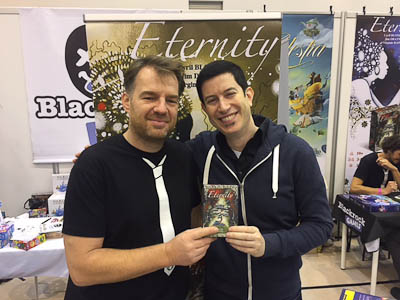 Another interesting game was Edenia, a so called sheep-racing game. In this game each player controls three sheep that want to find a way to the planet Edenia. I haven't played it yet, but with the lovely sheep and some funny moves the sheep can make, I can imagine that Edenia is a wonderful, entertaining family game. 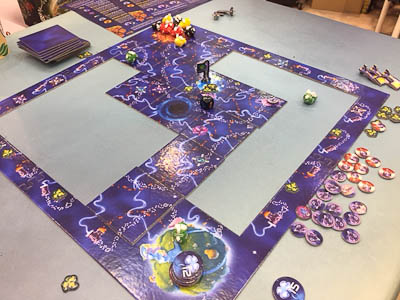 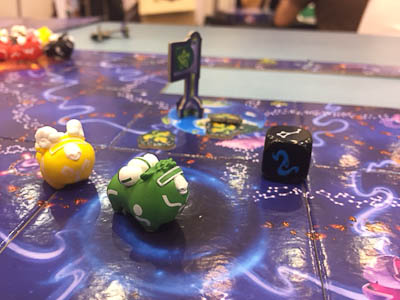 As a lot of other games by French publishers, all these games had outstanding artwork. There really have to be some great illustrators in France. So it was hard to decide which game to play. My son and I finally decided to playtest Bubblee Pop, so let us see how does it work: Playtesting Session: Bubblee Pop (Blam!, Booth: 3-O115)
If you are a child of Tetris, you should have no problem to get into the game? I came in contact with the computer game for the first time in the early 90s - some years before Frank began reviewing boardgames – during my final years at school. We started using the computer in maths and of course informatics at school at that time. And the pupils who had solved the tasks were allowed to start the game. Some of us were true masters and I only gaped at the speed they solved the geometrical puzzles. Bubblee Pop follows a similar game concept like the old computer game. Two players are sitting opposite each other and face a board with a an individual playing area in front of them and a neutral sky in the middle of the board. Both the player's zone as the neutral sky consists of bubble spaces in five rows. At the beginning of each turn the neutral sky is filled with coloured “Bubblees” (funny bubbles) randomly drawn from a bag. Two of these Bubblees can be activated by the active player, provided they are connected. Now these two bubbles are drawn towards the edge of your playing area, following the row until they are blocked by other Bubblees. 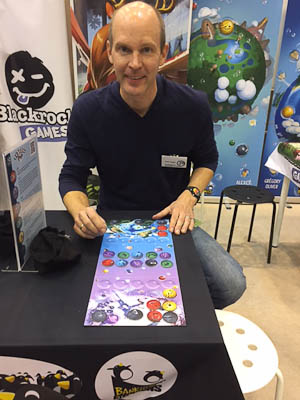 If after that 3 or more of same-coloured Bubblees are vertically or horizontally connected in your playing area, those Bubblees are – like in Tetris – removed from the board and placed in your scoring area. This can result in a chain reaction, because after that Bubblees on top of empty spaces are drawn towards you again and can also come into a position connected with more Bubblees of the same colour again. We saw something similar last year in Potion Explosion, but Bubblee Pop it feels more like the original game. 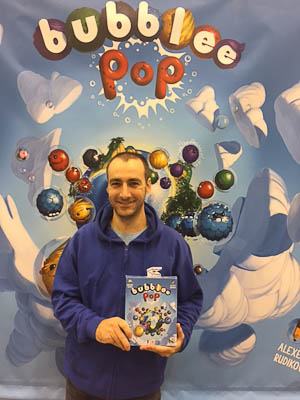 That is nearly all. Quite simple indeed, but if you like Tetris I recommend to try it. I personally loved the simple concept and the feelings the game evoked. And although simple, the game offers some tactical moves. This tactical elements can be extended by more or less black Bubblees that are placed in your playing area and cannot be removed. So some of the passages are blocked and it will become more difficult to connect other Bubblees. Moreover you can add special powers of each individual coloured Bubblee to the game. This power is triggered as soon as Bubblees are removed from your playing area and give the players some very useful actions. For example the yellow Bubblees let the player take one of his Bubblees into his scoring area directly. A new, interesting version of the old computer game, actually a version I will keep playing. I only hope you don't become hooked on it. Shortly after I met my old friends Marco and Lutz with their children and together we scanned the halls for some other children game. And indeed we were quite successful as you can see in the pictures. 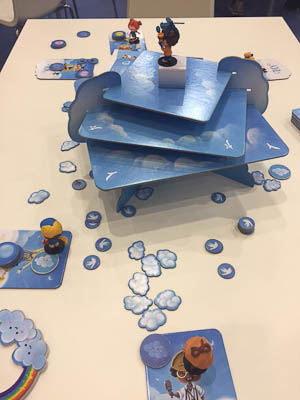 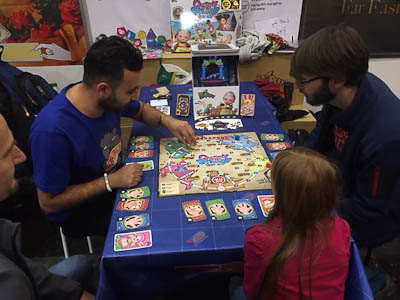 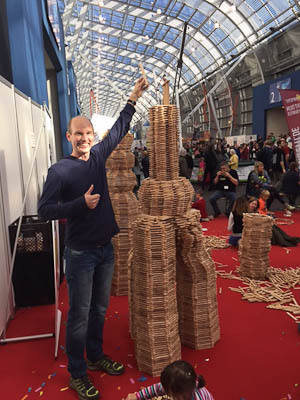 With the children playing with Kapla wood planks and while they were under Marco's und Lutz' watch, I quickly moved to two other halls, to have a look at two games about beer. As a home brewer meyself, I am always interested in this matter. The first game is called Brews of the world by HIP HOPS, an easy card game, that features 44 real beers of the world. 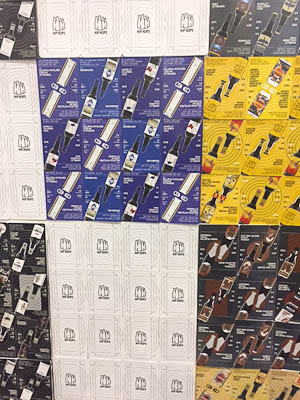 The other game I was heading for was a new variant of Tanto Cuore. I had a short introduction, so let us have a closer look: Overview: Tanto Cuore - Oktoberfest (Japanime Games: 1-A100)
Basically Tanto Cuore is a traditional Japanese deck-building game in the anime style. Most of the mechanics in the game we know from other deck-building games. Especially Dominion has a lot of similarities to the game. So you “buy” cards from a general supply to expand your deck. In Tanto Cuore you use lovepoints instead of money or gold for that, and instead of purchasing the cards you are employing new staff. But basically this new staff has stronger effects than your starting deck. Some cards like the event cards do not enter your deck, but are placed in a private quarter. There they stay in play and have various positive or negative effects to the owner. Another special card is a building card, that also does not enter your deck but generates victory points in the final scoring. Now the new sequel Oktoberfest is a stand-alone version of the game, that introduces beer cards (of course it is Oktoberfest) to the game. Those cards are sent to your private quarter, too and count as victory points. Also a lot of these cards has some effect to the owner of the card. They are not employed like staff, but can only be taken when one player played a bar maid or a beer stand. Moreover beer cards all have an alcohol level. Now there are two cards in the game that demand the players to count up their alcohol level. Depending on the card and your current alcohol level this can lead to a loss of beer cards again (if the player is too drunken) or to some other effects. 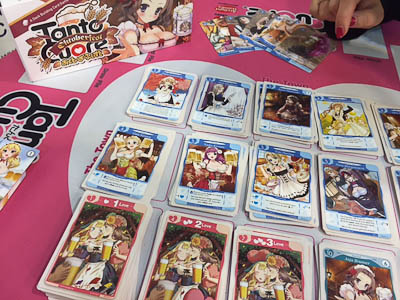 Tanto Cuore – Oktoberfest seems to be a solid deck-building game in the world of Tanto Cuore. It introduces a new beer deck that seems to influence the strategy to collect victory points. Compared to some other games by JAPANIME GAMES most maids are “sufficiently” clothed. I mean it is still Oktoberfest and the game uses anime style. But the illustrations are really great and the game itself seems to keep up with other successful deck-building games. Talking so much about beer had made me thirsty and so I decided it was time for a beer for the grown-ups and so I spent a bottle of ginger ale for the three of us. 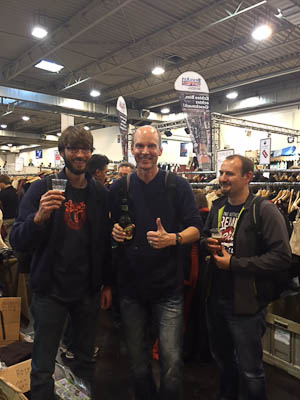 While my alcohol level was raising, I was encouraged to take up a risky challenge. I had heard that at GIOCHIX.IT a Virus was out of control and they were looking for volunteers who would go and look for an antidote. So let us see what I had to do: Introduction: Virus (Giochix.it: 1-C123)
Visiting the Italian publisher GIOCHIX.IT is an absolute must for me at SPIEL. I must confess that I am a fan of most of Michele Quondam's games, concerning both the artwork and the design of the rules. Over the years I have made the experience that it is sometimes not too easy to excite other players, because a lot of the games have a deep strategical approach and you need some turns to get familiar with the game concept. Still it is not difficult to learn the games. The clue is to internalise the symbols on cards and other game material that explain how an action is performed. And once I have managed to convince other players to have a try, they often share my enthusiasm. But when I heard that this year's Virus would have a real-time component, I was a little bit doubtful. Would that really work? And how on earth would they explain the rules at SPIEL. Wouldn't the players be overextended? Or has Michele designed a much lighter game than usual? The story of the game is a well known one. Somewhere in the world a military research project got beyond control and a deathly virus that turns people into zombies and monsters spreads out. There is only one chance: To get into the laboratory, find the patient zero and with this a virus antidote can be found. But we are running out of time. Only nine rounds in the game remain us to prevent the final outbreak. And of course, meanwhile all humans in this military laboratory are turned to creatures that know how to prevent us from reaching the antidote. 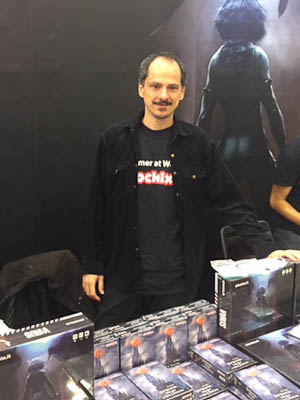 Virus begins with only a small part of the laboratory already visible to the players. All players start at the entrance with three room tiles adjacent. Over the game the laboratory is build up by the players from an individual player rooms display of eight or more rooms. So building up the laboratory is not completely random like in Escape by QUEEN GAMES. The players not only decide where they place a new room but also how the room looks like. But as this all is done in real-time and simultaneously, it is not always possible to find a direct room to the exit control rooms. Because the position of these two rooms are also fixed and determined by an exit deck card at the beginning of each game. And it is necessary to get to these rooms, before you can leave the laboratory again... A round consists of four different phases. It all begins with the drawing a new event card for the round that describes special effects that will influence the gameplay for this round. After that the main phase, the real-time phase begins. In this phase players can explore and move to new rooms that they add to the laboratory from their room display area. They can also search the rooms for finding new resources. They can place barriers in open doorways to prevent monsters to pass by (at least if the monster group is not too strong to break the barrier). They can open breaches in walls they would initially stop them. Of course they can also open and close doors that is quite useful as it prevents monster groups seeing you and so they perhaps do not move in your direction. You can even place explosives that will explode in the room in the next real time phase of the following round, damaging everyone who is in the room at this moment. Finally you can activate special rooms as the exit control rooms, the first aid, a net and an ammo room to trigger the associated action. And last but not least you also fight against monsters in this phase 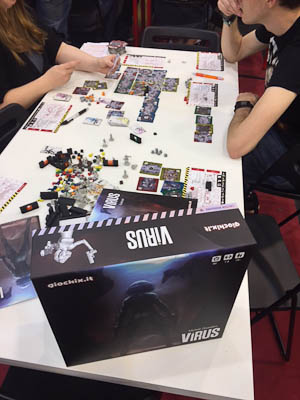 As you can see there is indeed a lot to discover in this phase. And remember that everything has to do simultaneously and in real-time. This is not only a time full of activity, it is pure adrenalin. No time to think about what you are doing, because this phase – depending on the difficult level and the number of players – lasts only 35-60 seconds!!! After this really short period, a breathing pause is doing good (and restoring health, too). Luckily enough what follows is the slow phase. In this phase you can take your own sweet time to move all creatures. But before that, all monsters involved in a combat make one last final attack. Hopefully that did not kill you, because after that the survivor could be faced with new horror: Comparable with Zombicide all monsters are drawn towards the heroes. Either they see or hear you (both we already know from Zombicide), additionally monsters also sniff you in this game, making monster movement more variable and more difficult to foresee in the frantic real-time phase. And finally new creatures enter the laboratory, not at spawn points, but directly influenced by the actions the players had performed in the phase before. 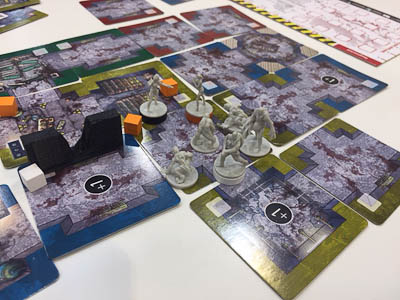 A round of Virus ends with a turn end phase in which players suffer wounds, gain and may spend new resources to equip them for later rounds and do recover. There are some cool tokens and cubes to buy in this phase like bullets, explosives and shields for the fightings. Also players must equip with barriers and doors in this phase, if they want to place them in the next real-time phase. Adrenaline, heart and four-leaf tokens complete the picture of the many options you have in the game. Maybe Virus could best be explained as a mixture between Zombicide and Escape. All that combined with the typical complexity and extensive use of symbols we know from other games by GIOCHIX.IT. The real-time phase is really frantic. It is extremely important to know your options, because even 60 seconds is very short for all the different actions. The combat alone, which is carried out by rolling dice, takes a good while of your precious time. And so it probably is often better to prevent fighting and using barriers and doors instead to find the antidote and leave the laboratory again. Virus seems to be an excellent game again, but difficult to master and much more complex than the two other games I mentioned before. Beer and viruses, I had nearly forgotten that it is child's day. So we better change the category of games again. 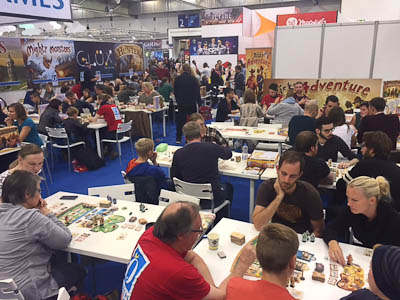 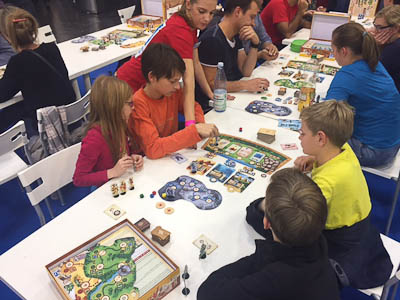 Playtesting: IceCool (Brain Games: 1-F139)
In the newsshow on Wednesday I was invited to flick a small penguin through several chambers of a small icy three-dimensional flat. So I referred to this offer and visited the booth of Brain Games with the children. In the game one player acts a catcher who has to capture all other players by flicking his penguin and touching other player's penguins. If the catcher is successful, he takes an ID card from the player that gives him victory points at the end of the round. The other players are runners who have to collect their fishes in form of clothes-pegs above the doors. If a runner successfully flicks his penguin through a door, he may take his associated clothes-peg. It is the aim of every runner to collect his three clothes-pegs. 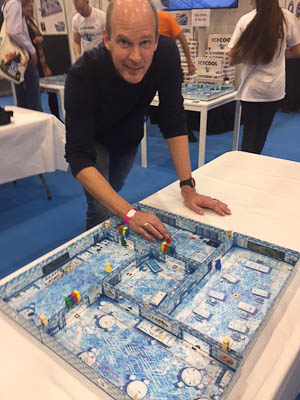 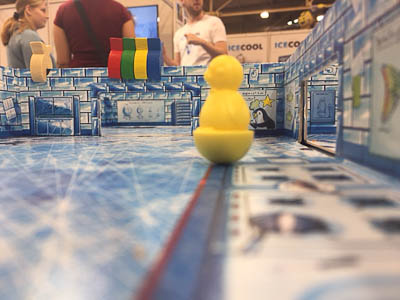 Flicking turned out to be tricky. Well, of course it is easy to just move your penguin. But if you want to be successful you must be fast and you must prevent the catcher to touch you. The staff at the booth demonstrated some amazing moves. It is allowed to jump over the walls and the penguins can also make curves. I probably will need some more praxis for this, but the kids already had much fun. IceCool has just won the UK Games Expo for the best children's game, so I will try it with my children in the next weeks again and again. My goal is to collect all of my clothes-pegs with a single flick. And with this last game for today I am leaving you for this year. This if the official end of our report of SPIEL '16. I hope you enjoyed reading. I hope we have given you a broad overview of this mass of new games. I better get some sleep now, so let's keep it short: 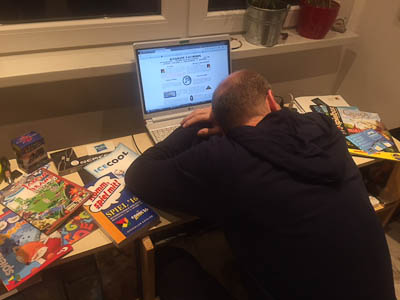  |
The SPIEL '16 Games Convention - Day 3
I cannot believe it's already saturday. Just one week ago I was doing some final preparatory work here at the website, and now three of four SPIEL days are already over. For me it was a grand day at the show, and so brace yourselves for some surprises in today's report! But enough of these introductory words - let's get down to (games-)business!

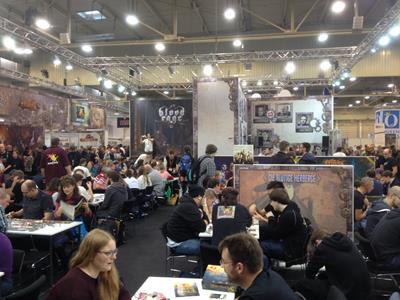
For today's start I decided to make another trip to Greece, or better to the second Greek company here at the SPIEL - DESYLLAS GAMES from Athens. I had scheduled a meeting with product manager Michael Kanellos, and together we sat down in the back office of the booth.
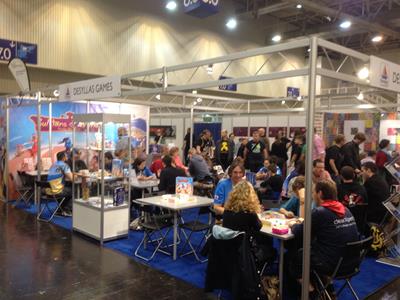
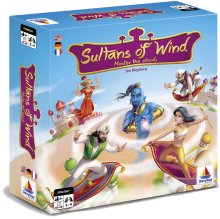
After last year's successful debut at the SPIEL convention with Vangelis Bagiartakis' pirate placement game Oath of the Brotherhood, Greek publisher DESYLLAS GAMES seems to be gearing up since the game actually was successfully licenses to a number of countries and will be published worldwide by AEG in 2017. This year they have returned to the convention with another boardgame, and in Sultans of Wind the players assume the role of flying carpet riders who want to win a race through a maze of clouds controlled by the Sultan's Djinn.
Standing in the tradition of programming games like Roborally, Sultans of Wind by Jan Meyberg challenges the players to plan ahead in order to be the first to move their small fleets of carpet pawns through the cloud maze to the opposite side of the gameboard. However, whereas the aforementioned Roborally needs really careful planning in order to avoid fatal mistakes, the programming factor in Sultans of Wind is much lighter, qualifying the game as a normal family game.
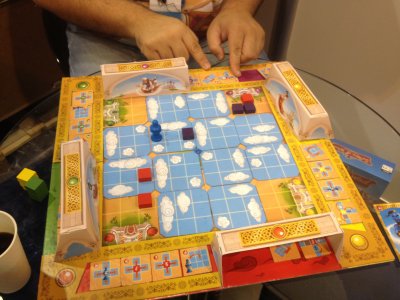
Indeed, each player possesses an identical set of 8 different Wind tiles, and whereas some of these tiles allow the simple movement of a carpet for a certain number of spaces, other tiles allow the changing or reorientation of Cloud tiles (making up the cloud maze) or a movement of the Sultan's Djinn. The players chose these Wind tiles in order to perform actions, and as can be guessed the movement action is most straightforward since it simply allows the movement of a Carpet pawn. Things get more tricky when it comes to the Wind tiles which allow a manipulation of cloud tiles, since these actions will not only apply to the tiles themselves but also to all Carpet pawns located on those tiles. So, such an action often will result in the relocation of one or more carpets, and so a player may gain or lose ground accordingly. Moving the Djinn also can be a very powerful action, since the presence of the Djinn in the vicinity of a carpet will allow the owner of the carpet to play three instead of two Wind tiles during his turn, and as can be guessed the playing of a third tile can be a big advantage.
So far Sultans of Wind may not sound so different from other maze games, but at this point some light also should be shedded on the somewhat unusual programming mechanism used in the game. With only eight Wind tiles available, traditional approaches either would have been to a give a player a free choice of his Wind tiles each turn, or to require the player to use up all of his tiles before all of them become available again. However, Jan Meyberg went a different way here, assigning each player a "Wind Channel" at their side of the gameboard. In this channel all eigth Wind tiles of the player will be placed face-up in a straight row, but only the 4 tiles at the beginning of the row will be visible to the opposing players. The other 4 tiles at the end of the row are covered by a player screen, and the players always will chose their two tiles for the upcoming action phase from the four tiles behind the screen.
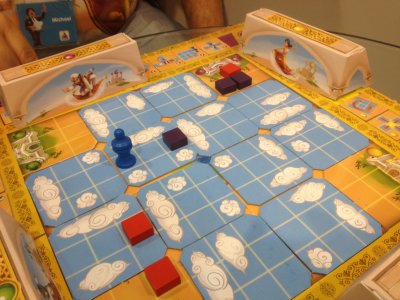
In this respect the screen serves two purposes. On the one hand it leaves the other players with limited information which tiles possibly will be played by an opponent, and on the other hand a player always can chose from 4 different tiles, allowing him to save a particular tile over several rounds by playing other tiles. All used tiles will be returned to the beginning of each player's Wind Channel by the end of the action phase, and so they come back into play with a slight delay because they first need to move forwards in the channel to become available again.
If played with a full cast of four players, Sultans of Wind certainly does not offer the same strategic depth as Oath of the Brotherhood, but nonetheless the game offers a charming variant of a comparatively easy programming mechanism which should appeal especially to families and occasional players. Whereas I have already mentioned that other programming games can be really frustrating, Sultans of Wind plays much lighter, and by interfering actions of several players even the leading player will not get into a position where he cannot be overtaken anymore. So, the players have to balance their actions between doing something beneficial for their carpets or detrimental to other players, and most effective will be the actions who succeed in both aims. However, a few words also need to be said on but today's head-to-head duel with Michael. This game turned into a rather interesting strategic match, with both Michael and me trying to get our carpets right through the middle of the maze, and so the strategic potential is certainly higher with just two players. In summary, Sultans of Wind is a nice lightfooted filler game with a comparatively low element of luck!
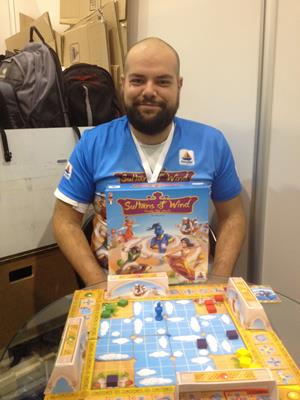
The second game which I wanted to check out here at DESYLLAS actually is a creation of Nikos Chondropoulos who is just now working at the booth of ARTIPIA GAMES. I had promised him to take a look at the game, and so I launched another playtesting session with Michael after our wild carpet ride.
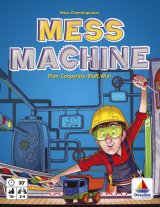
Nikos' game Mess Machine challenges the players to get a 4x4 tiles puzzle into the correct order, but for doing so the players actually have to take actions on a "machine" which can only perform certain types of movements to the tiles. Buttons A and B of this machine allow a horizontal exchange of two tiles in a row, whereas buttons C and D allow and exchange of two tiles in a column. However, as indicated it is not possible to exchange any tiles in the same row/column, but actually only specific changes can be made: 1st tile for 3rd tile, 2nd tile for 4th tile, 1st tile for 2nd tile, or 3rd tile for 4th tile.
Due to these restrictions is becomes quite difficult to get the 16 tiles of the puzzle in order, and the players have to manipulate the buttons quite a few times until the puzzle is finished. However, this is only the core mechanism on which the game operates, since the really tricky part actually is the question which players will push which buttons. Before the game starts, the players secretly will place a bet on two of the four buttons, and one of these bets will be which button the player intends to push most often, whereas the other bet will be on the button which the other player should push most often.
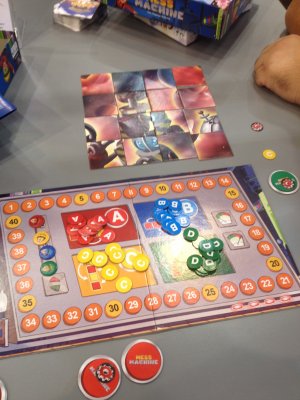
To keep track of this process, the players take a fitting button marker for each of their actions, and at the end of the game the player's bets will be revealed. Each marker which the player has collected for the bet on his own actions will count for one victory point, whereas each marker which the other player has taken from the button on which the player has bet will count for two victory points.
So, the players will not just have to focus on the question how to solve the puzzle, but they actually have to try to manipulate the Puzzle tiles in a way as to make the other player use the button on which a bet has been made. This can be reached through "well meant" advice as well is by changing tile positions on the gameboard, and at the same time a player also has to speculate which bet possibly has been made against him on order to aboid giving the other player a high amount of victory points. Furthermore, additional points also can be collected by getting Puzzle tiles into the right position, and in the end the player with most points will have won.
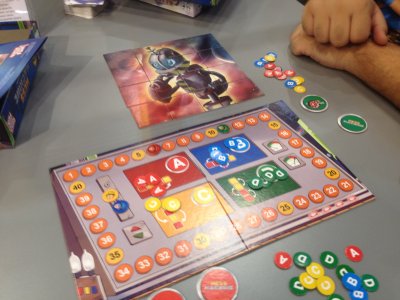
Mess machine actually turned out to be a puzzle with a certain twist. The movement mechanism for the puzzle tiles plus the associated bets which have been placed by the players force the players to look at the puzzle in a quite different way. Doing the one right move is not always the right thing to do, and so the players need to interpret the signs which can be found in the other player's actions. So, in our test game Michael althogether avoided using one of the four buttons, and this certainly is an indicator of a bet which has been placed on the use of that button.
To my mind, this logic exercise poses a nice challenge for players who want to test a game off side the usual mainstream boardgames, and players with a liking for logic puzzles certainly will love the game. Well done Nikos - congratulations on your debut game!
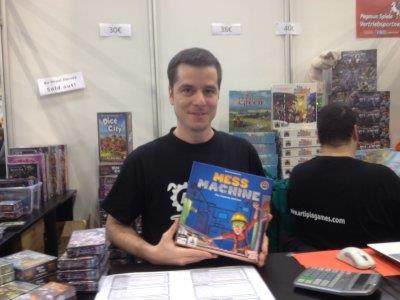
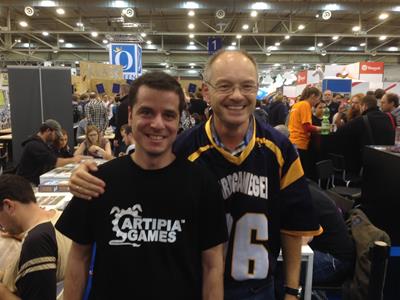
After last year's debut at the SPIEL, DESYLLAS GAMES certainly has returned with a second wave of nice games. I have chatted with Michael on the situation of the games scene in Greece, and he admitted that gaming is not yet a well-known pass time activity for many families and friends. Of course traditional boardgames are known quite well in Greece, and there is certainly a high popularity especially of Backgammon in many a Greek Kafenion. However, this general liking for gaming has not yet reached modern boardgames, and so companies like DESYLLAS GAMES or ARTIPIA GAMES still have to do a lot of grassroots work.
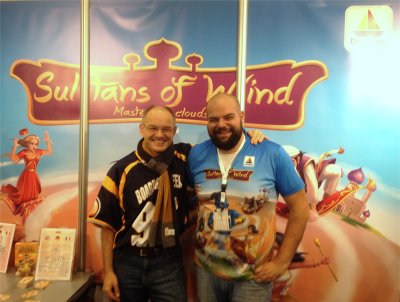
Next hall, next game, and so I made my way over into Hall 3, visiting for the third and final time the booth of LAUTAPELIT.FI where I was waited expected for yet another playtesting of one of their new games. This time designer Mikko Punakallio was awaiting me, and together we had a look at his new game Dokmus.
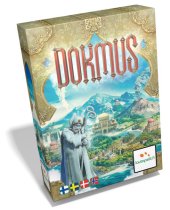
As Mikko told me, the idea for this game actually is based on a classical slider puzzle toy. However, instead of moving puzzle pieces in Dokmus whole landscape tiles will be moved, allowing the players to realign the outlay of the playing area during the game in order to best suit their strategies.
However, let's begin this with the game's aim. The player will try to collect victor y points by placing their pawns on the landscape tiles, and at the end of the game points will be awarded for each pawn which has been placed on ancient ruins or next to a simple or an advanced temple. However, the pawns cannot be placed everywhere on the landscape tiles, but the rule must be obeyed that a new pawn only can be placed next to another of the player's pawns. There are certain exeptions allowing for a placement over water or on the other side of a temple, but in general the placement rules are rather strict, and that's where the sliding of the landscape tiles becomes important.
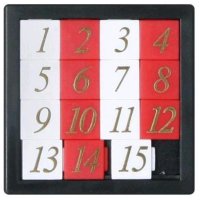
At the beginning of each round each player will have to chose an Action tile, and these tiles allow for the sliding of a landscape tile, the truning of a landscape tile or even for a one step movement of one of the player's pawns. Following the order of the chosen Action tiles, the players then perform their action phase, and in this phase they have to place three of their pawns. Before, in the middle or after placing their pawns they will also perform the action on their chosen Action tile, and this actually will change the outlay of the playing areas in a way as to allow placements which would not have been possible before. So, the players must keep a keen eye on the possible use of their action tiles, since these may give them access to landscape tiles which otherwise would have been too remote to reach.
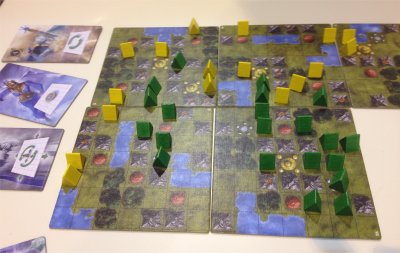
The scoring options in Dokmus do not just focus on being in the vicinity of the aforementioned buildings, but in addition the players will get bonus points if they actually manage to have one of their pawns adjacent to every building on one landscape tile, and bonus points also will be awarded for being present at as many landscape tiles as possible. Apart from an unfavorable outlay of the landscape tiles some additional rules for pawn placement also hinder the players (no placement on mountains, extra costs for crossing water or entering a forest), and so the players really have to plan and plot a way to get as many points as possible.
Playing a two-player game with Mikko, Dokmus turned out to be a real brain twister, keeping me thinking about the best scoring options while at the same time keeping an eye for Mikko's own moves. With two players the playing area is downsized to only 5 landscape tiles, and this certainly causes a high degree of competition between the players.
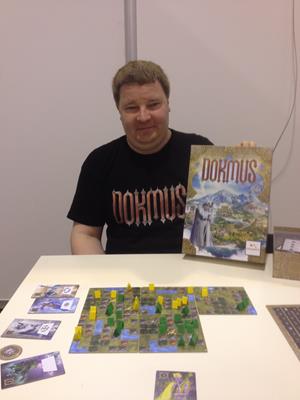
With a bit of free time on my schedule, I decided to visit Ignacy's booth of PORTAL GAMES, and here I could listen in to an explanation of the new game Cry Havoc which I also watched for a few turns.
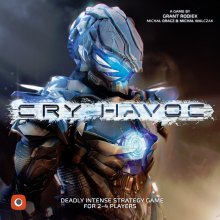
In military language the order "Havoc!" was a signal given to the English military forces in the Middle Ages to direct the soldiery to pillage and chaos, and the term Cry Havoc actually is a quote from Shakespear's Julius Caesar, taken from a longer speech of Marc Anthony: "cry havoc, and let slip the dogs of war". Indeed, the name of Micha? Oracz's new boardgame couldn't have been more fitting, since the science fiction boardgame for 2 to 4 players focuses on a bloody conflict in which different kinds of invaders want to rob a newly found planet of its resources. However, the planet is inhabited by an indigenous species, and whereas a 2 or 3 player game sees the planet's defenders only as an obstacle, in a 4 player game a player will take the part of the so-called Trogs in order to thwart the invaders.
Over a maximum of 5 rounds the players send their troops to gain control of the different regions of the planet, always trying to get control over the regions with most crystal deposits, since each of these deposits will count for victory points when a scoring should be enabled. Recruitment and movement of troops and the building of Structures (weapons and other gadgets) is done through the use of Tactics cards from a player's hand, and each Tactics card in a player's deck will list different amounts of these three kinds of action points. If a card is played, only one type of action can be performed, and so only one kind of action points will be used. However, apart from containing the aforementioned action point allowances, each card also offers a tactic or special bonus, and so a player has to decide whether he wants to use the card for an action or for its bonus.
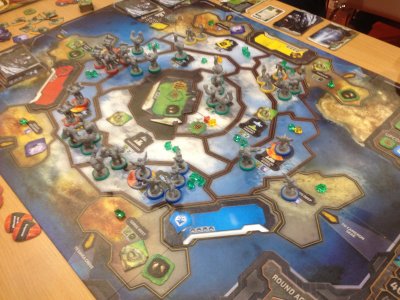
At this point it should be mentioned that the decks of Tactics cards and therefore the available strategies for each invader faction and the Trogs are quite different, thus making Cry Havoc an asymmetric game in which the players have to employ quite different strategies for managing their factions. Apart from the card decks, the factions also differ in the number and functions of available Structures, and they also possess different skills which can lead to rather different tactical approaches in unit placement as well as battle.
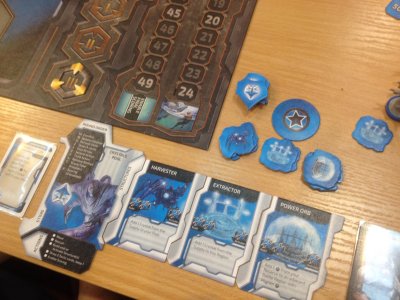
Talking about battle, the design team around Micha? Oracz has found an interesting way for battle resolution, giving the opposing players different objectives to which they can assign their forces in a battle for gaining dominance over a region. The three different battle objectives are
When a battle occurs, it will be first the attacker and then the defender who distributes his units from the region on the gameboard into the different Battle Objective boxes on the Battle board, and when all units have been placed the battle will proceed into the next phase, the playing of Tactics cards. Here now the different tactical approaches which are reflected in each faction's Tactics deck come to bear, since the cards played can lead to a major change of the situation on the Battle board. Thus, by clever employment of the attacker's Tactics card the initial advantage of the defender to place has units last can be mitigated, and on the other hand the defender can try to counter a surprising outflank maneuver of the attacker with a good Tactics card of his own.
Only when the opposing players have finished playing Tactics cards the battle resolution will take place, and now the battle objectives will be dealt with in the aforementioned order. So, the first objective to be solved will be Region Control, and the player with most units on that objective will be assigned two Victory Points and he will be allowed to place his surviving units back into the contested region on the gameboard, whereas the looser of that objective will have to retreat his surviving units into a neighbouring region.
The next Objective will be the capturing of prisoners, and here the player with more units on the objective is allowed to take one of the other player's units from the Battle board and places it in front of himself. This unit may come from any Objective slot (even from Attrition, thus weakening the position of the opposing player on the final objective), and the prisoners also are worth Victory Points since the captured units must be redeemed by their owners.
The final objective - Attrition - is pure slaughter with each player killing as many opposing units as there are units placed on that objective. This may actually lead to the emptying of the whole region, but since Region Control already has been determined the region will not fall back to uncontrolled. Finally, each killed unit also is worth one Victory Point.
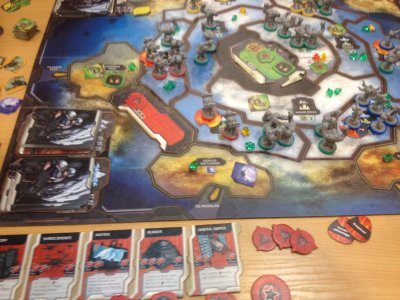
Apart from the special appeal which comes from the different playing approaches which can be found in asymmetric games, it is especially the battle system which gives Cry Havoc a quite unique feeling. Many games resort to simple dice rolling to resolve battles, but in this game you will find a quite honorable approach in designing a battle system which actually leaves the players some room for tactics and making decisions. Each placement of a unit on the Battle board is triggering an effect, and so the winning of Region Control may possible thwart an attacker, but the price for this may be high if the attacker has chosen to decimate the defending units through Attrition. Many constellations are possible, and the results may also be influenced through Tactics cards and the presence of Structures, and all together makes Cry Havoc a quite sophisticated representative of the category of area control games.
For my next playtesting session I wanted to visit the booth of KOSMOS in order to see whether I could board a time machine which could take me back all the way to ancient Egypt. However, the Flux Capacitor in my DeLorean must have been slightly damaged, since my first try at time travelling actually just took me back through the last 20 years. I had my camera with me in order to document my arrival at these different epochs, and you can see the shocking results below…
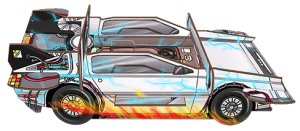
As I have told you earlier this week, my first visit to the SPIEL had been in 1985, but my game reviewing activities started while I was at university. So, there exist no pictures from my childhood visits to the SPIEL, but back in 1998 I had been able to borrow a very simple digital camera from a lawyer where I had made an internship. This camera had the tremendous resolution of 320 to 240 pixels, and for the first time it allowed me to provide some images directly from the SPIEL. During the days I had to be really careful not to spoil any picture, since the camera only had memory to store 8 (!!!) photos and there was no possibility to check or delete single pictures. Only the full fillm could be transferred or deleted, and so I had to choose the motives for my pictures very carefully. However, it was not only games which have been on the photos, but looking through my old reports I also found some quite shocking photos of myself…


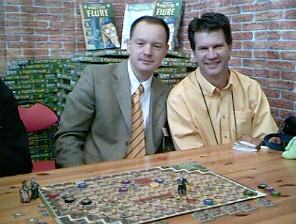
![[image]](../essen01/mess0139.jpg)
![[IMAGE]](../essen98/grouphig.jpg)
Wow, that's where the last 20 years have gone! It was somewhat spooky for me to see all these old pictures in my reports, and I cannot even imagine how it may feel in 5 years when I (hopefully) will be able to announce that this website has been in operation for a quarter of a century. But well, that's still a long way ahead, and for now let's better go Back to the Future!!!
Okay, not really. I made my way over to the KOSMOS booth, and indeed I was lucky to get a free space at a table where Imhotep was set up. So, I got my trip to Egypt after all…
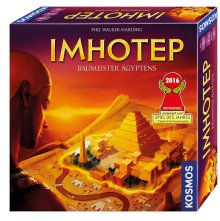
In the times of the humble beginnings of worker placement and resource management games these games did not contain meeples or fittingly shaped wooden resource tokens, but instead the main playing components of these games were small wooden cubes of different colours. When I think back of those days I remember not only the games, but also the player activities of the non-active players. Especially games with long player phases did not only challenge the non-active players to think about their strategies, but the time needed by a particularly slow player to finish his turn was often spent with building activities of the non-active players, using the wooden cubes to construct all kinds of micro-buildings like pyramids, columns, etc…
Game designer Phil Walker-Harding must have experienced those times as well, and now - years after the replacement of the wooden cubes by fancy wooden playing pieces of all shapes - he has finally initiated the return of the cubes! Named after the great Egyptian architect Imhotep (no, not the mad priest known from the movie "The Mummy"), the new KOSMOS game Imhotep invites the players to use their cubes for their most common purpose: for building pyramids, temples, tombs and obelisks.
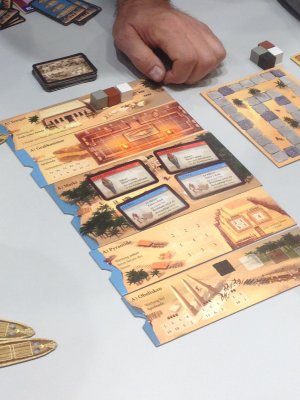
Indeed, during a total duration of six rounds the players try to make the most prestigious contributions to a number of buildings which are constructed to reflect the glory of the Pharao, and depending on the placement of the players' cubes at the different construction sites they will score Prestige points either during or at the end of the game. For each of the four different construction sites exists a small separate gameboard, and the gameboard shows both the places where cubes can be placed and the values for placing a cube at a particular place. Some of the buildings like the pyramids or the temple can be build to a height of more than one level, and for each of the buildings exists a unique scoring system and placement rules. So, each cube in a pyramid will score a fixed value, whereas cubes used for building the temple only score points when they are placed on the top level of the temple. On the other hand, in the tomb the players will score for connected areas of cubes, whereas the obelisks will be judged on their height at the end of the game.
This cute idea of using cubes for the construction of micro buildings has been embedded into a nifty set of rules which requires the players to get cubes from the quarries at the Upper Nile, place them onto barges which will go down the river, and dock these barges to the different building sites where the cubes will be unloaded. Quite essential here is the fact that a barge will be unloaded in a fixed order from box to stern, and so the slots at which the cubes have been placed onto barges will essentially decide where the cubes will be placed at a specific building site. However, each player only can spend one single action during his turn, and so he may either get new cubes from the quarry to his stocks, place a cube from his stocks at one of the barges, or dock a barge which has received a minimum number of cubes at one of the construction sites, just triggering an unloading and placement of all cubes.
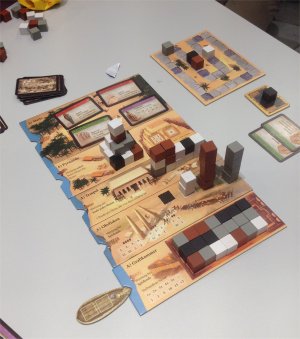
As can be seen at this point, Imhotep runs on a system of deferred availabilities, and so the players need a good knack for timing issues in order to plan a successful placement of their cubes. Due to the different types of scoring options associated with each building a successful player has not only to look for the most prestigious places where his cubes might be placed, but he has also to keep in mind that cubes placed on a barge will be unloaded and placed in a fixed order, and ultimately another player may even send a barge to a different building site. So, a good eye for placements which might help at more than one building site, and also a good intuition for the right time to send a boat to a construction site are essential.
To spice things up, a fifth gameboard exists where a barge can be sent as well, but instead of placing cubes at a construction site the players who unload their stones here are allowed to buy special Action cards from a market. These Action cards show a range of game-changing actions like additional scorings, instant cube placements or double actions, and so the players can include the cards they have acquired in their strategies, trying to increase the efficiency of an action by the use of the cards they have acquired. As a reviewer I always look at such special action cards with special attention, since options which allow a circumvention of the standard mechanisms can be big spoilers if these options have not been balanced quite carefully. However, as far as I could discover the Market cards in Imhotep fit in quite well with the main playing mechanisms, allowing for some surprises but not giving a player too much power to overturn the game in just one action. Test passed!
In summary, Imhotep presents itself as a quite charming family game with a certain twist. The rules certainly contain some degree of innovation, and both the deferred placement mechanism and the usage of cubes for constructing micro buildings are quite appealing from my perspective. Certainly a game which needs to be looked at!
After this playtesting session it was already afternoon, and I walked the five minutes home for a quick lunch. So, let's once again check what Ralf has been doing today!
|
Hi there and welcome back to just another crazy day at SPIEL. With the beginning weekend this day traditionally is a family day. As a result especially halls 1 and 3 with the big publishers were extremely crowded in the morning. That's why I started my tour in the new halls 4, 6 and 7 where I scanned the one or other booth for some hidden gems. 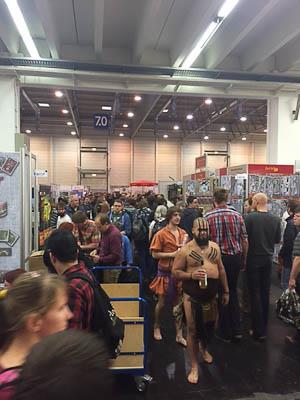 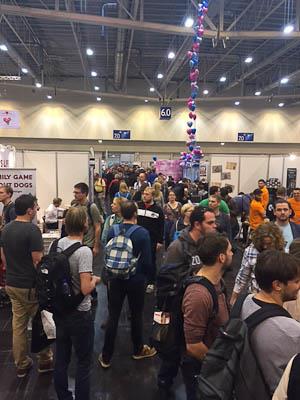 Finally I arranged another demo meeting for the afternoon. But before that I still had some other arrangements in hall 1 and 3 and so I started my day at WHITE WIZARD GAMES. Playtesting Session: Hero Realms (White Wizard Games, Booth: 1-G140)
Last year I had the chance to meet Rob Dougherty, one of the Magic the gathering Pro Tour Champions. As a champion, he will probably know exactly how a good deck building game works. But Rob not only plays the games, he is also one of the lead designers of the WHITE WIZARD GAMES team. In this function he explained Epic to me at SPIEL 2015, a great deck building game in a small box. I really loved that game, but I was also curious about the far more successful Star Realms game by the same publisher and a similar design team. So, when I heard that WHITE WIZARD GAMES is releasing Hero Realms, that uses the same engine as Star Realms, I at once wrote an email to schedule a demo meeting. And so I am sitting here now, facing Rob once more, and playing against a real champion. As last year his way to shuffle the cards (he must have done this over and over again) is really amazing. Faster than my eyes can see... But back to the game: Basically as it uses the same engine, the game is very similar to Star Realms. So if you know the older game, you can begin immediately with Hero Realms, too. So you begin your personal deck with only few equipment: a short sword, a dagger, a ruby and seven gold, again ten cards. But with a little bit more variety (compared with eight scout and two viper cards in Star Realms...). But of course you have to use the money to buy new cards from the market. The market is build by revealing five cards from a shuffled market deck and every time a card is taken from this market, a new card is placed there again from the supply. Next to these randomly drawn market cards, there is a general supply of 16 fire gem cards, cards with a higher value than the starting gold cards, so that they are quite useful, especially at the beginning of the game. Each card has its own costs, a faction that is important for the an ally ability, a primary ability, that is applied when played and the ally ability, that is only carried out, when another card of the same faction was played in the turn of the player. 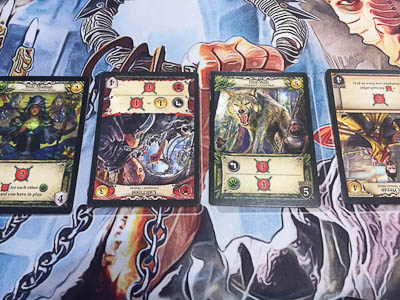 The game follows the typical pattern of a light deckbuilding game. Each player starts with a hand of five cards and all of this cards are played in a turn. Then all primary and ally (if possible) abilities of the cards can be used by the players. Some cards let you draw more cards from your draw pile, some forces your opponent to discard a card from his hand and others let you scrap cards from your hand or your discard pile. This indeed is quite useful, because with progressing time, your starting cards will be less effective and so it is better to get rid of them (well it is a deck building game, so all of your discarded cards will find a way back into your hand until you scrap them...). The most important ability of a card is to attack your opponents. To attack you sum up all of your attacking points from the cards you have played this turn and lower the health of the attacked player by this amount. It is the aim of the game to be the last standing hero, so all heroes that with no health remaining are immediately out of the game. Finally a lot of cards give you money to acquire new cards from the market. Of course new cards do not enter your playing area directly, but go to your discard pile first (unless a card says something else). So only if your draw pile is empty (each turn you draw a new hand of five), you shuffle the discard pile and by this new cards come into play. 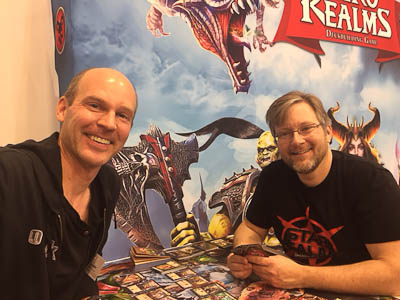 That all will not surprise you, if you know other deckbuilding games. But what makes this game exceptional are the champions (comparable with the bases in Star Realms). This cards come into play as all other cards, but in contrast to the normal cards these cards stay in play, until they are defeated by other players. Some of these champions even act as guards, so that your hero cannot be attacked directly, but the champion must be overcome first. Despite or perhaps because of its simplicity, Hero Realms seems to have an enormous appeal with the people. About 20 tables were fully occupied the whole time I was at the booth. Compared with Star Realms up to now there is not really anything new. But Rob explained that there will be more variants and expansions to come. It will start with heroe characters who will have individual starter decks. 'With this not only the starter cards will change, you will also have different health points and special abilities. But still everybody will expand his deck from the general supply. Later in 2017 we will also have campaigns, in which you will improve your characters from game to game. Anyway Hero Realms seems to continue the great success of White Wizard deckbuilding games. After this successful start, it was time for lunch and I had a coffee and a bread roll in the gallery. Drinking my coffee I got into conversation with two guys at my age from London. It turned out that they were part of a smaller group who comes to SPIEL year after year. All guys of the group are employees of the same company and twice a month they meet for playing games. They already had bought the one or other game and so they are equipped for another year of playing. I think that is a great way to practise your hobby. Others go for a golf tour or a fishing trip without their family, but only with their friends once a year, and we gamers go for SPIEL. Speaking of colleagues I met two friends of mine after lunch and together we rushed straight through the halls to meet Roberto di Meglio at ARES GAMES. 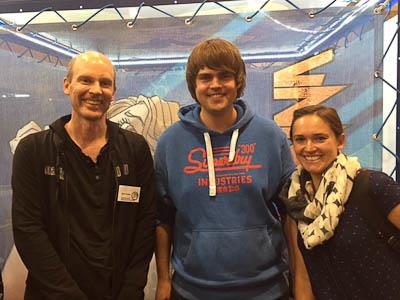 Playtesting Session: Last Friday (Ares Games, Booth: 3-E100)
Since my older son goes to school, I go for camping during the summer holidays. On the one hand I can't get used to the much higher prices for flights, accommodations and everything else during the school holidays, on the other hand my children love being outdoor, too. It is always an adventure to sleep, cook and eat in the nature. And it is especially adventurous, if the camp is not too crowded, so you hear birds and other animals and are not disturbed by snorting from other tents during the night. But imagine a camp in which an undead maniac walks abroad. That is exactly the story of Last Friday. Five friends are sent as counsellors to a Camp Apache to prepare it for the summer. Some time ago a multiple murderer was drawn into a lake under mysterious circumstances. And now the locals tell story that he or his ghost is wandering around and looking for new victims. But of course these are only rumours, at least our five friends do not know anything about it. In the game one player takes the role of the maniac and the five counsellors are distributed among the other players. It is not necessary to play the game with six people (although that is possible), but one or more players can take the role of several counsellors, playing each one individually. It is the maniac's task to kill other players by just walking over spaces occupied by the players. And it is all other player's task to prevent this and to find and hunt the maniac. What seems to be simple, turns out to be a difficult task, because – similar to Scotland Yard - the maniac moves hidden. He only has to reveal his position every third turn, the rest of the time he writes down where he is going behind a screen. 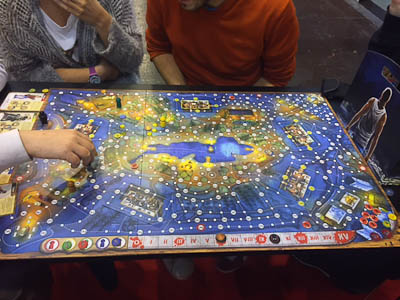 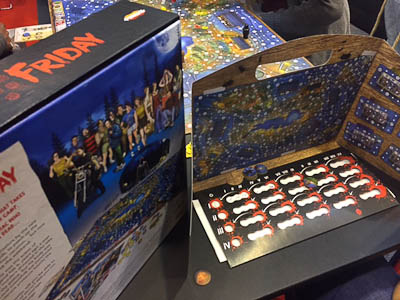 The board gives us the outlines of the camp and the nearby lake with many bigger and smaller white dots. The bigger dots are the moving spaces for the maniac, each one with a number, so that the maniac can write down his moves. The smaller ones are used for the movements of the characters and also to drop hints like clue and key tokens as well as discard corpses the maniac has killed. Every time a character passes the position of the maniac or vice versa, the character is killed until the end of the chapter. But the players have some equipment they can find under the clue tokens to be well prepared. The game is divided into four chapters, each of it with an individual set-up and different goals for the maniac and the campers. In the first chapter the campers are ill prepared (they expect a peaceful holiday) and only try to run and hide from the maniac. But that changes in the next chapters and soon the maniac is the persecute... The different clues like a lantern to lighten the surroundings of a camper or a bear trap to block the movement of the maniac give the game a lot of variety. Also there are different movements over the lake that only the maniac or the campers can use. And finally each camper has his or her special ability to alter the rules. 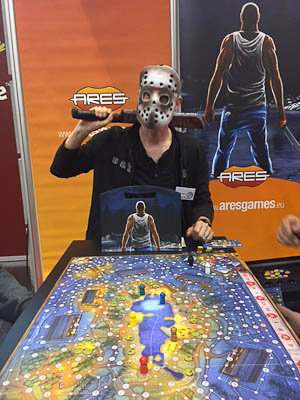 Playing Last Friday felt a little bit like a mixture between Scotland Yard and Mr. Jack. It expands the variety and brings the move and hide principle to a greater board. But it did not feel like you could hide your character in a corner and just wait for the end of the chapter. The possible ways to cross the lake for both parties are too strong for this strategy. Moreover you have your goals in each chapter and you cannot reach it by just hiding. Especially the five cabins scattered over the camp play a major role in each chapter. I loved the idea of changing goals in every chapter. It is not just the new goal that gives the variety but also the changing of the roles as hunter and hunted over the chapters. I loved the game and would like to play it again. As I already told you, this morning I had a walk through hall and here I found a new wooden game from Germany that aroused a great deal of interest. So I decided that one of the G@mebox crew should have a look at it and so here we are: Playtesting Session: Ninja Arena (2mt Games, Booth: 4-B130)
Ninja Arena is a game, completely produced in Germany and it uses only natural materials. So you don't find any plastic minis in the box. Instead you find a rotating wooden board, some wooden blocks and good old pewter figures. The wooden board is divided into a 8x8 grid and as a set-up we place those wooden blocks onto to the board. You can freely choose where to place the blocks, but only two blocks must be piled up. Of course there are also suggestions to use in the rules. In the end you have three different levels: level 0 without any wooden blocks, level 1 with one block and level two with two blocks piled. Then every player gets a screen to plan his actions for the round hidden from the other players. Of course each player gets his ninja. In the basic version we played today every character has the same powers, but in the advanced game the characters differ in strength and equipment. Our equipment for today was just a sword for melee attacks and some throwing stars for ranged combat. Finally we received two red, two blue and one white dice. The white dice was a standard one, that is used to indicate how much ammo you have left with a weapon. The other two were six-sided dice with an action symbol on each side. Oliver Schneider, the designer of the game, taught us the rules and explained us the symbols in detail. As each ninja is starting from a different edge of the game, the most important one for the start is the moving ability. There are different kinds to move in the game. The simplest one is to move one step further. But you can also for example roll two fields, do a diagonal move or leap over a gap, that is quite useful to jump for example a level 2 block to another level 2 block two steps away. Last but not least you have the level movement that allows you to climb or go down one level. 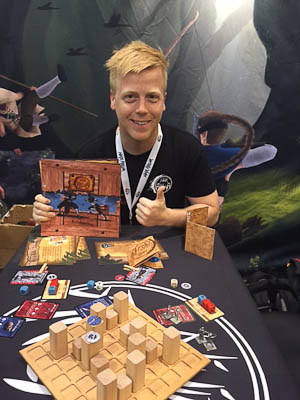 Moreover we have fighting actions for melee and range attacks and of course we also have defences. The rest of the available action has to do with the turning of your ninja, because for most attacking purposes and also for a lot of the special moves it is necessary to face your neighbour. The difference between the red and the blue dice is the velocity. The red die is the fast one, so when it comes to decide at which time a move is carried out, all actions of the red dice are carried out before the blue one. Now how does that work? On command all players simultaneously plan their three moves for the round behind the screen. They can choose which die they do not use in a round. All other dice are placed on a ninja board with the action you want to perform on top of the dice. Also it is quite important to place the dice in the correct order, because the actions are performed simultaneously from left to one. All this is done in real-time with the first player taking the order 1 token and so on.  After all players have finished, the screens are put away and the first action of each player is carried out. So we have to check who has played red dice (these actions are performed first) and, if there are several players with the same-coloured dice who has the lowest order token. After some time the ninjas meet on the board and are able to attack each other. Of course it is the goal to be the strongest ninja and so in the death match scenario we played today, the winning player is the last one survived. Ninja Arena seems to be a wonderful fighting game. The publisher makes a point doing sustainable games and the result is a great looking game. The mechanics as well as the theme are a little bit similar as Kumo Hogusha by Morning. But I think the game feels different. In Ninja Arena you have to fight your opponents. So you have to hide your ninja and attack from different positions. In Kumo Hogusha you have more game pieces and your goal is to move a block to the edge of the game. Anyway I liked to play the game and Oliver helped me with same really cool moves, so I was able to prevent early death. Right at the moment the game is only available in German, but there is a Kickstarter campaign running that will end in a translated version of the game. So if your are interested you should check up KS, I think the campaign will end in November this year. For the end of today I had planned to have a look at the new game by HELVETIA Games. Five years ago they presented their first games at SPIEL and I remember very well my first contact with Pierre-Yves at this time. They proudly came with their first two games set in the fantasy world of Helvetia at that time. Introduction: Sabbat Magica (Helvetia Games, Booth: 1-D101)
Well, back to the game. The board is composed of four tiles: a region board, a drawbridge, a manor board and the graveyard. Also, each player gets his own player board where he is placing and moving his resources. Each round of the game basically consists of two steps: First of all of our “planned” resources on the player boards are turned 1 hour to the right. Planned resources are resources you have taken in the rounds before, but not yet used. All resources on your player board have to be used in the two rounds (hours) that follow. If you do not succeed in this, those resources are moved to the rightmost, cursed square and by this they are removed from your board. Unfortunately they are exchanged by a cursed resource. Once this cursed resources leaves the board (one round later), the player will loose 5 VP. 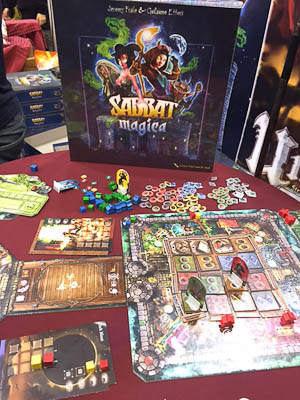 After we have done this movement of our resources, it is time to plan how many of your unused servants you want to bring into play this round. Unused servants always are in the graveyard. Why don't you use all servants, you might ask. The reason is, that servants in play also demand some food at the end of a round and so it is not recommended to enter with too many servants in an early stage. Then it is time to move our magicians and the servants in play. Magicians can only move in the inner region of the manor board. Here they can collect resources, trade them and get some terror points, that are necessary to feed the servants. Servants on the other hand can be sent to the outer regions of the manor board, where they can help the player getting various bonuses. So for example there is a terror bonus, so less terror points are needed for the supply phase. 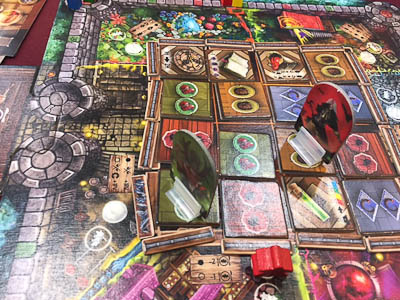 Moreover servants can also be sent to the region board where they can collect victory points at the end of the round. But to go there you need resources. Each door of the chamber on the region board demands different resources to open, so a wise planning is necessary to enter the rooms. Finally, the drawbridge is the connection between the two other boards, so it has no special function, but it takes you a move from one board to the other. Every region or chamber for a servant has only limited space, depending on the number of players. So once all free spaces are occupied you must attack the other servants. For this again the terror points are used (remember that you also must still have enough of them to feed your servants). I played some turns against Piere-Yves and I made a lot of mistakes. Despite of the coloured board and the manageable rules, Sabbat Magica is a heavy resource management game. The game does not forgive you the slightest mistake. As an example an accumulation of resources that you not really can use, is very dangerous for for your victory point track. So it is not easy to win the game against experienced players. So it is definitely no family game. But I liked my two rounds and I was getting more and more into the game. In the end Guillaume Ettori and Jérémy Fraile joined us and I took a photo of the two designers of the game. 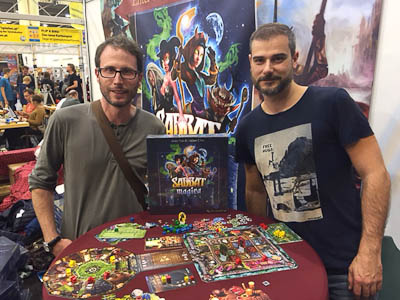 |
So far this day at the SPIEL has been just great, and my appetite for testing new games had not subsided. So, I now gave it a try to visit the booth of ASMODEE in Hall 1, since I had spied a banner announcing a strange new game from Martin Wallace for several days now.
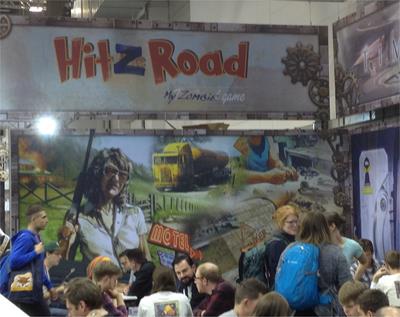
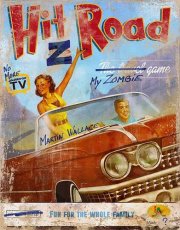
Martin Wallace and a Zombie boardgame?
The world really must have gone to hell, because I never would have thought that Martin ever would design a Zombie boardgame. However, joke aside, when I first heard about Hit Z Road which will be released by SPACE COWBOYS I made a mental note to check the game out, not least because of my affiliation to some of Martin Wallace's games.
Hit Z Road is not really a boardgame but actually a dice rolling game in which the players have to fight their way from Chicago to the West Coast through a Zombie-infested USA. The game is played over a total of 8 rounds, and in during these rounds each player will have to chose a set of two Location cards which he wants to visit during his turn. Over the course of the game the difficulty level of these cards will rise due to the deck consisting of three different types of cardsand at the end of the game all surviving players will add up the values of the cards they have collected in order to find out who was the most successful Zombie-slayer.
The choice of the Location cards at the beginning of a round is not made at random, but instead a number of card pairs will be revealed and becomes available for auction. Now they players can bid resources for the right to chose first, and when the auction is over each player will be allowed to chose a pair of two cards.
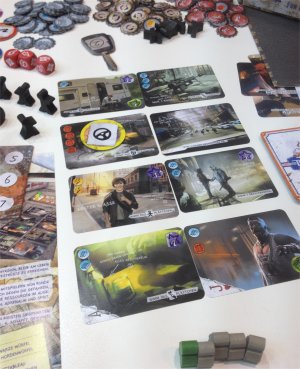
The encountering of the Location cards is the main phase of the game, since the cards may both grant the visiting player a certain amount of resources and bring up some Zombies he will have to fight. In addition, a Location card also may list an event, and this event is triggered automatically when a player visits the location.
Like in every Zombie game, the slaying of Zombies makes up the survivors' daily routine, and whenever a Location card lists a number of Zombies combat will ensue automatically. Before it comes to melee, the active player actually is allowed to discard of Ammo resource tokens in order to make a ranged attack on the Zombies, and the outcome of this will be determined by a diceroll with every crosshair-symbol indicating a Zombie to be removed.
If there are still Zombies alive, the player either must discard 2 Gas resource tokens to flee from the scene (thus discarding the Location card instead of keeping it), or he may send his survivor group into melee against the remaining Zombies. Melee means that a number of Combat dice corresponding to the number of survivors in the player's group will be rolled, and these dice may result either in the killing of a Zombie, nothing or a casualty on side of the survivors. Some of these results actually can be improved by the use of Adrenaline resource tokens, giving the player the chance to kill even more Zombies or to avoid a casualty result. Either way, the player continues these rounds of dice rolling until either his survivors or the Zombies are defeated. If the Zombies are defeated the remaining survivors will move on, whereas a loss of all survivors means that this player is the next to get drinks for the other players - he is out of the game. A harsh result, but it seems bearable due to the various possibilities to mitigate luck by use of resource tokens.
If the Zombie symbol on the Location card actually signalizes an attacking horde, things get a bit more ugly since the player now needs to replace some of his dice by Horde dice. These dice function normally, but they have the dreaded "Horrible Death" result which cannot be averted by means of Adrenaline resource tokens. So, a player should think wisely before facing a horde!
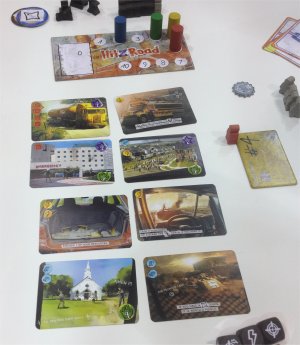
Believe it or not, but that's more or less the full mechanics of the game. On first sight this may seem as if the game lacks playing depth, but on the other hand this depends on what the players are looking for. Hit Z Road doesn't feel too different from Richard Launius' Run, Fight or Die considering the dice rolling as a main element, but the tactical approach is different because the players actually have to spend their resources in auctions to gain the best Location cards. Looking at the nicely drawn illustrations on these cards and on the 60ies style box cover, it becomes clear that the game doesn't take itself too serious. Many of the card illustrations show people or other elements which are well known from the Zombie genre, and apart from these Easter Eggs the game itself also has a special appeal on its own. The extremely streamlined rules allow for a very fluent and brutal gameplay, and players who are out for a quick filler game with a good thematic backstory will not be disappointed.
And there it was - the time for my last scheduled meeting at the SPIEL '16 had arrived. On thursday Vangelis Bagiartakis has introduced me to Anastasios "Tassos" Grigoriadis, a product manager for VESUVIUS MEDIA from Canda, and Tassos had asked me whether I would like to check out their new game 7 Dwarfs Fall. The cute looking graphics on the flyer kindled my interest, and so we had agreed on a meeting today.
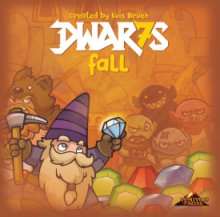
7 Dwarfs Fall in essence is a worker placement game in which each player uses his 7 dwarfs to visit and activate different locations in the kingdom. However, at the beginning of the game there is no kingdom at all, but instead each player possesses a set of 9 Location cards which forms his starting hand. During his turn, a player can spend up to 3 actions, and at the beginning the players certainly will start placing at least Location card in order to have locations where dwarfs can be sent.
Already at this point it is important to note that 9 cards is a player's hand size limit, and so the players have to place Location cards in order to make space in their hands to be able to store different kinds of gems which can be found in mines. These gems in turn will be used to complete Task cards, and the first player to complete his 3rd task will trigger the end of the game. At that point the players will count the victory points they have gained from Task cards, but additional points from remaining gems and slain monsters will be added as well.
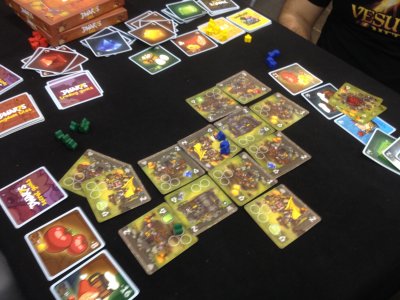
The 7 Dwarf-meeples (Dweeples?) come into play when a player wants to use a location. For example, the aforementioned mines require a player to send 2 or 3 dwarfs to gain 1 or 2 gems of the kind which can be found in that particular mine, and when a player has sent enough dwarfs he will take new gem cards to his hand and place the dwarfs back into his stockpile. If a player has collected enough gems to fulfil a Task card, the dwarfs once again are sent out, but this time they will go to an Inn where they can exchange the gems for the Task card.
However, the other players' dwarfs certainly don't like if one player's dwarfs are too efficient, and that's where the game starts to get interactive. Since most of the Task cards are openly available, the players will try to hamper each other in gaining the required gems, and this can be reached by either placing just one or two dwarfs at a mine without taking a gem, or even by covering the mine with a new Location card from a player's hand, Both are ways to delay another player, since that player now will have to resort to other measures to continue his initial plan.
How to get rid of blocking dwarfs? Hire an Ogre! Indeed, some Ogres can be found in a different type of Inn, and a player sending enough dwarfs there is allowed to take an Ogre card. These cards can help on a number of situations, e.g. sometimes they may allow the movement of a dwarf away from a location (Ogre says "Bo!"), sometimes removing all Dwarfs from the location (Ogre says "Punch!).
The covering of a location must be countered in a different way, and it can only be undone by sending dwarfs to a Royal Castle. The king then will order the covered card to be placed on top again, giving the player once more the possibility to use the card. However, the Mines and even the Castles also may be threatened by monsters, and for this reason each player starts the game with a Dragon and a special Ogre card on his hand. If the Dragon is placed on a mine, all connected mines in the kingdom cease to function until the Dragon is slain by sending five dwarfs, and likewise a Castle must first get rid of an Ogre card in the same fashion in order to be operational once more.
7 Dwarfs Fall indeed is a cute and dynamic game in which the players must have a good sense for timing and the other player's plans. If possible moves can be predicted, it is possible to counter moves and actions of other players, and this in turn results in the players readjusting their plans to make the best out of a certain situation. Both the types of locations and the number of dwarfs available to each player are manageable, and for that reason the game plays comparatively quick and allows room for an instant re-match. Overall, my first impression of 7 Dwarfs Fall was positive!
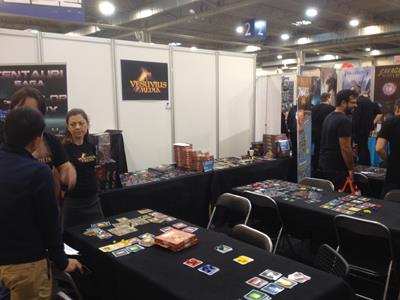
With the afternoon wearing on I made my way into Hall 6 where I had seen a nice-looking game by illustrated by Naiade, one of my favourite artists. I had spied at the booth of CATCH UP GAMES several times during the last few days, but the game had always been in progression. However, this afternoon I was lucky, and so I could join a multinational group of gamers on a trip to the island of Sol.
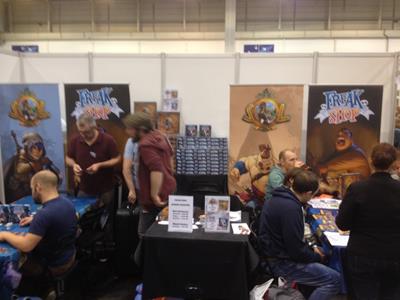
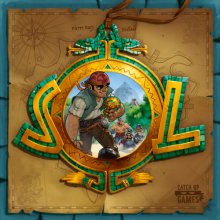
Sol is a semi-cooperative game in which two teams of players try to find a long hidden treasure in one of the 8 temples which can be found on the island. Depending on the number of players, each player takes one or two pirate characters, but for today's 8 player game one character per player was sufficient.
Apart from a unique special ability each character has three attributes which are shown in symbols on the character sheets: movement, searching and combat. The movement characteristic shows how many movement points the player can spend per turn for that character, and the searching characteristic determines how many Exploration tokens the character can retrieve each turn. Both of these characteristics are important right from the beginning of the game, since the pirate crews will swarm from their landing bay in order to retrieve as many Exploration tokens as possible. Apart form the temples, each space on the island contains such a token, and the players try to get those tokens because of the things which may be hidden on their downside. Quite often the players will find a symbol of one of the three attributes, and such a token can be kept and used later if a player wants to temporarily enhance this characteristic. However, of even greater importance are the tokens showing a clue on the whereabouts of the treasure, since such a token will allow the team of the finder to play a card into the Treasure Location outlay.
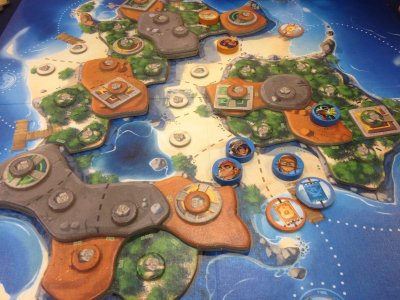
So, what is this Treasure Location outlay? To understand its meaning you must know that the eight temples where the treasure may be found differ in shape (round or square), colour (green or yellow) and stairs (one or four). Each temple has a unique combination of these attributes, and by playing cards into the Treasure Location outlay the players can try to influence in which particular temple the treasure will be found. This way they can try to manipulate the treasure's location towards a temple close to their landing bay, making it easier to retrieve the treasure and get it back on board of the ship.
When 7 cards have been played into the outlay, all cards will be revealed and the treasure's location now will be determined. The Treasure token will be placed at the temple in question, and now the hunt is open. The players now will try to pick up the Treasure token and get it to their landing bay, but of course the players from thej opposing team will try to prevent this. Sending their characters to block possible routes, sooner or later combat arises. Now both combatants will roll a combat die and add their combat characteristic to the dice roll, thus determining the winner of the combat. The winner may take the treasure token and dislocate the looser for one space, and in addition the looser is stunned and can neither attack nor use his special ability for one turn.
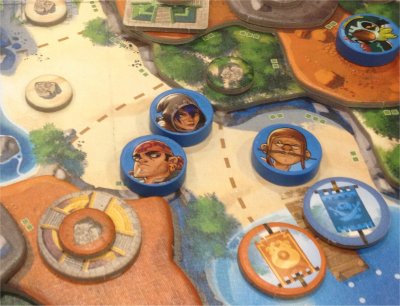
This may all sound rather straightforward, and indeed the rules of Sol are quite easy to grasp. However, from my point of view playing the game was a rather funny experience, and even more important was the fact the players in each team really consulted the others in order to make decisions for the benefit of the group. Quickly strategies where formed where the treasure should appear and how it could be protected, and on the other hand the opposing team tried to find a way to block possible routes for the treasure. Even though they seem fairly balanced, the special attributes of the characters are of high importance here, since they can give the player a nice edge if they are used wisely. In summary, the game played astonishingly well despite the participation of 8 players: quick player turns, no downtime, and real decisions to be made - with all these things coming together Sol presents itself as a rather entertaining boardgame especially for larger groups of players.
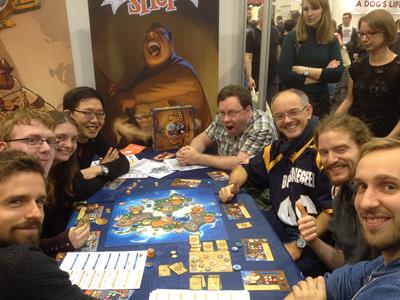
Indeed, the chance meeting of gamers here at the booth of CATCH UP GAMES once again was a wonderful example how the SPIEL succeeds in uniting people from different nations around a gaming table. Not knowing each other before the game started, we had a real blast playing Sol, and after the game we chatted a bit and then everybody went on in search of new games to play. That was a nice experience indeed!
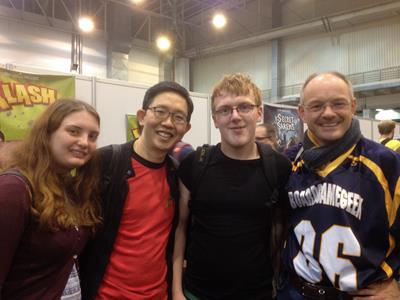
Talking about chance meetings, today at the fair I was greeted by someone whom I hadn't met before…
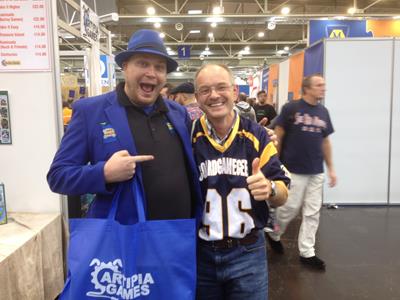
Bumping into Tom while marching to a playtesting session, he greeted me and told me that he actually enjoys reading my Essen blog. Well known to most of the boardgaming world, Tom is the editor of The Dice Tower, a podcasting network which is dedicated to reviewing boardgames and promoting the hobby in general. All of a sudden we were standing there and had a chat, and we discovered that the two of us together actually come to a total of 35 years of experience in game reviewing!
Tom actually asked me whether I was still running my annual prize draw, and when I answered this affirmatively he offered to add some of his Dice Tower promos to the prize draw in order to celebrate the 20th Anniversary of the G@mebox. Of course I couldn't resist to this offer, and so I visited Tom at his booth later during the afternoon.
Tom has put together two nice sets of Dice Tower promos, consisting of the "Hili" promo character for Blood Rage, the Iron Rook monster for King of Tokyo and a signed and dated dice tower, and as you can see in the overview at the beginning of this page these items have already been added to the prize draw!
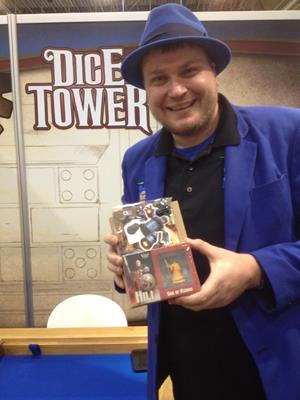
And this unexpected meeting with Tom Vasel is not only the end of this great day here at the SPIEL, but it is actually the end of my part in Ralf's and mine SPIEL '16 reporting. Unfortunately my schedule at work is quite overcrowded in the coming week, and for this reason I have to be in office early on monday morning. This makes it impossible for me to write up another report tomorrow night, and so Ralf will fully take over for tomorrow's final report.
However, as it's good tradition, I still have to nominate…
Actually the sheer flood of games available here the the SPIEL (1200 new games) makes it impossible for me to make an objective choice about "the best" game, but on the other hand my choices in previous years always have been based on my subjective findings and the experiences I made while playing the gamea. Based on these factors, the one game which impressed me most here at the SPIEL '16 was Captain Sonar by Cpt. Fraga and Lt. Lemonnier.
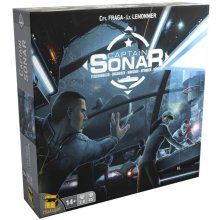
Apart from the cool implementation of the theme I was rather impressed how fluently the game plays, and it's an even bigger feat that Roberto Fraga and Yohan Lemonnier actually found an interesting way to implement the tasks of all crew members in gaming turns. In a way, the game feels like Battleships on a speed cruise, and the group with who I had played the game yesterday had been absolutely enthusiastic about the experience.
The game is unusual in the most positive sense, and I am very much looking forwards to try it out with some of my friends. So, after Giants in 2008 my Convention Hit Award goes once again to MATAGOT, but the fact that the game had been sold out already yesterday certainly is a sign that this choice probably is correct!
So, here we are, at the end of my 20th SPIEL report. Looking back at all my older reports while preparing the Anniversary Specials, it's certainly a strange feeling that 20 years have passed since I first sat down for my nighttime typing sessions. Many things have happened over the years, not only in the world of boardgames but in life in general, and a visit to the SPIEL certainly feels different for me today than it was 20 years ago. However, there are many positive memories which are connected to those 20 years of SPIEL reporting, and apart from playing some great games the possibility to meet many friends from around the world once a year for me certainly is the nicest fact of the whole event.
With this report I have tried to provide a unique and personal insight how a visit to the show feels like, and I hope that the enthusiasm which the whole event emanates could jump over to you. Despite being sleepy and exhausted after one week of reporting, a visit to the SPIEL really is a source for happiness, and I guess that all of us need as much happiness in our lives as we can get!!!
And don't forget to come back for Ralf's final report tomorrow!!!
Frank Schulte-Kulkmann
Essen, Germany
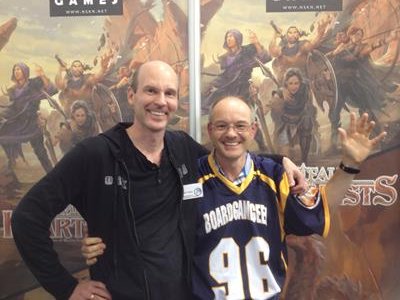
The SPIEL '16 Games Convention - Day 2
For me the day begun with a special mission, since once again Aldie had asked me to held a bit with the logistics. So, I over 100 batteries for their electronical gears, and I plundered 2 local supermarkets to get enough AA cells. Yesterday evening Nicole also had bought 8 additional rolls of adhesive tape, and so my first visit upon the opening of the halls was once again the booth of Boardgamegeek where Lincoln and Aldie were waiting for the stuff.

Yesterday I had met Dagmar de Cassan while wlaking past the booth of the Austrian Games Museum, and she told me about a game about making perfumes where the cards actually would bear real fragrances. I had seen a short announcement of this game already in the press conference, and when Dagmar told me that the game probably will sell out quick due to its unusual topic, I made up my mind to visit the booth of TAIWANESE BORADGAME DESIGN first thing this morning.
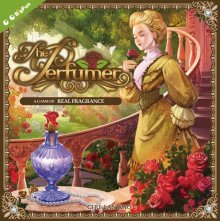
So, I wasn't sure what to expect when I sat down at the booth. A game where cards have a fragrance certainly sounds exotic, but for me the question arose how these kinds of smells actually could be included in a sensible set of rules and a sound playing mechanism. With this curiosity I began listening to the rules instructor, and indeed the Perfumer offers a deeper gameplay than I would have expected.
As the title suggests, the playsers of this game compete to become the world's most successful designer of perfumes, and they gain the needed reputation by fulfilling customer orders and by creating their own perfumes. The player actions in this game are regulated through a standard action point system, with each player being allowed to take up to five actions during his turn. Each player has his playing figure on the circular gameboard, and it costs always one action point to move from one location to a neighbouring location, or to take an ingredient token from the stockpile at the player's current location. These ingredients are collected by the player, and igf he has accumulated a combination of tokens matching the order of a customer at one of the locations, the player can travel there and fulfil the customer order. This will gain him Reputation points, and if it's a bigger order there is also the possibility to gain a small additional benefit like a further ingredient token.
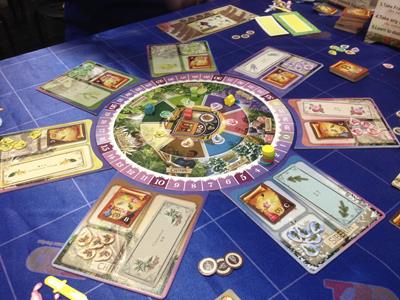
So, the timely fulfilment of customer orders certainly is one way to gain victory points, but there is also the possibility for the player to score points by creating his own perfumes. For this reason each player has received his own player board where different combinations of ingredients are shown, and the player needs to find these ingredients in order to invent these fragrances.
Before the game started, a total of 7 paper stripes with different kinds of smells has been put randomly into small, coloured holding frames, and these frames make it impossible for the players to see the name of the fragrance printed on the back. The fragrances included in the game are not obtrusive, but instead these paper stripes smell decently of fir, roses, cinnamon etc.. At the end of each of his turns a player is entitled to take one of the frames with a fragrance, trying to smell which fragrance it could be. Then the player has to check his player screen whether he needs the ingredient he has smelled in one of his perfume creations, and if this should be the case he can place a pipette matching the frame's colour next to the ingredient on his player screen. This way the player keeps track of the smells he has found, and later in the game - when a player thinks he has found all ingredients for a perfume - he will bottle the fragrance up in the hope to score victory points for his creations at the end of the game. When the game is over, all fragrances will be revealed, and only a player who has combined the fragrances he has smelled correctly will be allowed the score victory points for his creation.
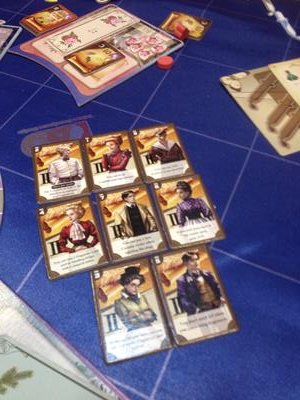
Both the fulfilment of customer order and the collecting of ingredient tokens is loosely connected to the creation of a player's own perfumes through the smelling exercise. Whenever a player ends his turn at a location, he may take a smell at a paper stripe bearing the smell of the ingredient which can be collected at this location. This gives the player a possibility to cross reference the smelling of the ingredients in the frames with the clearly visible fragrance of the ingredients at his current location, and this exercise might help to disctinguish some of the more difficult ingredients.
In essence the game runs until a certain number of customer orders has been fulfilled, and now the players can score for the creation of their own fragrances. All the smelling stripes from the frames are revealed, and a player who has successfully aligned the coloured pipettes on his player board will receive a nice bonus.
However, the game does not stop with this basic mechanism, but there is actually a few more elements like the possibility to open a shop (creating victory points every round) or the hiring of an assistant, thus giving each player a unique special attribute. In total, all this amounts to a solid resource management set of rules on which The Perfumer operates, and this set of rules has been enhanced through the introduction of the smelling exercise.
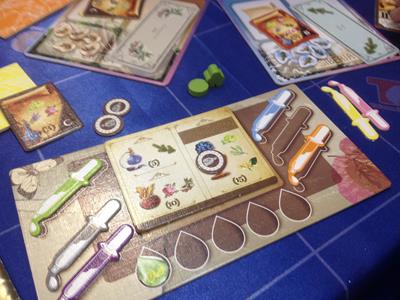
The elements coming together in The Perfumer makes this game stand apart from the from the masses of new games available here at the SPIEL, and the included smelling exercise certainly plays a major role on this observation. As indicated, the resource management mechanism included in the game is solid and functional, and designer Chu-Lan Kao actually succeeded in making a sensible bridge between the resource management and the smelling of the ingredients. The game is not overly complex, but the existing mechanisms and the mentioned unusual elements still qualify it to be a very nice family game. There is even a possibility to downgrade the complexity by leaving certain parts of the rules like the assistants aside, but moderately experienced players certainly can directly enjoy the full game.
As for the smells themselves, they are sufficiently perceptible and can be distinguished from each other. The printing technique really worked, and when you rub on one of these paper cards the smell can be activated even stronger. However, it's not like you are testing perfume or something - you still have to place the paper under your nose to perceive the smell. As I was told, the smell will wear off after about two years, but B!iFun actually will be selling replacements for the game.
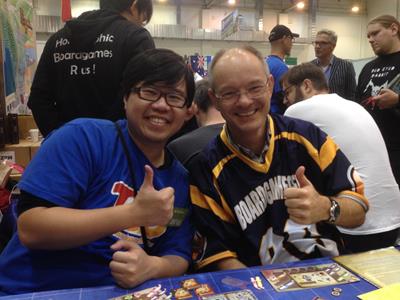
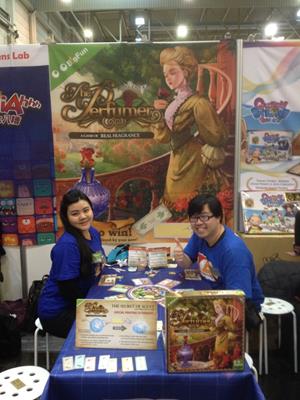
My next meeting was scheduled with Matthieu at the booth of French publisher IELLO, and so I made my way over into Hall 3 in order to meet with him. However, I actually arrived much too early, and this gave me the possibility to grab a free chair and join a round of one of the new IELLO games.
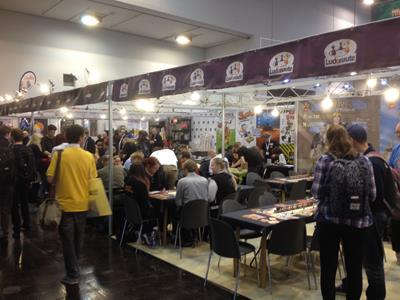
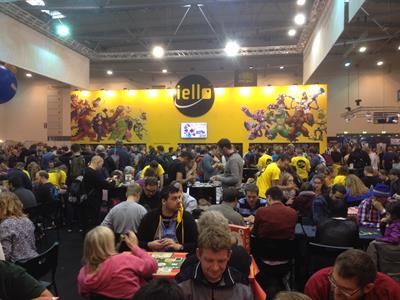
Space heroes, sinister cultists, students of magic or air pirates - all games in IELLO's portfolio share the simple but convincing fact that the graphic design is just great. Drawing on the great French tradition of wonderful illustrated comics (bande desinée), just looking at an IELLO game's cover invites you to explore the game, and so Sea of Clouds - a game about pirates on flying ships - quickly caught my attention and tempted me to playtest it.
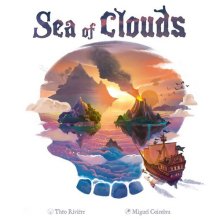
Each player assumes the Captain's position on a ship full of endearing cutthroats, and over a a certain number of rounds the player will try to collect as many Dubloons and Loot cards as possible. When the game ends, all the money and the Loots cards will be turned into Victory Points, but whereas the Dubloons are cashed in on a 1 to 1 basis, the Loot cards show different types of objects which are converted into Victory Points on a variable basis. For example, each Rum card will give a player Victory Points as listed on the card, but if it should be a Collector's Rum card the player also will get a bonus depending on how many of these cards he has collected. Likewise, the Relic cards also must be collected, and the amount of Victory Points a player gains (or loses) also depends on the fact how many cards of a particular relic a player was able to collect.
The collecting of Loot cards follows a simple, straightforward mechanism. Three piles of random Loot cards are available at the table, and each pile starts with just one card. Going from the left pile to the right, the active player has the right to check the contents of all Loot cards in a pile, announcing whether he keeps those cards (replacing them with a new card from the deck), or whether he passes on taking the cards in order to check out the next pile. If a player passes this way, a new card from the deck is added to that pile, making it possibly more attractive for a following player to take these cards. In this fashion a player can circle through all three piles of Loot cards, but if he passes on the third pile the player only will receive the topmost card from the drawing pile without the possibility to check its contents.
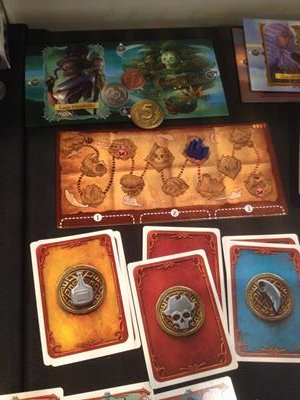
However, the players are not totally blind considering the cards which may be lying in later piles. So, the general type of a card also can be identified by its backside, and so the players always will know which types of cards they may expect within a certain pile. Not much of an information, but at least an indication which cards might be included.
Apart from the Relics and Rum card, the Loot deck also contains Objects and Pirates. Objects are the game changing elements in this game, either allowing a player to gain a permanent ability or an immediate effect, and in some cases these cards also may be kept for the final score count because they may give a benefit there. The in-game effects range between a number of abilities, but usually they allow the manipulation of another Captain's possessions or they convey some protective attributes.
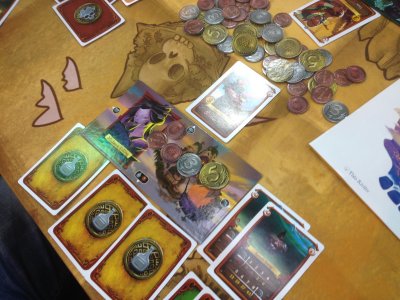
Pirate cards on the other hand are part of a player's crew, and the crews will be put to test when it comes to a boarding action in which the ships of neighbouring players battle against each other. These boarding actions are an obligatory part of the game since the round tracker on the central overview board determines in which rounds a boarding action takes place, and so the players will have to balance gaining valuable Loot cards against some additional Pirates to their crews.
In a boarding action the players will add up the Strength values of all their crew members, and then these values will be compared with the values of both neighbouring players. The boarding will be won by the player with the stronger crew, and that player now may use the abilities of his crew members against the loosing player(s). This usually means that the winner can steal Loot cards or exchange them with the looser, and so a nice big treasure may quickly get lost by a Captain who doesn't hire enough crew.
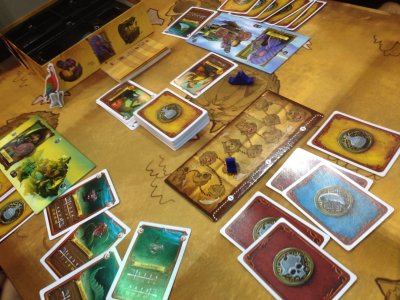
Sea of Clouds is an unexpectedly light game which is based on a collecting mechanism with a somewhat controlled push-your-luck element. Due to the obligatory boarding actions conflicts between the players are inevitable, but these actually are the spice of the game since the card collecting element alone would be a quite boring exercise. The special abilities of some Pirate cards have been nicely finetuned in order to allow for some additional diversification, because the players actually need to try to fit these attributes into a good battle tactic. However, Sea of Clouds in essence is a very dynamic game where cards may change hands quite quickly, and so it is not a game for deep-thinking planners, but for players who love to sail quickly on an incoming breeze. A good and entertaining family game!
My game ended just in time for my meeting with Matthieu, and taking me into the IELLO Press Lounge Matthieu introduced me to some more of their new games. Two of these I would like to mention here, and one is their big new game for this SPIEL - Kanagawa. The game is about Japanese art, with the players trying to become the most successful artists. In the course of the game the players can acquire pieces of art which they can combine into one large painting, provided they have already learned the painting techniques needed to paint this art. For this reason each Art card also has a small skill part, and if the player cannot or does not want to paint this piece of art, he can add the skill of this card to his own skills, possibly widening the range of actions now available to him.
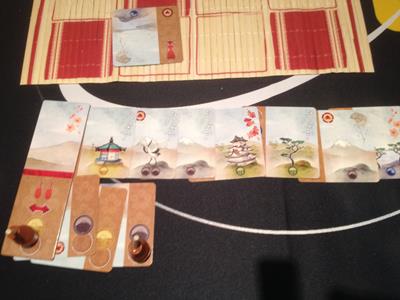
Each of the art cards actually belongs into several categories like the things that have been painted, the season of the painting etc. At the end of the game the players will be able to score points in these categories, and these points will be specifically awarded to players who have succeeded in creating a longer row of recurring categories within their row of art cards. So, the positioning of each card also is important if a player wants to create good scoring possibilities.
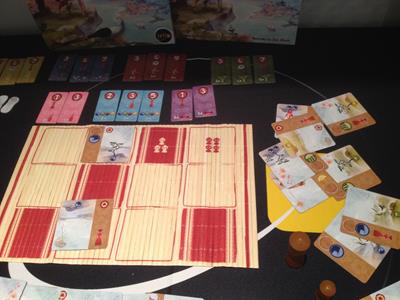
The other new game, Wecome back to the Dungeon, actually is a follow-up to last year's successful mini-game Welcome to the Dungeon. The game is both a stand-alone game and an expansion, and the four new characters included can be combined with the older characters in any fashion the players desire. I am mentioning the game here specifically because both games of the Welcome to the Dungeon venue actually are quite charming push your luck games which can easily be overseen due to their small size.
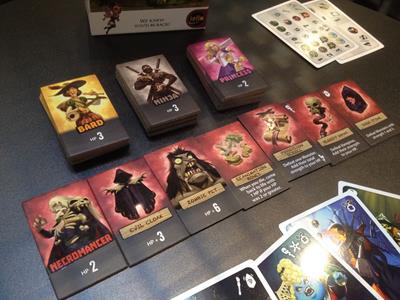
In essence, one player will be sending a hero to explore a dungeon, but before the hero is determined the dungeon is built by the players adding hidden Monster cards to a dungeon pile. However, the player who adds a Monster card is allowed to look at it, and when his turn comes to add another card he can actually drop out of the procedure, saying that his hero will not enter that specific dungeon. In the end only one player will be left to send his hero into the dungeon, and then the Monster cards will be revealed one by one, forcing the hero to use up his equipment while trying to defat all of the dungeon's denizens.

The game is quick and the players often are in for the one or other surprise, and the cute graphics suggest rightly that it shouldn't be taken too seriously. However, its short playing duration coupled with a high addiction factor make it an ideal travelling companion, and with the new set now there should be enough heroes and monsters for many a voyage.
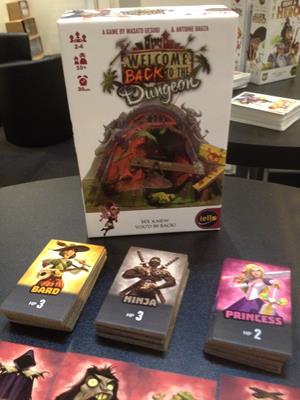
On a final note, it should be mentioned at this point that IELLO has started to produce German language versions of their new games. Until now only a part of their games had been translated into German, but Matthieu told me that they have decided against waiting for distributors, and so nearly all of the new IELLO games are available in English, French and German.
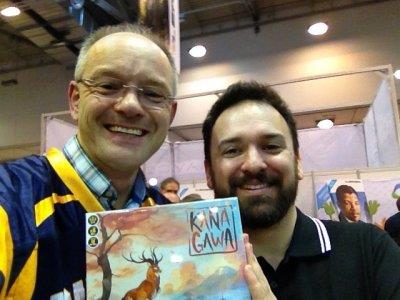
Today my schedule was filled up to the brink, and so I actually couldn't make it home for lunch. I contemplated eating in one of the restaurants, but in the end I went into the inner courtyard where the storage trucks are parking. However, this is not only a parking lot, but actually a small barbecue hut and a few tables have been set up as well, and so I had a quick lunch out there in the comparatively cold air.
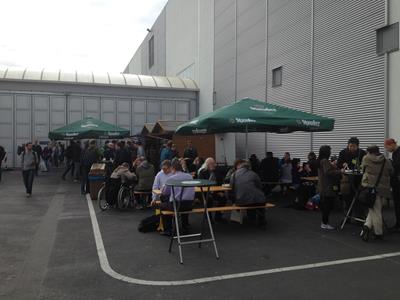
However, some of the regular visitor of the SPIEL possibly will remember that in some years we had quite crazy weather conditions in October. Scanning through my old reports, I found several pictures from years in which the temperatures during the SPIEL had been 25 degrees or even higher, and in those years the inner courtyards of the Messe sometimes had turned into places of events of their own. People started to play outside, and sometimes even the enthusiasts for live role-play game left their hall and started dueling and singing outside in the sun. However, that's unfortunately not the case this year…
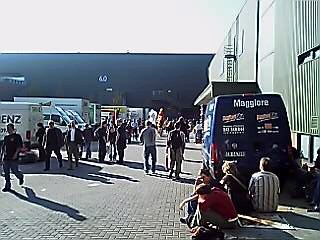
![[SPIEL]](../essen12/ess1282.jpg)
![[SPIEL]](../essen13/ess13077.jpg)
However, the lunchbreak always is a good time to see what Ralf has been doing today. Let's have a look!
|
My day at the SPIEL started earlier than yesterday, because I was invited to playtest a new prototype by REBEL.PL. When I arrived I still had to wait for another guy, so I talked with Adam Kwapiwski, the designer of the game, about the designing process. The start of the game dates back to 2012. The main process was was done in about 2 years and by now there is only a little bit of fine tuning left to do. He apologized that the artwork of the game is not completely finalized, but for me the quality of those prototypes, at the moment when they are shown to me, is always surprisingly good. I mean, look at the pictures! This looks like a final game, doesn't it. But it is not! It probably will be released at GenCon next year, so for me it will be Essen 2017 to hold it in my hands. But we were here for playing the game, so, after 10 minutes, I asked whom we were waiting for. The answer was: Mr. Kulkmann. Frank? Why didn't I know that? Well, probably it was a simple misunderstanding, so, after I called Frank, we finally began to play. Playtesting Session: Nemesis (Rebel.pl, Booth: 1-C140)
Nemesis is a sci-fi (semi-)cooperative game, in which all players wake up from hibernation in a spaceship. Nobody knows what has happened, but something is strange. Sometimes noises from other rooms can be heard and one crew member, randomly drawn at the beginning of the game, is dead. But it is worse, something strange has happened to his body... The board of the game shows us the spaceship, but only the hibernation room, where we all woke, is already revealed. All other rooms are – randomly drawn - placed hidden during the set-up phase. Each room also gets an event / equipment token, that is placed face down on top of the room disc. Well when I said we, I was not correct. As Frank did not join me, I was alone. But you can play Nemesis in a solo variant and that is what I was doing now. As a character I chose a mechanic, hoping that it would be a wise choice. I thought him to be a decent fighter and an all-rounder when it comes to non-fighting actions. But I also could have chosen for example a stormtrooper, a physician or a scientist. Every character plays totally different, because they all have their own deck of cards. Partially Nemesis is a deck-building game, but with a crucial difference to other games of this genre. In Nemesis you not exactly build your deck, but you have to add negative cards to your deck, when for example you are attacked by aliens. 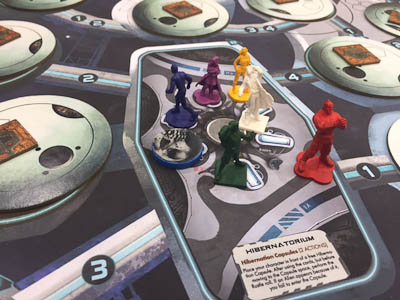 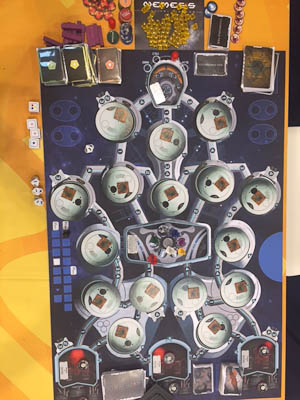 Next to the character each player also has his own randomly drawn goal to win the game. So the one player could want to come home to earth, while the other one wants to head for Nemesis. So in a multiplayer game these diverging goals can lead to disagreements among the crew and so the cooperative game (everybody wants to find out what is going on and wants to get rid of the aliens onboard) can change into a competitive game. But step by step. First of all we have to explore the spaceship. Because after the hibernation nobody seems to remember where to find the rooms. So we have to move. Basically you have five regular actions. To use one of these you have to discard one of your six hand cards. So moving from one room to the next one takes a card for example. Of course you cannot use the card effects anymore when you discard them. So Nemesis is a kind of hand management game. You must always choose whether you use the card effect or discard the card to perfom another action. Entering a room let us flip the room disk to reveal the room's function and its special actions. Also we have to flip the equipment / event token to see how many equipment we can find in the room. There are three different coloured rooms, each leading us to a different deck of equipment cards. But before we can search the room (you have to play a search card from your hand as an action for this), we still have to see what event awaits us. Most events are not good for us. So we can be faced by an alien, the equipment in the room can be broken, so we cannot use the room's special action any more (again we have a card to repair this in our deck) or a fire breaks out. Last but not least we must check if we made too much noise while moving. Noise is not good, because it attracts aliens again. 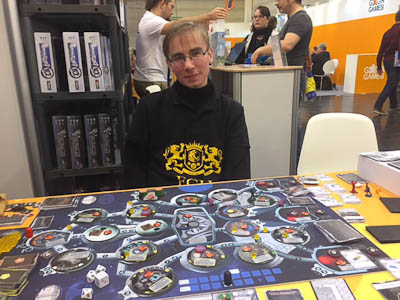 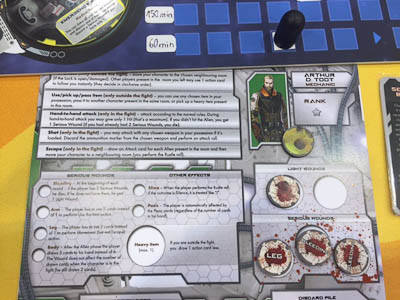 If we have a weapon and ammo (which is a limiting factor in the game), we can fight aliens by rolling dice. If you do not have ammo or even no weapons at all, you can try it with a hand-to-hand attack, but normally this is not the best way to get rid of the aliens. You can also run, but then the alien has a free attack, also not the best choice... What is really important in the game, are the different special actions of the rooms. On the one hand they can be quite useful to handle the spaceship. For example to stop fires in the rooms. On the other hand they are necessary to reach the goals. Again the special action can be performed by discarding cards from our hand. Nemesis is a very interesting game, I think. At first glance it seems to be complex and in fact, there is quite a lot going on. But it is also easy to grasp and after only two turns, I could play it without help. It starts gently, but after some time, the whole spaceship awakes. With each action you take, it becomes more risky to get out of a room without a wound. As said I played the solo-variant. So I had nobody against me except for the aliens. So I could concentrate on reaching my goal and I nearly succeeded. But in the end I was overkilled by a fire in almost every room of the spaceship and a nasty adult alien that loved too attack me viciously. So see you next year again, Nemesis! Leaving the booth of REBEL.PL, I decided to stay in Sci-Fi and I made my way to MORNING where I had an appointment to check their newest project Hope. Hope is also still a prototype, but it will be released at the beginning of the next year. So the design process has already been finished. This year at SPIEL you cannot miss the French publisher. Although they are still young, the size of their booth is nearly comparable with the big companies from Germany. 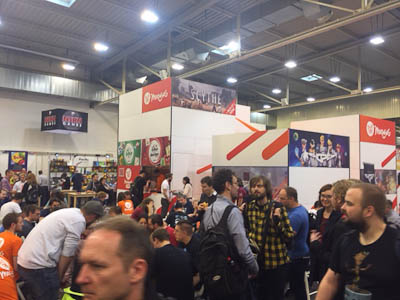 Introduction: Hope (Morning, Booth: 1-F131)
When I first heard from Hope last year I thought about a gloomy fantasy game with wicked monsters and rotten wizards and some lonely heroes as the only hope for earth. Then I heard that it would be set in the future, so I thought about a similar scenario, only with aliens instead of the monsters and wizards. But I was wrong: Hope or better H.O.P.E. is the Human Organization to Preserve Existence and we are much farer in the future than I had thought. To be exact: It is the year 5341 and we have reached a stage in which mankind lives in harmony and stability. But then something inexpected occurred: the universe collapses and turns into a Regression phase. All hope is gone, but a small organization of wise scientists knows what to do. With their Hope organization they jump from one dimension to the next and terraform all galaxies that are missing one of the six essential elements to become stable, so that they can serve as a place of retreat for mankind. And there are quite a lot of those unstable galaxies. The hexagonal board hosts 36 different galaxy tiles that are randomly distributed at the beginning of each game. So every new game looks different and represents a new challenge for the players. Each player has his own spaceship and gets a cockpit board with levers for navigation and room for improvements of his spaceship. The whole game is a race against the clock. Only if enough galaxies are stabilized before the Regression marker reaches the end of the mission track, the game can be won. But how does this work? To stabilize a galaxy the players must terraform all of the three dimensions of this galaxy. Easier said than done. First of all you must reach there. Navigating in space is not comparable with driving. Especially the gravity influences our possible movements. And so with our levers on our cockpit we can move towards or away the gravity point in our current dimension, we can move sideways or – as a joker – we can use one of the other three navigation options. With a single action we can move as far as we wish in the chosen direction, but all the time we must stay in the same dimension (colour) in the galaxies. So more or less straight movements are the result. On our way we can try to terraform the galaxy by sending pioneers from our ships. But to do so, we must play technology cards from our hand that show the missing element of the dimension of the galaxy that we cross. 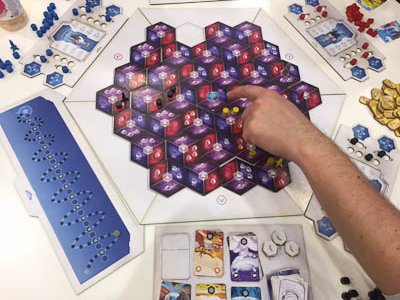 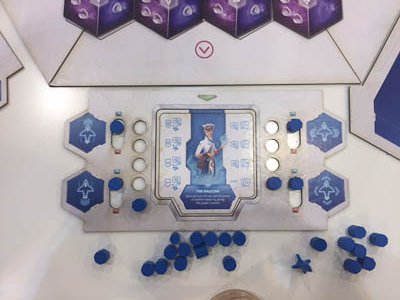 Those cards are replenished after use, but as an exchange we get new ones again. Unfortunately replenished card contribute to the progress of Regression on the mission track. So let us quickly get back to the stabilizing process. As said a galaxy becomes stable, if all three dimensions are terraformed. So we also need a method to change dimensions and this is called polarize in the game. Polarize can be chosen instead of navigation. You simply put your spaceship in the next dimension of the galaxy you stay. As a welcome side effect all levers of navigation are reset, so with your next turn you can navigate as desired again. Once all dimensions of a galaxy are terraformed, you can flip the galaxy to its stable side and all three pioneers are sent to the Mission track where they follow their own path. The path of the Regression marker is longer, but both paths intersect several times and if the Regression marker reaches these intersection points before the players with their pioneers, one of the galaxies vanishes from universe (taken out of the game). 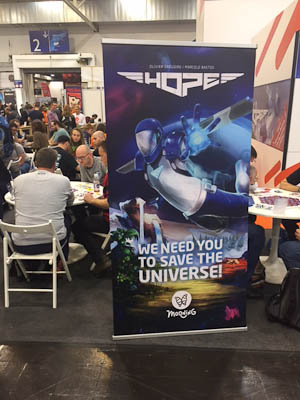 Hope has easy rules, but nevertheless I think that it will take some time to master the game. Especially the uncommon method to navigate seems to require some practise. You do not only have to find a way to reach a single galaxy, you also have to consider the three dimensions and your chances to terraform as many galaxies as possible while navigating. Hope seems to be a cooperative game, but on the other hand every player has his own goal. The one with the most pioneers on the mission track at the end of the game wins, at least if the players were faster than the Regression. Moreover Hope also can be played with a randomly determined traitor who pursues his own goals. Consequently this traitor works for the organization N.O.P.E., maybe the allegedly stage of harmony is stable as we were told.... While Hope is still a prototype, another game by MORNING was already hyped before the convention. This game is called Scythe. And I think it is rightly praised. I mean it is big, it is complex, it is a great worker placement game and then look at the artwork: it is gorgeous, isn't it?... 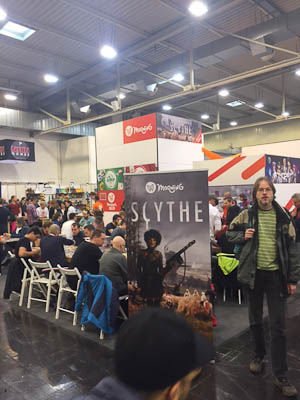 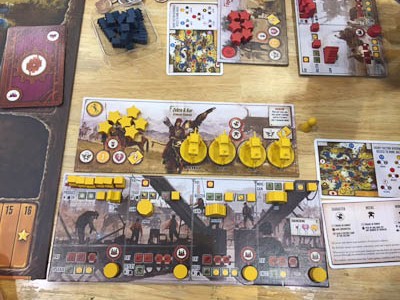 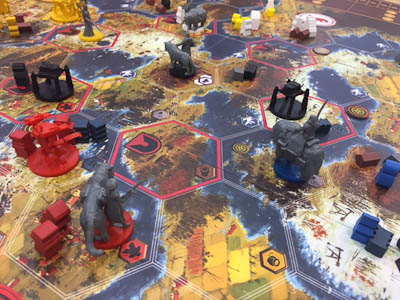 I was told that people queued for the game on Wednesday, one day before the official opening. So you will understand that no free table was on view to playtest the game. But I hope to come back another day to learn more about this masterpiece. After I had lunch, my next stop was at NSKN. I have already reviewed the prototype of their In the name of Odin in spring, so if you want to know about this game, you can find the review here, too. The final production looks even better, so it is definitely worth a try-out. But today I came for an expansion for Simurgh. The base game is a medium worker placement with some interesting new mechanics, so let us check the expansion right now. 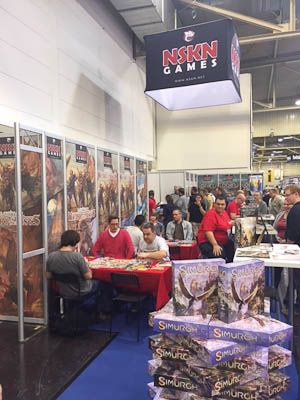 Introduction: Simurgh: Call of the Dragonlord (NSKN Legendary Games, Booth: 1-G124)
Simurgh – Call of the dragonlord is a so called modular expansion for Simurgh. If you do not know the base you can find a review in our reviewing section. The expansion comes with five different modules that can be taken into play for varying and expanding the game. Although it is possible to play with all new modules, it is not recommended, because some modules would interact creating unwanted game situations. They explained that this is not a result of bad game design, but they wanted to have different options to play the game. They also have foreseen these interactions, because in the rules you find a section to solve the problems if they occur. But let us have a small look what you can find in the box: The first module is not really a completely new module, because it only expands the amount of available tiles, we already know from the base game. So we are getting new production, transformation and research tiles as well as new objective. This can be mixed to the base game to give more variety. More interesting to my taste is the introduction of a wizard, a new vassal for the players. This vassal can either played as a normal dragonrider that only has a single, but mighty free action when it comes into play. Or it can be played in combination with a new board that has three tracks the wizards follow during the game. This last module also introduces minor and major spells for the players, the first one as a free action, the latter as a main action. This module sounds very interesting to me, as I think that it will alter the gameplay most of all. 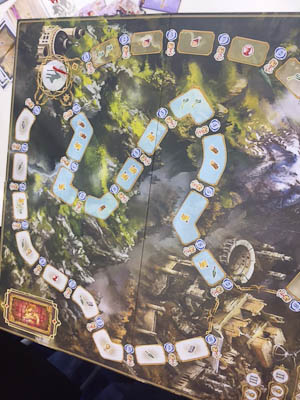 Leadership is another interesting module, because it can break the rule, that you only may place one Vassal during a turn. For this new leadership tiles are shuffled among the action tiles and by this can be brought into play. Finally you have special abilities for each house, so that players do not only distinguish by their dragons, but can also used free or triggered actions by their individual houses. This could be interesting when following different strategies, I would think. Last but not least there are quests that influence the endgame scoring. 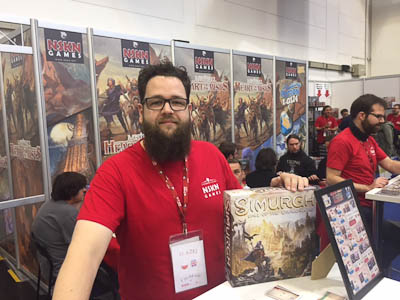 Simurgh – Call of the dragonlord offers players a lot of options to alter the base game and to find a way to play Simurgh to their individual wishes. It is more for players who frequently play the game, as the base game already has a lot to discover. But perhaps the wizards are worth to have the expansion anyhow, as they seem to give the players some very interesting spells and a new board that wants to be discovered. I personally liked that the expansion introduces more interaction and aggressive actions. But as said, you can adopt the game to your wishes and no module has to be taken. NSKN also presented a new stand-alone version of Mistfall and new expansion deck for the game. I will come back to this in the next weeks to come but for now I had to leave the booth, because now it was time to take off. At the booth of GOLDEN EGG GAMES I once again met my friend Elad Goldsteen. As many other small publishers his booth increases every year. The small publisher from Israel attends the SPIEL for the fifth year now. I still remember his start at SPIEL, when Elad all of a sudden was tied up with some other personal business before the fair and his father and father-in-law had to present his “baby” City of Karez. Moreover the parcels with the games were delayed and so they had nothing but one game in the first two days. And all the guys, who waited for their Kickstarter games, had to leave the booth empty-handed. A lot has changed since then: The booth is much bigger these days, led in a professional manner and Elad's games are much more balanced and tested, too. Last but not least the rulebooks are much better now, with a lot of examples to help players find into the game. So let us see how the new game works: 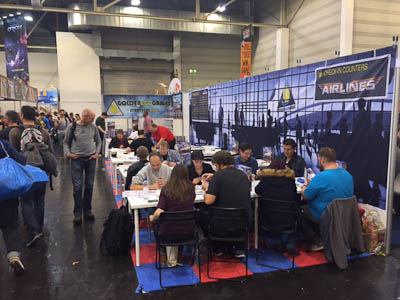 Introduction: Airlines (Golden Egg Games, Booth: 1-D143)
In Airlines players run an airline company and have to build up their airline fleet to carry passengers over the world. The games comes with a huge board and big airliner models that can be build up modular during the game. We all start with a single airliner with only a cockpit, wing and tail section. This airliner can hold up to 3 passengers, but can be expanded by any number of plane parts to hold more and more passengers. So you can build a super liner. Alternatively you can build two more airliners to be more flexible and expand your possible actions. Next to the VP track and some smaller overviews, the board holds nothing but a rotatable globe that is divided into 5 sections. Next to each section we find a different coloured country where we can place our airports. Every player starts with only one terminal, but this also can change during the game. Passengers enter the game randomly at the beginning of the game and at the end of each player's turn. Finally all players get hand of five cards. And that is all. Surprisingly Airlines basically is a pure card management game. Each turn you play a card, use its effect and draw a new card. Cards are either building cards or special actions. With a building you can establish a new terminal (that let you land more passengers than usual)or a travel agency (that gives you additional VP when carrying a passenger) in the given country. Building actions must be paid by discarding other cards from your hand, too. Special actions on the other hand give you more variety, so for example with the construction site you would be able to construct a building without paying its costs. Or you could draw 2 more cards with an additional action still available. 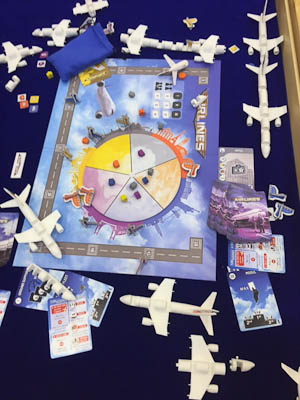 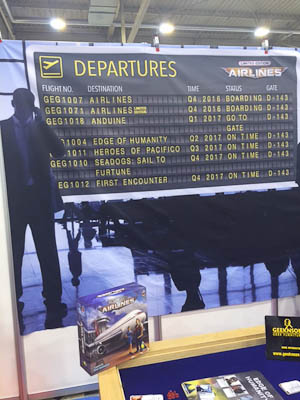 But next to these “airline actions” of the cards, each card can also be used for global actions. With these actions you can pick up new passengers from a section of the globe next to one of your terminals (again the colour of the card determines the colour of passengers you may take), landing your airline to drop-off the passengers for VP, a general income to gain more VP and – very important – an action to improve your airliners (either you expand an existing airliner, build a new one or you build a new airport in another country). With a single card you can use as many of these actions as the number of your airliners. But I nearly have forgotten the most important thing that happens when you play a card: with your first card played in your turn you also determine how many segments the globe is rotated. By this passengers move from one country to another and with this different passengers stand in front of your airports than before. You must consider this, too, before thoughtlessly playing a card... With the big airlines Airlines really looks great. It seems to be much fun to expand your fleet and to produce bigger and bigger airliners. Of course, in view of the fact that the game is more or less a hand card management game, it is nearly overproduced. But the game felt to be right the way it is. There are some interesting choices to make and the idea with the rotating globe that brings the passengers to your airports is a clever idea. Although I am still curious about the long-term replayability, I think that it is a good, mid-weight hand management game. I just realised that I have played all of my games in hall 1 up to now. That has to be changed. So let us move over to hall 2 where I finished the day with a huge dungeon crawler. Smashing some monsters, that what I needed after the hard day... Playtesting Session: Perdition's Mouth (Dragon Dawn Production, Booth: 2-D127)
Perdition's Mouth is a typical miniature dungeon crawler game. A lot of different monsters wants to kill us and prevent us from finding treasures and achieving our goals. The game is scenario-based, so if you are successful, you keep your heroes with all their new equipment and the story unfolds. Important for a lot of players is that there is a story and indeed, Perdition's Mouth has a lot to tell us. So it is up to us to find a way to be successful. Although traditional in its concept, the game has some remarkable improvements according to my taste. First of all, quite unusual for a dungeon crawler Perdition's Mouth doesn't use dice. Nearly everything can be done with base values and cards. Each character has his own deck of cards that he will expand during the scenarios and that he can use for various actions. For example a lot of the cards can be used during the attack action, and so they will give a bonus to your base attacking value. Instead of the die, the random element is introduced by a response deck. Whenever you have to check whether you are successful or not, you have to draw a card from this deck. It determines the defence value of an attacked monster as well as the success of the opening action of a chest. 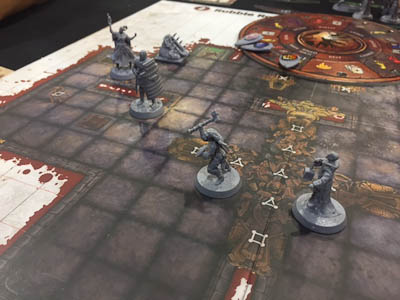 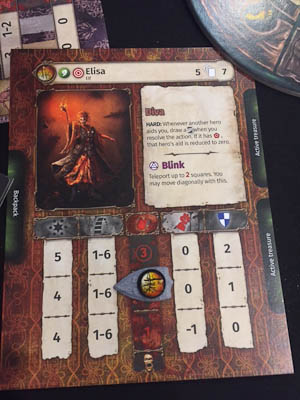 Perdition's Mouth was a fun to play. The rules were explained in about 20 minutes and we could immediately start the game without any more help from the staff. Killing monsters seems not be too easy, so I think that you normally will not end the game in a butchery. In fact I played a flame mage and the whole game I did not succeed in inflicting only one wound to a monster. On the other hand it seems to be easier to succeed than for example in Mage Knight, because my fellow player did kill some of the monsters. Perhaps there is a slight risk, that one of the player acts as an alpha gamer. But as the rules are quite easy to understand and due to the respond deck not everything is predictable, everybody should have his chance to play a role in the game. The minis of Perdition's Mouth seem to be of good quality and look great. So I can think of no reason for not killing more monsters, only that in my next try I will change the caharacter... But no more monsters for today.... |
The end of my lunchbreak actually brings me to another recurring event of each SPIEL, the ceremony for the International Gamers Awards. In former years the ceremony had been held in the halls at the booths of the winning publishers, but for the last couple of years Aldie had offered to host the ceremony at the Boardgamegeek booth in order to prevent the big queues of people from clogging up the corridors. No different this year, and so I made my way into hall 6 in order to meet with the other attending members of our awards jury.
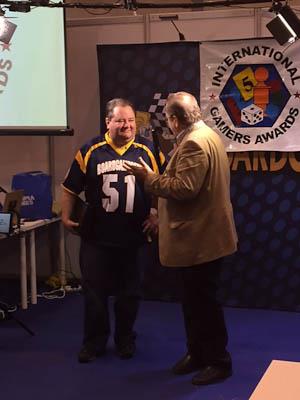
Like in the previous two years the event was hosted by Ferdinand the Cassan, and Ferdinand indeed was in a good mood today, remarking that the 1.2 million subscribers of Boardgamegeek actually could make a difference to a possibly disastrous outcome of the pending US elections. However, Ferdinand quickly left the field of politics, and so he gladly announced the winner of the International Gamers Awards in the 2-player category. This prize had been won by 7 Wonders Duel by Antoine Bauza and Bruno Cathala, and I was very happy by this choice because it meant another prestigious recognition for my friend Cedrick and REPOS PRODUCTION.
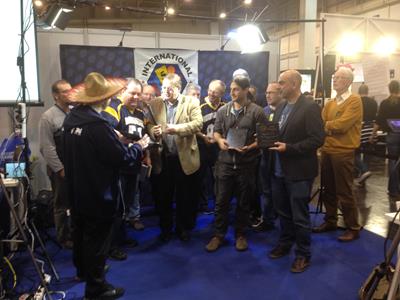
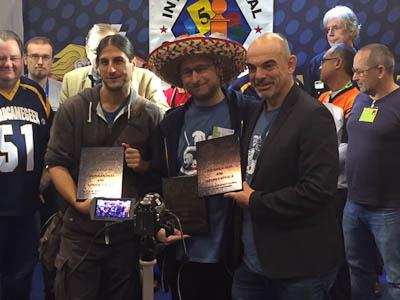
In the multiplayer category the International Gamers Awards 2016 had been won by Mombasa by Alexander Pfister. Indeed, this game seems to have met the taste of many a gamer, since it has not only been chosen as a winner by our international jury with 24 members, but as you have read on wednesday Mombasa also has won the Deutscher Spiele Preis 2016. This awards is given on a vote of thousands of gaming enthusiasts, and so once again our jury once again stands in unity with the the rest of the gaming world.
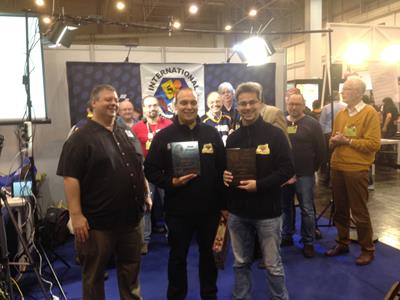
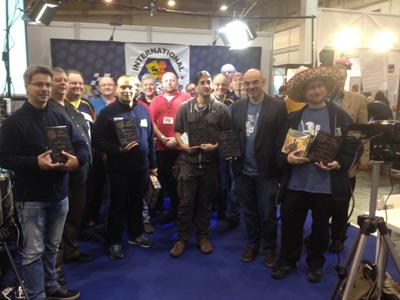
After the ceremony I met Henk Rolleman, a professional photographer from the Netherlands, and it was quite funny to see how he directed our winners to take some specific poses. Most interesting was the way he arranged Antoine and Bruno, standing opposite each other to capture the spirit of 7 Wonders Duel. However, he also made a quite nice shot of me, and this meeting of geeks needs to be shown here as well!
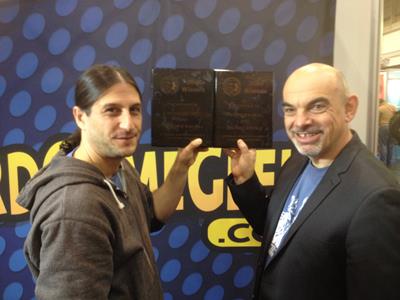

There was also time left for Aldie to take a nice shot of Ferdinand and me, and with the ceremony being over our jury once again dispersed into the halls. Myself, I joined Cedrick and Antoine for a few steps, and then I went off for my next meeting in Hall 1.
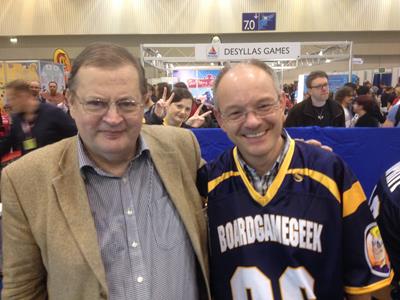
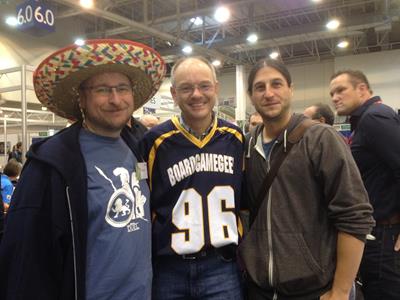
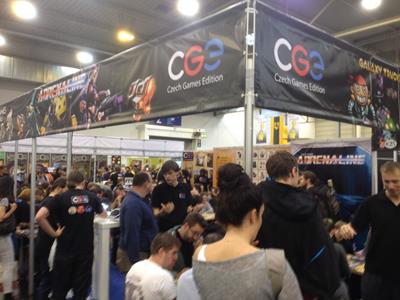
In Hall 1 Jana was waiting for me at the booth of CZECH GAMES EDITION, and like every year we launched into an overview of the new games which CGE has brought to the SPIEL. Their biggest novelty is Adrenaline, a first-person shooter which has gone boardgame. The players take the roles of duelists in an arena, and at certain points they can equip themselves with weapons and useful gadgets. Jana told me that the game plays brutally quick, but like in a computer game a player who has been eliminated will be rebooted quickly.
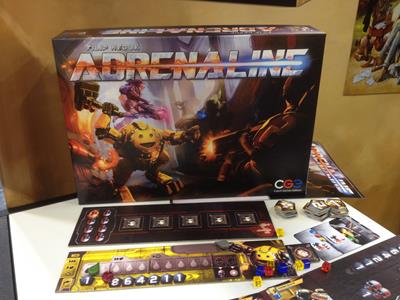
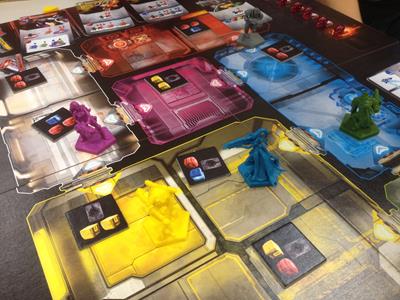
Vlaada Chvatil's rather successful Codenames also sees a follow up game here at the SPIEL. The new spin off is called Codenames Pictures, and this time the typical one-word descriptions have to be found for an outlay of funny images. The general approach remains the same, but the feeling will be different because the players now will have to think what they see on the pictures of the cards in the outlay, and they will have to make different kinds of associations to find out the solutions.
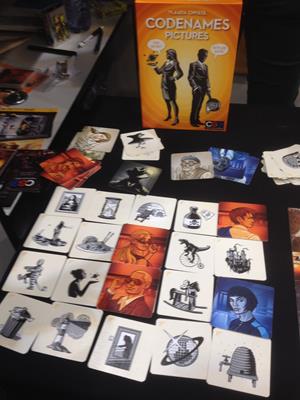
However, the third and final game which CGE has brought to the SPIEL needs to be introduced with a bit more text, since it is actually an expansion for one of my favourite games: Alchemists by Matus Kotry. When I first heard about the upcoming expansion I must confess that I was worried how the complexity of the basic game could be expanded even further, and so I was curious to see how the new expansion actually would turn out to fit.
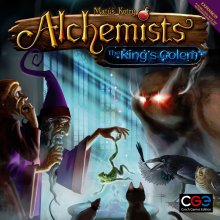
Following the modern trend of including several expansion modules in one box, Alchemists - The King's Golem contains a total of four expansion modules which can be combined in nearly any possible combination. Two of these expansions are quite straightforward and can be used even by players who haven't played the basic game before, whereas the other two expansions need more experience on the side of the players since they introduce new deductive mechanisms for identifying the alchemical composition of the classic ingredients.
Beginning with the two easier expansions, one of them is about third-party funding. In effect, this means that each player receives four foundation cards during setup, and he will choose two of these cards to determine his starting resources. Thus, the players now can start with quite different stocks of resources, allowing each player to begin the game on an individual strategy.
The second module isn't complicated either. Instead of using the same bissing track at the gameboard during each round, the expansion contains a choice of other bidding track tiles, and so the players will use a different bidding track during each of the six rounds of play. These tracks differ in costs and benefits, and so the players also can come to more variable results by clever bidding.
The third module, "The King's Encyclopedia", is of much more importance for the general deduction mechanism. In the basic game the players had the possibility to publish theories on the alchemical composition of ingredients, but now they can use an additional action space on an expanded gameboard, allowing them to publish different kinds of theories in the King's Encyclopedia. Unlike the base game theories, the Encyclopedia works the other way round, and so the alchmists publishing here actually will try to identify the ingredients which actually match a certain aspect of an Alchemical. This may actually sound like absolute gibberish for anyone who has not yet played the base game, but in effect all this means that the player's possibilities to find matching pairs of Alchemicals and ingredients (one of the main targets of the game) have been increased. For seasoned players it can be said at this point that this different way of publishing allows the players to use their knowledge in a different way, giving them a real alternative to publishing a normal theory on ingredients.
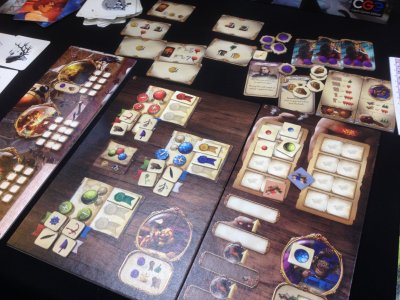
The masterpiece of the whole expansion set is "The Golem Project" and it uses a large portion of the included playing materials. Using a shortened deduction track, the players gain yet another possibility to test their knowledge on the alchemical composition of ingredients, but instead of using a student for testing a potion the alchemists now can try to activate the Golem with their ingredients, possibly causing a reaction like a glowing heart or steaming ears. Finding out the ingredients needed to activate the Golem will bring a player additional reputation, and furthermore knowledge in Golem-studies also comes in quite handy when an academical conference is called up. On a side notice, the rules for the Golem-Project are quite finely interwoven with the rules for the King's Encyclopedia, and so the Golem Project only can be used if the Encyclopedia is used as well.
Kudos to Matus Kotry - he really succeeded in introducing new mechanisms to a game which on first sight would not have needed an expansion. However, seasoned Alchemists players will know that the race for publications is very important when it comes to winning and losing, and here the new expansion takes a bit of pressure from the players by giving them some interesting new alternatives to classic publications. From my perspective especially the Golem-Project makes the game much more versatile, and so the expansion set certainly has a value which should not be underestimated. The only problem is the relatively big entrance hurdle, since the Golem-Project only can be played by players who are really familiar with the basic game. Explaining both the basic game and the expansion together would be a nightmare!!!
On a sidenote, I also like the fact that Matus has chosen the story of the Golem as a thematic background for the expansion. The legends around the Golem mostly focus on the city of Prague, and so the expansion actually draws on Czech history and tales.
Once again Jana has given me some great insights into the new games from CGE, and of course we agreed that we would meet here again next year: same time, same place!
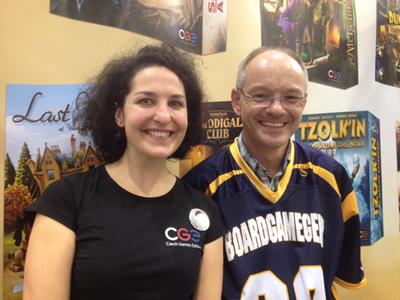
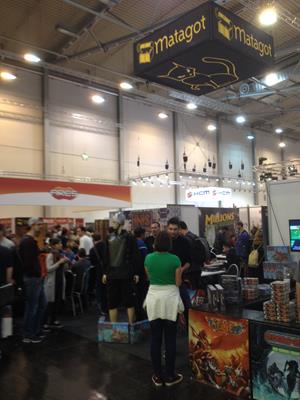
However, my schedule was not yet over, and so I hastened over to Hall 1 to the booth of MATAGOT. Here I was met by my friend Fabien, a teacher from Switzerland who does the press work and games scouting for MATAGOT, and in a more quiet part of the booth he asked me which games I would like to hear about. A game I wanted to play after our meeting was Captain Sonar, but of course I was also interested in the new big MATAGOT game Inis which has been designed by Christian Martinez.
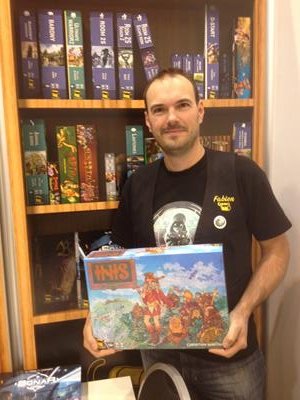
Coming with rather unusual, outstanding artwork it is a game about Celtic clans trying to gain dominance over a land, and the game can be won by fulfilling different kinds of victory conditions: domination over regions, presence at temples, or being present at different regions - for all victory conditions applies a strict "Rule of 6", meaning that a player needs to control 6 regions, or be present at 6 temples or 6 regions to win the game.
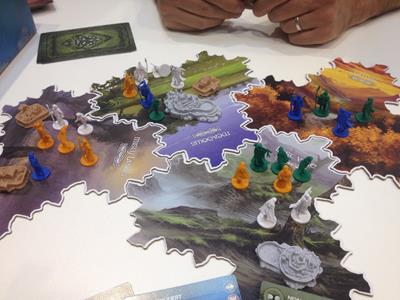
The player actions are determined by a set of Action cards, and these cards allow for the placement of movement of clan members. A bit unusual for a game which also focuses on area domination is the fact that clan members moving into a region with clan members of another player do not necessarly trigger a battle, but instead combat only arises if one of the present players wishes to do so. In addition, both parties can agree to break off combat after each round, and so the players have tactical options whether they really should eliminate the other clan members, or whether they stop fighting and better keep a majority/presence in that region. In addition, the combat is very straightforward with the participating players just removing clan members - one per battle round and player. There is no element of luck. But a clan member actually can be protected in a capital city or fortress if one should be in that specific region.
Some of the Action cards also give a possibility to react in certain situations, and furthermore some cards allow a player to draw an Epic Tale card. These are strong cards with a unique one-time effect, and their effective use can greatly help a player.
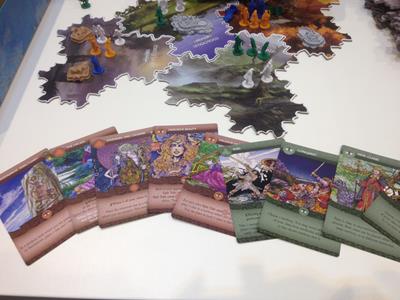
Both the graphics and the tactical approach of Inis made me rather curious to learn more about this game, but unfortunately I couldn't take a copy home with me. As Fabien told me, MATAGOT has nearly sold out all their stocks, and this happened despite the fact that they have taken more games to this year's SPIEL than in previous years. Inis, Captain Sonar and many other of the new games haven't made it past the second convention day, but despite the wait which is now unevitable I am happy for MATAGOT that their games are in such high demand here at the SPIEL!
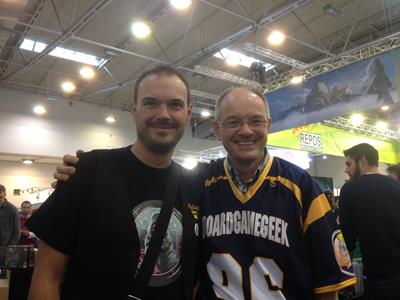
However, the fact that Captain Sonar is sold out didn't stop me from trying this game, and I was lucky since I only had to wait for a few minutes before I could find a captain who was willing to take me on board of his submarine!

In Captain Sonar designers Roberto Fraga and Yohan Lemmonier take us deep under the sea into a desperate battle of two submarines. However, even though this may sound like a two player game, Captain Sonar actually is a cooperative game for two teams of up to 4 players.
Depending on the number of available players, each player has to take one or more officer roles on his team's submarine. There are four roles available on each submarine, and these positions are the Captain, the First Mate, the Engineer and the Radio Operator. During the game it will be the aim of each crew to eliminate the other submarine by causing a total of four points of damage, and these points can be caused through aggressive weapons like torpedoes or mines, or they can also be triggered by system failures on board of a submarine.
The game actually begins a bit like classic Battleships, with each Captain chosing a position for his submarine on the map of the chosen scenario. The game then will start, and the players can chose to let each crew act in alternating order, or they can also play real-time, thus simulating the stress and rush of a real submarine duel. However, even though the real-time mode sounds really tempting, the players first should take a few missions to familiarize themselves with the game mechanics, since everybody needs to know the rules be heart in order to keep a balanced game. However, as you should see in this outline, the rules are not that complicated, and so the real-time mode can be reached quickly.
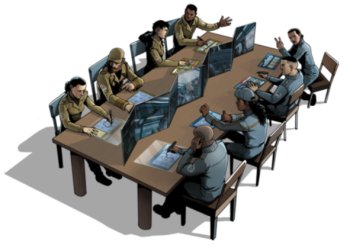
Before turning towards finding the enemy position and attacking, let's first examine the basic routines which will happen on board of a submarine during its turn. It is the Captain's task to keep track of the submarine's position on his map, and during a turn he must always announce to move the submarine for one space into either direction, with the exception that the submarine may not cross its own path and cannot run over islands. The direction of the movement is announced loudly, giving the Radio Operator of the opposing team time to record the movement, and then the First Mate and the Engineer of the moving submarine have to fulfil their tasks.
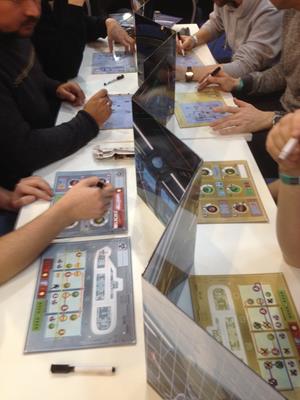
The First Mate actually is responsible for the submarine's systems, readying the systems stepwise for each movement the submarine takes. So, it will take several rounds until a torpedo, mine or drone is is ready, and likewise the sonar and the silent move will take several rounds to activate. However, the First Mate actually can chose on which activation gauge he wants to add a step, and so he is in control over the order and frequency in which each system becomes ready. If a system is ready, the First Mate will announce it, and it's up to the Captain to decide in which turn he wants to use a system.
The Engineer on the other hand seems to be in a position similar to Scotty on the USS Enterprise. Every time a submarine moves, the Engineer has to cross out a symbol on the submarine's Status sheet. These symbols are organized in groups corresponding to the four different directions in which a movement can be made, and so the direction of the Captain's movement order determines the box in which a symbol must by crossed out. The symbols either show some of the submarine's systems or radiation, and when at least one symbol of a system is crossed out that system cannot be used until all symbols of that system are clear once again through repairs. Repairs will happen automatically if a certain group of symbols has been crossed out, and so the Engineer needs to instruct his Captain well which systems are unavailable and which movements would possibly allow the initiation of an automatic repair. On the other hand, the Engineer also has to keep an eye on the danger of a complete area breakdown, since moving too much into one direction actually can trigger the last symbol of a box being crossed out. If that happens, the submarine receives one damage before all symbols are reactivated.
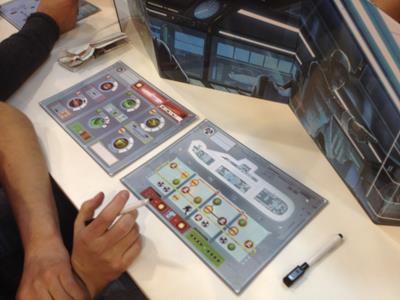
Even more difficult is the crossing out of radiation symbols. On the one hand these symbols do not impair on the availability of the submarine's systems, but on the other hand the reactor does not have an automatic repair function, and the only way to repair all reactor damage is by surfacing the submarine, forcing the Captain to give details on its position to the opposing crew.
So, a surfaing action is one way which will help a crew to pinpoint the opposing submarine, but of likewise importance is the role of the Radio Operator. Whereas the Captain records the position and course of his own submarine on his map, the Radio Operator will record the movements of the opposing submarine on a transparent slide sheet, thus recording the submarine's course without actually knowing its location. However, the Radio Operator will move this transparent sheet around on his own map, trying to align the course with the different islands on the map. The longer the course, the clearer the submarine's position becomes, and this will allow the Radio Operator to inform his Captain about a possibility to attack.
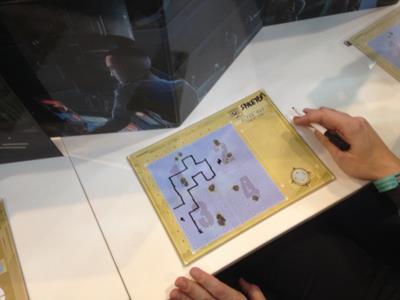
If the enemy (hopefully) has been found, the captain can fire a torpedo (if it is ready) at a space up to four spaces away from his current position, and he will announce the target space of the torpedo to the opposing crew. The Captain of the other submarine then has to cross reference this with his current position, and his submarine will receive two damage if it was hit directly, whereas one damage will be cause if the torpedo exploded on an adjacent space. The mines function in similar manner, only that they are dropped to a position directly next to the submarine, and the Captain can chose to active a mine at any point later in the game, once again telling the opposing Captain the position where the mine is triggered.
As you can see, it is the most essential part of the game to find the correct position of the opposing submarine, and here the two more systems, the drones and the sonar can be of help, since the activation of a drone can check one sector on the map for the presence of the opposing sub, whereas sonar will collect one true and one false information about the enemy's position (row, column, sector).
I have to confess this right away: is very addictive! Especially with a full cast of 8 players the cooperative element has been implemented stunningly well. Each player's role is of likewise importance for the operation of a submarine, and the players in a team really have to cooperate well, providing all necessary information to the Captain in order to be efficient. What is more, the rules are quite easy to grasp, and despite the different roles and systems the game does not really feel complex once the hunt has started. This is of utmost importance especially for the real-time mode, since too complex game mechanics would clog the game pace down considerably. In this respect the game differs very much from one of my favourite real-time games - Vlaada Chvatil's Space Alert. Whereas Space Alert is designed with a steadily rising level of difficulty and rules volume, the basic rules in Captain Sonar remain the same - only the level of difficulty can be adjusted by chosing different types of maps.
All hands to battle stations!!!
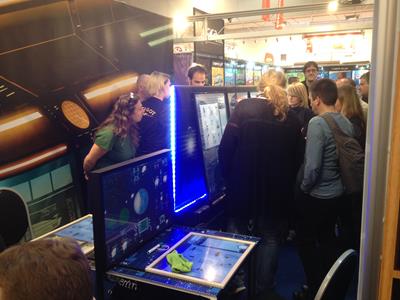
Levaing the booth of MATAGOT around 5 PM, the halls were a bit emptier now and I usually like to use the late afternoon hours to roam the halls in search of any kind of chance find which I can present to you. Once again, this proved to be a good strategy, since I actually stopped in Hall 6 at the booth of a German publisher which was absolutely unknown to me.

So far the Zombie genre for me seemed to be mainly reserved to American publishers. Indeed, CMON's Zombicide has become a benchmark for modern Zombie games, but now designers Florian Müller and Gunnar Sadlowski have decided that the Tombie-Apocalypse needs a German branch. So, they started with a beer and a crazy idea, and from this they developed their new game Totenstadt, a cooperative Zombie cardgame which features many of the elements which we are used to see in series like The Walking Dead
So, each of the players has his own character, and of course the characters have some unique special abilities which may help in the game. They can carry and use weapons and use these against the Zombie onslaught, and the combat results will be determined by the use of dice. Okay, nothing really new up to now, but the things get interesting considering al the extras which can be found in this cardgame.
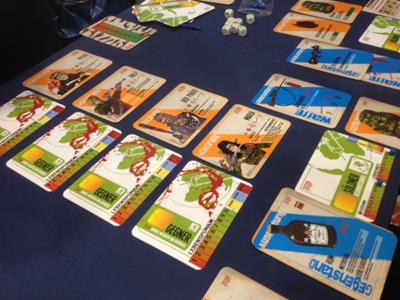
So, Totenstadt actually contains 200 cards, and apart from a handful of characters and many different Zombies there are also landmarks, madmen and other survivors which the players can encounter along the way. Furthermore, the game contains 9 different Mission cards, and so the players will have to follow different targets from game to game. These and other factors convinced me that Totenstadt was designed with attention for details, and so the players do not only have to roll dice and fight, but they will have to think about whether to use firearms (noise!) and how they should spend their ammunition.
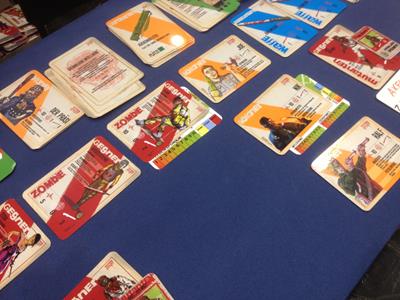
Coming with lots of nicely illustrated cards, especially the deluxe edition of Totenstadt can score with oversized cards and full size graphics. As I was told by one of the designers, the game is getting a lot of positive feedback, and here at the SPIEL many English-speaking gamers are attracted to the booth as well. So far there exists no English version, but this is about to change with a Kickstarter which will start at the beginning of November.
So, if you want to learn more and stay informed about this game, check out the Website of Totenstadt
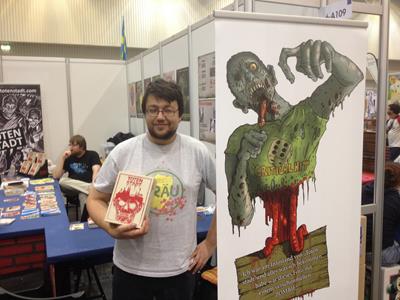
For the end of the day I had been invited by Cedrick to come to the REPOS PRODUCTION booth party, but talking about parties here at the SPIEL there is certainly room for another
Some of my regular readers will have noticed that there was no report on the traditional booth party at FRAGOR GAMES on wednesday. Indeed, Gordon and Fraser do not have a booth for the first time in 10 years, but this is due to a major project which they are pursuing at the moment. However, the two Scotsmen always have been in for some surprising costumes and outfits, and so I have dug up some pictures from various SPIEL conventions. The Lamont's always have made the theme of their new game to the theme of their booth parties, and so there have been some quite hilarious costumes over the years…
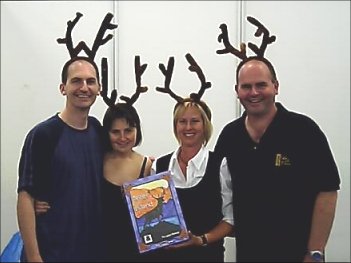
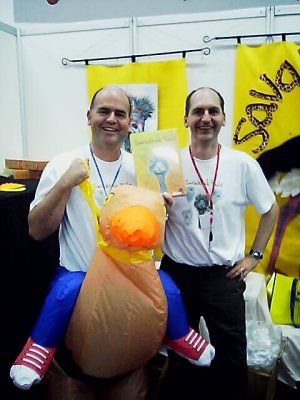
![[SPIEL]](../essen11/ess1152.jpg)
![[SPIEL]](../essen15/ess15072.jpg)
A SPIEL without Gordon and Fraser certainly doesn't feel the same, and so I hope they will be back here next year for another notorious party!!!
But now I am going to leave you for today. I teamed up with Rob van Zyl and headed for the REPOS booth, and there I also found Fabien so that we could have a nice ending of the convention day with Belgian Cherry Beer from Lindemanns!
Prost!!!

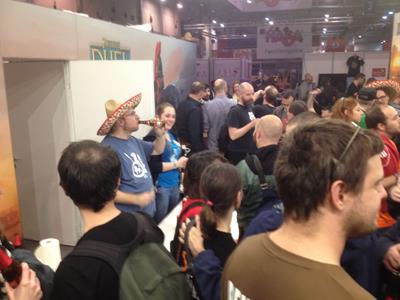
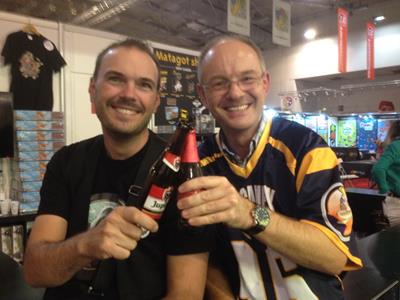
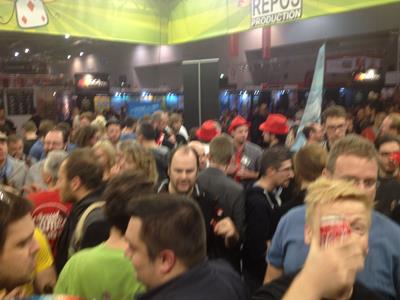

Let the games begin!!!

Today I was greeted by the sun when I left home, and I quickly made my way over the street to the convention area in order to be in the halls before all hell broke loose. In the last two or three years their had been problems with the guards since they had not been instructed to let press people in, but this problem had been solved this year and so I could enter the halls early enough to get some last shots of the quiet before the storm.
Indeed I could catch one last sight of the prepared booths. Everywhere games were ready to be played, and large groups of instructors now were waiting for the masses to be admitted to the halls.
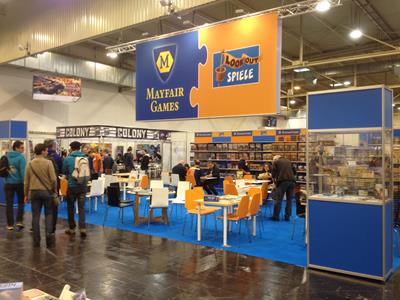
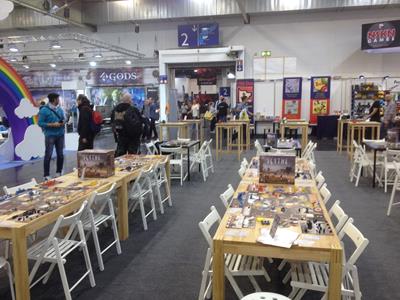
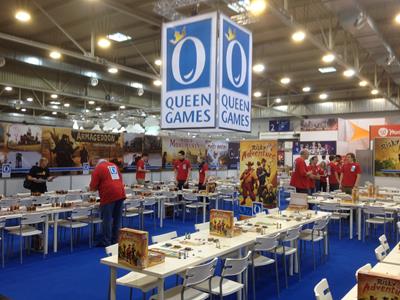

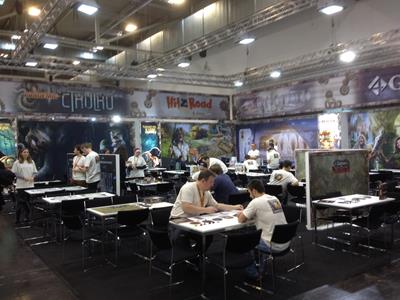
Judging by the traffic jam in the streets around my home a huge mass of people was waiting to be admitted into the halls, and indeed the whole foyer of the entrances was stuffed with people.

Finally, at 10 minutes to 10 AM, the security control of MESSE ESSEN did not want to keep the masses waiting any longer. There was a short announcement that the situation at the entrances required an immediate opening, and then the gates were opened and people were streaming in.


Like every year, the crowd burst in, with some people actually running full speed in order to get the one or other limited game. However, from my perspective there was less hectic this morning, and that's probably due to the fact that more and more publishers of limited edition games now are taking preorders for the show. A good example for this is JAPONBRAND. Like every year, a long queue could found at their booth directly after opening, but everything there was handled orderly and the people were waiting contently.
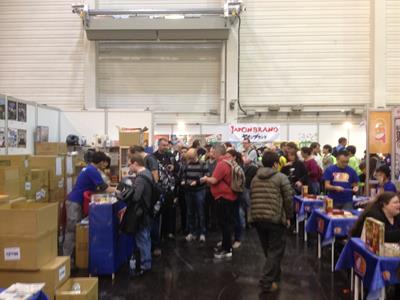
Being in the back halls and having still a bit of time left before my first scheduled meeting, I made my way into Hall 6 where I wanted to say hello to my friend Servando Carballar from Spain. I have been visiting his booth to check out for some unusual new games ever since Servando had designed Luna Llena - Full Moon, and when I arrived at his booth I was a bit surprised that GEN-X GAMES this time had a much more professional booth than in previous years.
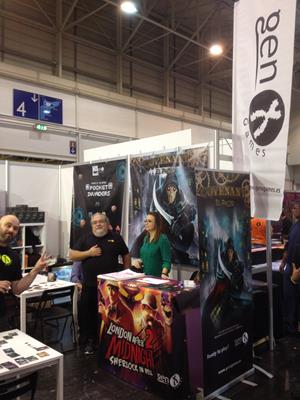
As there was still no demo game going on, I teamed up with designer Oscar Arevalo for a demo of his new game Covenant, a somewhat dark looking cardgame which takes the players into a plot to assassinate the king…
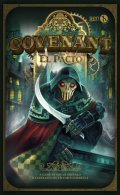
The game features a total of 30 different characters, and during setup a Citizen card for each of the characters is placed faced down onto the table in a display similar to classic memory. However, there exists a second deck of 30 cards which show the same characters, and these cards are the Suspect cards which are shuffled into a random deck. Each player receives a certain number of these Suspect cards as his starting hand, and it will be one of the tasks of the players to find and collect matching pairs of Suspect and Citizen cards and place these pairs in front of them. When the game is over, there will be points awarded for each of these pairs, and further points can be gained from a number of factors, like bonus abilities of some citizens or the biggest collections of citizens belonging to certain classes. However, it is vital for a player to have matching pairs of cards in their own outlay, since even though a Suspect card can be played without the matching Citizen card, it is not wise to do so since the citizen is considered a potential assassin of the king unless the correp pair of cards has been found. The king's assassin is determined at the end of the game when only three citizen cards are left in the common display, and the player who has the assassin in front of himself actually will loose the game automatically.
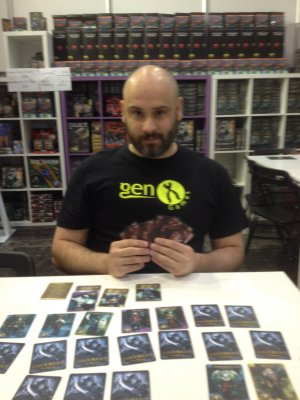
In order to allow for a fluent gameplay, a turn is divided into several important step. The first step is always that a player has to play one of the Suspect cards from his hand and place it in front of himself, placing the matching Citizen card underneath this card is it has already been releaved in the common display. Regardless of the fact whether the matching Citizen card is available, the ability of the Suspect card now will be resolved, and here a number of possibile abilities exist in the game. Some cards allow the revealing of cards in the common display, whereas other cards give an option to turn already revealed cards face down again. Yet other cards allow a player to secretly spy beneath a face down card, and some other more rare abilities also give access to a certain range of other options.
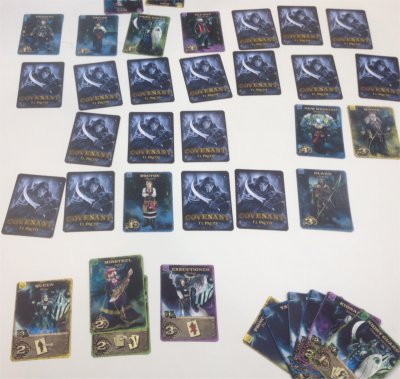
Moving from player to player, a carriage is circling between them, and the playing of a Suspect card also will move the carriage for a certain number of steps. The active player then has the possibility to exchange a character with the player who has the carriage in front of him, and such a trade will be performed against the will of the other player, provided the active player gives either a character of equal or higher value, or provides a character of the same class. This option to exchange characters is highly important for a number of reasons. For one, each player has received a secret mission to collect certain character (classes), and in order to fulfil this mission until the end of the game the players sometimes have to rely on exchanging characters. Furthermore, certain collections of characters will provide bonus points or deductions, and these collections also can be influences through a well placed character trade.
The final phase of each player's turn is the inquest, and in this phase the player first is allowed to check on one of the face-down Citizen cards still in the common outlay, and then the player may reveal on of these Citizen cards - either the same card or a totally different one. By this procedure and the character abilities of some characters the common outlay slowly will be revealed, and the players start to gather the pairs of Citizen and Suspect cards in order to prove the innocence of the characters in their possssion.
The rule that the player who is in possession of the assassin looses the game only applies to a game with three or more players. However, it should be explicitly noted at this point that the game also can be played by just two players. The gamebox and the rules always talk about 3 to 5 players, but one week before the convention Oscar actually finished a working set of two-player rules which we could try today. Of course these rules will be available online, but they couldn't be included in the printed game anymore.
The aforementioned two player rules worked rather well, and between Osar and me a tight duel of intrigue and cunning was developing quickly. In the end-game I tried to win the game by a special rule which allows for a combination of four academical characters, but Oscar quickly countered my move by making a good use of the carriage. At least in this two player variant the game's strategic potential should not be underestimated, and I certainly enjoyed the interesting options which were available from my handcards, since I always had to consider the characters' abilities against the carriage movement which would be triggered by each card.
A nice and very atmospheric cardgame!
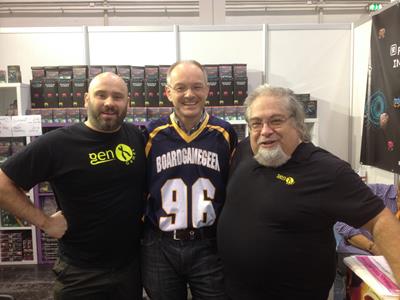
Leaving the booth of GEN-X GAMES, the convention was rather crowded now, and I made my way into Hall 3 where I had an appointment once againt at the booth of LAUTAPELIT.FI. In Hall 3 once again the masses of the visitors were staying, because all the major publishers of family games have their booths in this big hall.
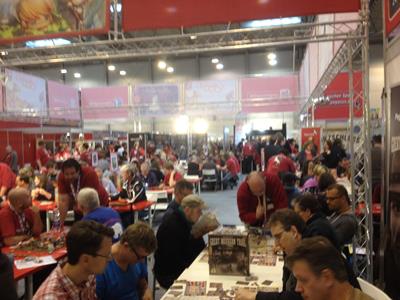
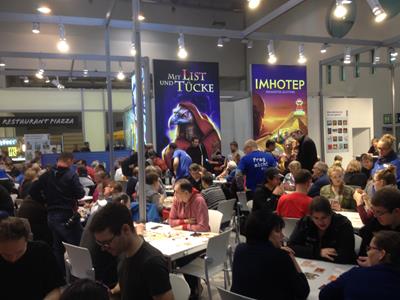
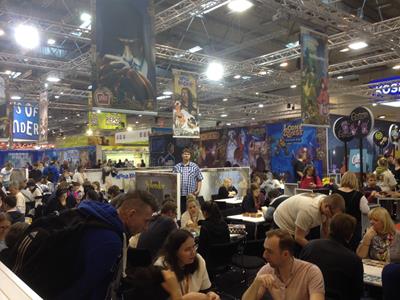
Nonetheless, I made good progress and arrived in time to meet Rustan Hakansson, designer of my former convention hit Nations - The Dice Game. As announced yesterday, I wanted to check out Rustan's newest creation Dungeon Rush, but before we embarked on a test game Rustan actually invited me to come along to the Press Lounge because he wanted to show me some new prototypes. So, we left the convention halls and went into the press center, and indeed it was nice to have a chat in this much more quiet surroundings.
For one, Rustan actually revealed to me that the new expansion for Nations - The Dice Game has been fully developed by now. In fact, the expansion now is being printed, together with the reprint of the basic game for which players have waited so long. The only problem - once again - have been the customized engraved dice, and here once again unsatisfactory production proofs had been clogging the process down. However, Rustan now is hopeful that both the game and the expansion will be available somewhen around Christmas.
The expansion will bear the name Nations - The Dice Game - Unrest, and the name giving factor are new green Unrest dice which the players can gain through some of the development tiles included in the expansion. These green dice bear a lot of double symbols and thus a high production value, but on the other hand there is also an "Unrest" result which the players need to re-roll before they can continue. Thus, unrest may slow a player down in the progression of a round, and due to some other elements in the new expansion such a slow motion may be fatal. Thus, the players now can earn special benefits if they finish their actions first, and of course a player who has to deal with unrest will stand only a slim chance to earn these kinds of benefits.
Rustan gave many more details which I cannot repeat at this point, but one thing is absolutely certain: being a perfectionist, Rustan honed and refined this expansion until every single part fell well into place, and already his description made me long to play it right away. The game will get even more playing depth, and from my perspective this is rather astonishing for a dicegame. Now these Chinese dicemakers really need to speed their production up!!!
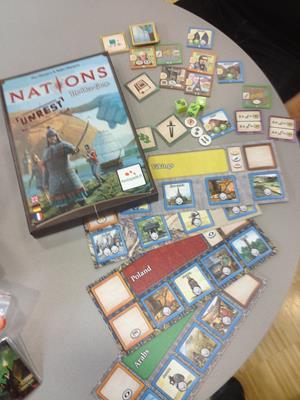
However, Rustan also told me about his most current project during our stay at the Press Lounge, and this actually is something which from my point is rather interesting for many games designers. Being a game designer himself, in previous projects Rustan had often relied on a large audience of testers, sending out prototypes and asking the testers to change the playing materials during the development process. This can be very arduous work, and so Rustan came up with the idea that an online platform specialized to suit a game developer's needs could be a good way to make things easier. Serving as a discussion platform and as a playtesting environment at the same time, there could be great benefits for designers if fitting services were provided, and for this reason Rustan has founded Tea Time Productions. Being inclined to suit the aforementioned needs for a more efficient game development, Rustan wants to offer these services as a free knowledge base. There will also be games which will be published under the label of Tea Time Productions, but the publishing of a game under this label will be no precondition for using the service.
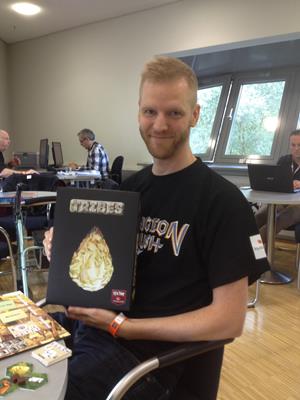
At this point Rustan actually showed me another prototype which he had been working on for some time now. Tribes basically presents itself as a thematic predecessor for Nations, and it will be up to the players to gain victory points by making developments in the development tree on the main gameboard. A rather interesting element of this prototype game is the action chain which consists of several action tiles which are aligned in a row next to the gameboard. Whenever a player takes an action, he has to chose a tile from this chain, and if he doesn't want to take the lowest tile he has to place gold on the other tiles in order to take a higher tile. Well, such an element of payments certainly is known from games like Smallworld, but in Tribes this Action chain becomes more pronounced by the fact that the tiles used by a player are added once again at the top of the chain, and furthermore additional tiles like event tiles also may find their way into the chain and offer the players different types of actions. Just like the expansion for Nations - The Dice Game, the game has been developed to a rather high degree, and it now will only be a matter of polishing especially the artwork until the game will be released by Tea Time Productions.
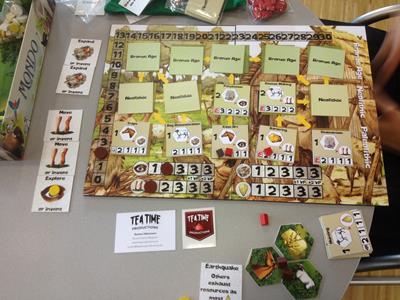
Nearly lunchtime now, so I better speed things up! This should be the best conditions now for a dungeon crawl, but for a Dungeon Rush, so let's see how Rustan's new game feels and plays…
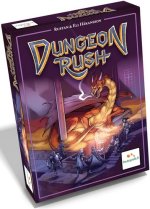
Like every good dungeon game, Dungeon Rush sees the players take over a band of heroes who are out to gain gold and glory. For this game each player receives exactly two heroes (the nicely illustrated cards actually offer opposite genders for each character on both sides), and these heroes always possess a mixture of four attributes: Melee Strength, Archery Strength, Magic and Stealth. These attributes are not given as numeric values, but instead they are represented by symbols printed on the four outer edges of a character card: swords, arrows, wands and masks.
During a round of play, each player will reveal two monster cards from the dungeon deck. All these cards will be revealed simultaneously, and then the players have to check whether their characters fulfil the requirements to slay one or more of these monsters. Once again, the combat strength of a monster is given as a combination of the four aforementioned symbols, and a character can slay a monster if he possesses at least the symbols shown on the monster card.
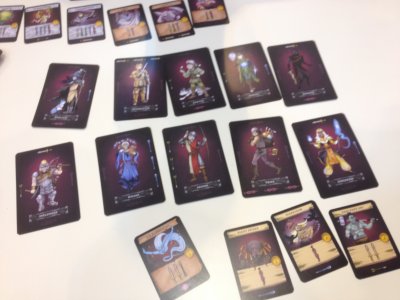
However, here the tricky parts begins. After revealing all monsters for the round, the players actually have to compete in taking the monster cards. "Oh my god, a speed game" some of you may think now, but this one comes with a real twist. So, each of a player's two characters has to be served a monster card with just one hand, and so the player will have to use his left hand for his left character, and his right hand for covering a monster for his right character. This may sound easy, but it is a really tricky coordination task, and the combination of speed and ambidexterity seems to give players who may not have the best speed a possibility to compensate this by a good degree of ambidexterity.
A further level of complication is added by the fact that the slain monsters will provide benefits for a player's character, since they can be put under a character, leaving only the beneficial part visible. In this way one of the character's four attributes will increase, making the character stronger for the future. This does not only come in helpful against the increasingly stronger monsters of the three dungeon levels, but furthermore the end monsters which have been revealed at the beginning of the game also require a specifically trained hero, and so a player will have to think which monsters he should slay in order to gain which benefits - and all of this must be done within a few seconds…
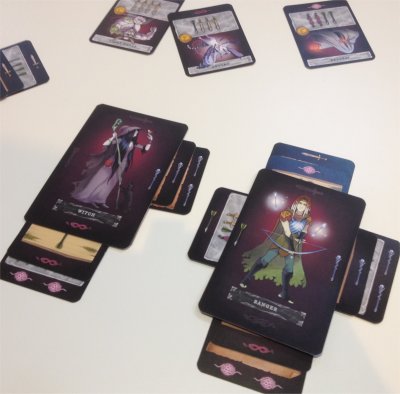
I found Dungeon Rush to be a rather refreshing alternative to other speed collecting games, and especially my left hand hero turned out to be better than I had anticipated. The symbols in the game are very clear, and so the players will not waste time on identifying things, but they can move right into the fray. The game plays very quickly, and due to a limitation to 9 rounds the total advancement of a character is limited so that all the extra attributes do not become unclear. To be honest, I was never too fond of speed games, but this one really is a positive alternative due to the additional ambidexterity required of the players.
With Ralf, Rustan and me marching off to meet for lunch, this leaves time for a…
Well, it's not that I have been lost, but when I looked into my guestbook today I discovered the following post by Henk-Jan van der Ploeg:
|
It's so good reading all of your stories the week and days before I drive to Essen myself on sunday. |
Following the link, I came to the Twitter account of a fellow German gamer named Kerstin, and there I found the following photo:
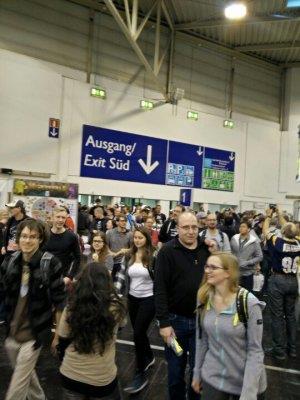
Well, the person with number 96 on the right side certainly is me, and you have seen the photos which I took there earlier in today's report. However, the jury for this year's prize draw (me!) has decided that this discovery of Henk-Jan fully qualifies as a sighting of Frank here at the show, and so Henk-Jan has won a G@mebox Anniversary Promo Card for Legacy!
But now it's really time to eat, and so I arrived with Ralf and Rustan at Korean restaurant in the vicinity of the convention area. Mahlzeit!
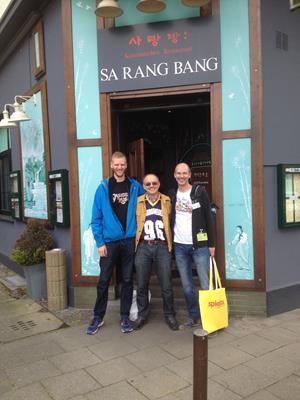

And while we are eating this well deserved lunch, let's check out what Ralf has been doing all day long…
|
Today my day began in a heavy traffic jam. As a local I dare say that I know the surroundings of the fair and I also know the one or other hidden way to get there. But when the SPIEL, the refurbishments of the fair and various diversions around the fair meet all together, there is no chance but queuing. In the picture you can see the exit to the fair. In our local radio they advised to give Rüttenscheid - the part of Essen where we find the fair – a wide berth. As if that would help me in my queue...  So, while others had already played and bought several games, I did not enter the halls before 11 am. So as usual I were in a hurry to come to my first demo session at HORRIBLE GAMES. Playtesting Session: Raise your Goblets (Horrible Games, Booth: 3-O115)
With age drinking games are becoming more and more exhausting and unpopular. So I proceeded to play games about drinking rather than drinking games in the proper sense. And with me, my friends followed, too. It is much more digestible to enjoy a cup of wine or a (home-brewed) beer while playing The Red Inn or Sake & Samurai than being forced to knock back a booze just because you have lost a bet. This applies in particular dimensions when poison comes into play. OK, to poison people with a cup of wine is quite unpopular in our modern times. But in the middle Ages this method shortened the one or other life, especially of a lot of aristocrats... Raise your Goblets is such a game of toasts, poising and flawless etiquette, so the under-title of HORRIBLE GAMES newest game tells us. And indeed it is. Every player gets his own huge plastic Goblet that is filled during the game and must be drunk at the end of a round. Additionally all players get a character card that gives special abilities and a target card that tells us whose character we should poison. 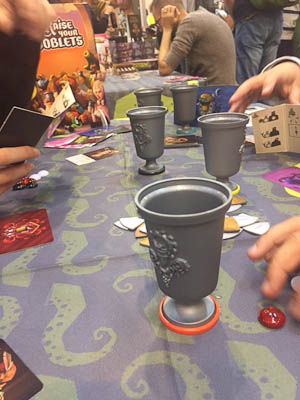 Of course there is no drinking without an appetizer and so all Goblets, which are placed in the middle of the table (so that no one can look inside) are initially filled with a first ingredient. Unfortunately next to the wine there are also two poison and an antidote among those randomly distributed ingredients. All players are also equipped with wine, poison and antidotes that are kept hidden from the other players behind a player screen. 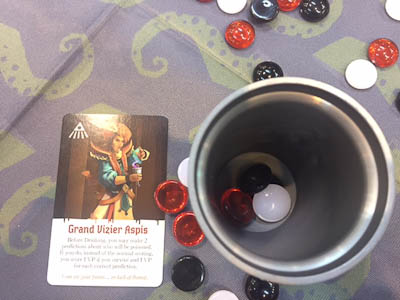 In a turn a player can either pour any of his remaining ingredients secretly in a Goblet of his choice. So more and more poison will end up in the cups. But luckily enough there is also the possibility to peek into your Goblet, which is the one that actually stands in front of you. That is important to know, because the positions of the Goblets will change during the game. A player in turn can either choose the rotate action, moving all Goblets one place to the left or right, or exchange his Goblet with the Goblet of another player with the swap action. This goes on until one of the players calls a toast. This is the moment when the truth comes to light. After everyone had a last action, everyone must drink up his Goblet (again the one actually in front of him). Each antidote eliminates a poison, but if there is more poison that you can adsorb, you are stone-dead. Victory points are dealt to those players who have survived the round, who were successful poisoning their target and who had the most wine in their Goblet.  Three courses (rounds) are served in a normal game. For playtesting we already stopped after the first course, but I guess that all of this could result in a fast, entertaining game with a lot of chances to talk big, tease your opponents and fell a certain mischievous when your opponents find much more poison in their Goblets than they had expected. Because, although it seems to be easy to remember which cup is still “safe” to drink, I quickly lost overview. Raise your Goblets seems to be a great filler or party game for later hours, especially for larger groups (up to 12 players are possible). Maybe you could leave out the special abilities of the characters for your larger groups, because these need some more explanations and so it takes longer to start the game for inexperienced players... So my day started as it has ended: me with a cup of wine. Yesterday celebrating the winners of the DEUTSCHE SPIELEPREIS and today a Goblet in a game. So I thought it to be better to eat some food and so I met Frank to lunch. Coming back the traffic jam outside the fair has vanished, but instead the halls were now crowded. But despite of the many people this year seems to be more room in the gangways, so I had nowhere problems to pass. Probably that is the result of incresasing the fair in gross area more than in net area. 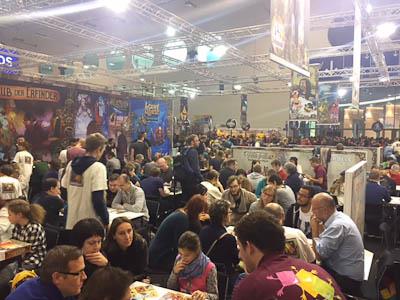 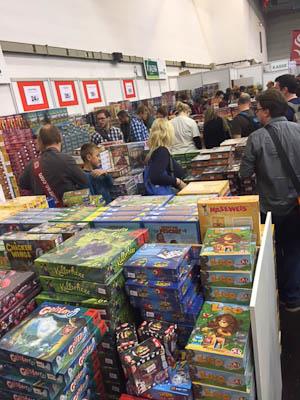 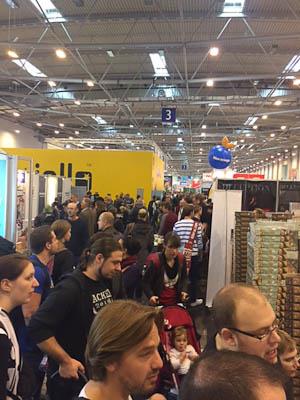 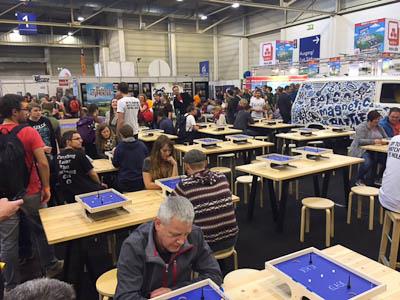 I headed off to my next appointment at Devir. Devir was already founded in 1987 with offices all over the world. Still I do not remember that we ever came in contact before. But last year I saw a demo game of their Holmes: Sherlock & Mycroft and that game had aroused my interest. So I was very delighted when I saw that DEVIR would come with the game again to this SPIEL. In fact it is now the final version and so for me the perfect moment to playtest it. Playtesting session: Holmes: Sherlock & Mycroft (Devir, Booth: 2-D131)
The name of the game is Holmes – Sherlock & Mycroft. I have to confess that I had to look up who this Mycroft was. Although Sherlock Holmes was one of my favourite characters in my youth (well I am a boy...), I am not too familiar with the stories. So for me and all of you who does not know Mycroft: he is the elder brother of the main character and is described to even exceed his brother's ability of deduction. However he is only a minor character in the stories, because he is also described as little ambitious and shiftless. Nevertheless in the game he is the direct counterpart of Sherlock, indeed one player takes the role of Sherlock and the other that of his brother. Both brothers are investigating the same case. But while Mycroft thinks he has found the guilty one for a bomb explosion, Sherlock is engaged by the guilty one's family too prove his innocent. And that is when we begin to play the game: The game lasts 7 days of investigations. Each day a new character enters the game who can then help to find out if the defendant is guilty or not. To be successful it is necessary to find more clues than your opponent. But beware! Not the sheer mass of clues is the key to win, you must be more successful in several disciplines. The different clues are given to us in a clue deck of 52 cards. This deck is shuffled at the beginning of the game. Next to this deck 4 clue cards are drawn and placed visible for both players. As soon as a clue card has been taken, a new one is drawn from the clue deck again. This clue deck consists of 7 different kind of clues, some wild cards that serve us as a joker and 5 map fragment that give players additional victory points at the end of the game. For each type of clue in which you have collected more cards than your opponent at the end of the game, you get victory points (total number of cards minus the amount of clues that your rival holds). 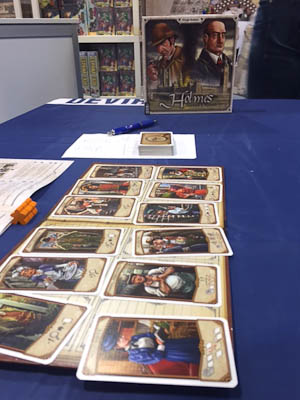 Both players have three action markers for every day of the game. On the first day we already start with five characters who can be investigated. To do so, a player takes one of his unused action markers of this day and places it on the character card he wants to investigate. This action marker is placed laying down, so it is marked as used for this day. Used action markers remain on the character cards until they were used again on the next day (all action markers are put in the standing position on a new day again). No character can be investigated by a player if another of his action marker is on that character, be it standing or lying. Also characters who were investigated by both players in a round (two action markers are placed on the card at the end of the day) are spent for the next day (indicated by turning this card for the next day). Now, what is the use of all those investigating? Well that depends on the character. All characters are different. So the one let you draw investigation markers that can be used with another character to obtain one or more clue cards from the visible line. Some others let you draw clue cards directly from the clue deck (those cards are still hidden) and still others let you steal from your opponent. Exchanging clue cards and discarding them are only two other options you can find on the character cards. 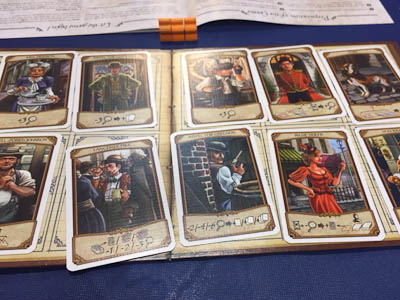 My first thought was that Holmes – Sherlock & Mycroft would be similar to Mr. Jack. But that ain't true. Holmes – Sherlock & Mycroft is much more a card game with the task to optimize your card collection and see how you can harm your opponent on the same time. The illustrations of the cards are really great and so I will try to convince my wife to play the one or other game against me in the following days (after the convention), because I really liked the mechanics of the game. Although the name Sherlock gives reason to expect that the game is very tricky and complex, the weight can rather be compared with those 2player-series by KOSMOS. Maybe I will prove myself worthy to deduct like the hero of my youth. I am quite confident to convince my wife, because the rules are very simple and catchy. And so we still have a similarity to Mr. Jack. There was also another game by DEVIR that caught my eye: Barcelona – The rose of Fire. A game set in Barcelona in the late 19th century. Unfortunately I had no time to playtest it today, but I got a copy to review, so you will hear about it in the following weeks. Again I had to hurry again to my next demo meeting for today, so let us directly continue with this: In recent years CRANIO CREATIONS has published more and more games for the advanced gamers. I still remember the early days at SPIEL, when they presented Dungeon Fighter, a crazy game I truly love. I think this was 5 years ago. Today, they still have those funny games, for example last year's Monster Tower, or the great Unusual Suspects. But next these fun and party games they have developed a serious line of games, games for gamers, too. Playtesting session: Lorenzo il Magnifico (Cranio Creations: 1-A118)
Lorenzo il Magnifico fits the latter line as it is a complex tactical game. It takes place in Florence during the renaissance. In this time a lot of prosperous families in Venice tried to extend their sphere of influence by conquering new territories, sponsoring buildings in the town and bribing famous characters. This all took place under the suspicious eye of the church. Only if you had spent enough money for this institution, you were able to prevent excommunication as a rich man. After I was taught the rules, I must confess I did not know how to start. Lorenzo il Magnifico is a worker placement game, but it is one of the more complex kind. It reminds me a little bit of a Stefan Feld game: a lot of opportunities to get victory points, but you must work hard for the best strategy to win the game. The game takes place on a general board where we can find columns for the four different development sectors (territories, buildings, characters and ventures), an excommunication area, two spaces for activating cards you have bought in earlier rounds, various tracks for VP, military and faith, a lot of overviews and finally an area to place dice that determine the strength of your family members each round. For this strength varies, as the dice are rolled at the beginning of a round. Another hint that you permanently have to adjust your strategy during the game. 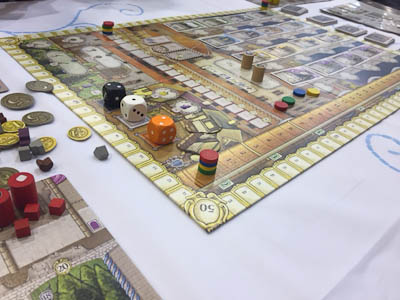 Next to the general board every player has his own personal board to place his acquired territories, buildings and so on. Now in the game the players perform actions along 3 periods with 2 rounds each. At the beginning of each round new development cards of every type are revealed and placed in the appropriate columns of the general board. You can acquire these cards in your turn by placing one of your four family members on the die symbol next to the cards on the general board. But you must also fulfil the requirements to do so. Each action symbol shows the minimum value that your family member must bring along. And this again is determined by the current value of the rolled dice as you will remember. Luckily enough we have some servants, who can increase the strength of a family member (but they are leaving us after that). 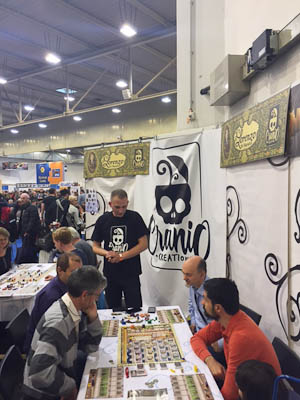 So you gradually develop your dynasty, because all developments give you more variety and powers for later rounds. Territories for example are an important source of goods while characters give you special bonus actions. A lot of cards have to be activated after they were bought. To activate a specific kind of cards you must send one of your family members to the associated space on the main board. The strength of this family member then determines if and which cards on your personal board is activated by this action. You can activate several cards by this, but you must fulfil the requirements of the strength for each of these cards. At the end of a period, in the Vatican report, you have to show your support to the church. With different actions in the phase before you can prove your faith by spending for the institution. But, only if you have collected enough faith points you can prevent excommunication. Excommunication, although ostracised, does not mean you are out of game. But you will suffer a malus that perhaps cannot caught up by other actions... 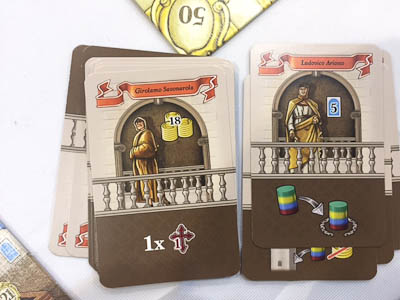 Lorenzo il Magnifico offers a lot to discover. Will you play a decent citizen, who upholds the church? Or will you spare your money and risk an early excommunication? We played two rounds, the first period. Of course I cannot say after this, if the one or other strategy is superior, but from my first impression I would say that different strategies might lead to victory. Perhaps it is more the tactical adaptability that counts. The randomly drawn development cards, the dice that determine the current strength of your family members, the various effects of the excommunication tiles and last but not least the actions of your opponents: all that influences your way to act in the game. A somehow traditional, but perfectly designed worker placement game with a lot of great details, that seems to be Lorenzo il Magnifico. Before I went home to take care of my children, I had a last walk through the halls. In one of the corners I found Tom Delmé from Jumping Turtle Games. He proudly presented me an expansion for his successful last year's Baby Blues. 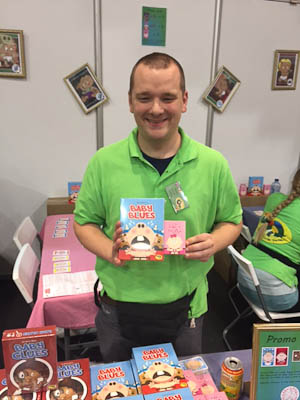 He told me that he is not too happy with the new position of his booth, because in comparison to last year very few people reached there. Also last year he was very close to BGG which probably influenced the buzz of BGG where the game was temporarily in the TOP 5. But I hope that will change the next days, because I really love the base game, although it is very simple and not really a gamers game. I play it with my children and parents likewise. According to Tom the expansion is more tactical, has a new 2 player modus, but for me most important expands the game for the fifth and sixth player. After all this baby crying, I hope that my children will let me sleep tonight. See you tomorrow again! |
One of the nicest things of the convention week is that each day I am meeting friends, and today Melanie and Michael, and Johannes from my gaming group as Cologne visited the SPIEL together with a few friends. Due to my rather filled schedule we couldn't spend much time together, but at least we could arrange for our next gaming evening.
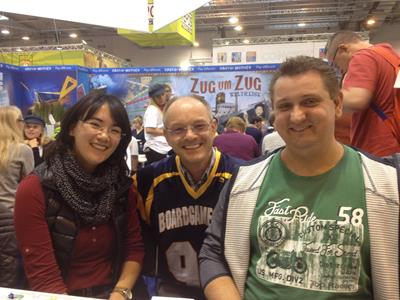
Another pair of friends I met in the vicinity of the Boardgamegeek booth. I had been looking for Brian and Dale Yu yesterday already, but we had missed each other somehow. However, today the time had come for our annual reunion photo, and once again we celebrated the rare occasion that the editors of The Opinionated Gamers and Kulkmann's G@mebox actually are on a convention on the same site of the Atlantic.
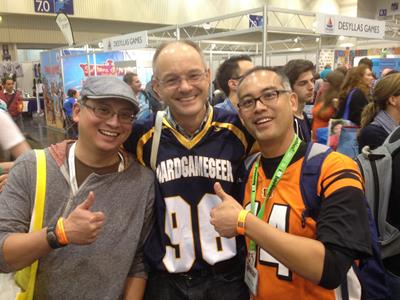
Well, time passes quick here at the show, and I guess I will have to continue with my afternoon playtesting sessions, because otherwise I won't sleep at all this night. So here we go!
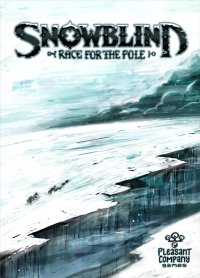
One of the most thrilling and tragic races in the history of mankind was the race for the South Pole in 1910. Whereas Roald Amundsen was the first the pole with his expedition, his rival Robert Falcon Scott reached the pole one month later, and Scott and his expedition team perished on the way back, only a few kilometers before their disembarkment place. Back in 2013 this historic event already had been the thematic background for the game 1911 Amundsen vs Scott by Perepau Llistosella, but now a new team of explorers will be sent to the pole in Simon McGregor's Snowblind: The Race for the Pole.
Two years ago newcomer publisher and artist Rob van Zyl had made a successful debut with his publishing house PLEASANT COMPANY GAMES, releasing the pulp horror dice chucker Ancient Terrible Things at the SPIEL '14 convention. As it seems, both Rob and Simon have grown fond of unusual dice games, and so Snowblind once again is a game in which the players have to use multiple kinds and colours of dice. Rob had kindly reserved a table for me today to try their new game, and so me and my team of explorers begun our long voyage to the pole.
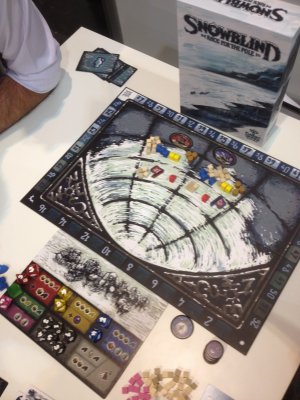
Up to four players can compete in the historic race for the pole, and during the game the players will try to earn most prestige by bringing their flag as close to the pole as possible, by gaining Medal and Research tokens and by keeping their crew and equipment intact. Each players starts the game with his Team Flag, his Captain, Scientists, Sailors and a number of crates and barrels in the two zones furthest from the pole, and it will be the Captain's task to get as close to the pole as possible in order to place the flag there.
In many dice games you will find a mechanism which demands the players to roll a number of dice and then make their actions according to the rolled results, but in Snowblind the mechanism actually is the other way round. So, depending on the actions the players wish to perform, they take an available dice from the fitting action on the Action board and add the dice to their dice pool. Then the player is allowed to perform the corresponding action, and this usually will be the movement of explorers and equipment in different combinations. However, after the action has been performed, the player has to roll all dice in his action dice pool to check for weather exposure, and the fewer explorers can be found in the target zone, the easier the present explorer(s) will fall victim to exposure. So, each dice showing an exposure result will force the player to spend equipment tokens available in the zone, and if all equipment has been used the player only can exhaust his explorers, making them lie down until new equipment has been brought to the zone. However, if there are still some exposure results left, the exhausted explorers will perish, forcing the player to remove them from the game.
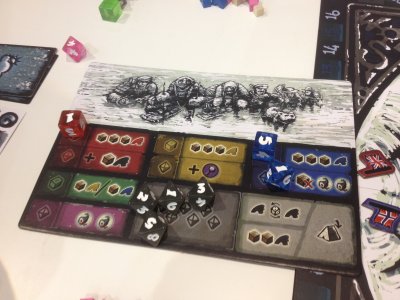
As can be seen, during a round of play the players have to balance how many actions they will dare to take. Each new action will add a new dice to their dice pole, and so a player who hurries towards the pole actually faces a much higher threat of losses due to exposure. It is even possible for a player to take special actions with higher benefits, but taking one of these actions is associated with a higher numbered dice, and so a result of exposure gets more probable if such a dice has been added to a player's pool.
A round of play ends when all players a passed on taking more actions, and now all dice will be returned to the Action board. However, in order to simulate the nasty weather conditions close to the pole, a Weather card is drawn at the end of each round, and now each player has to apply an additional exposure check based on the card's value to an occupied zone which is closest to the pole. In addition, the deck of Weather cards also serves as an end game timer, since the deck contains a Pack Ice card which will trigger the end of the game.
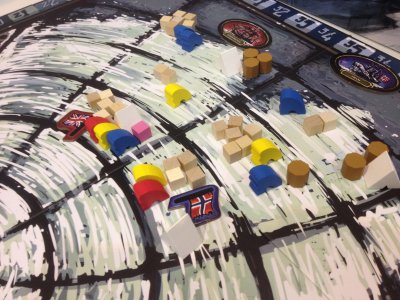
Even though there are some possibilities like hunting for food or placing a camp which can make it a bit easier to face exposure, Snowblind: The Race for the Pole can be quite brutal if a player has bad luck when rolling for exposure. If the Captain is lost, a player even is removed from the game, but this sudden death is tolerable due to the comparatively short playing time. However, this result can be avoided by players who keep a good balance between speed and care, provided the other player does not make haste and tries to push forwards even harder. In these cases the explorers will be pushed to their limits, and the last leg to the pole may prove fatal if not enough provisions have been provided to reduce exposure results. In summary, the game stands as a rather nice representative of the category of "Press Your Luck" games, and the feeling of the history race really is conveyed rather well.
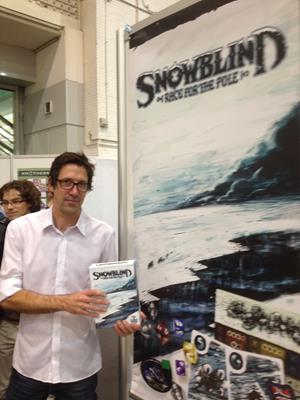
Getting ready to leave Hall 6 for a meeting with Ignacy Trzewikzek, I took a different corridor and came by the booth of the Hungarian publisher BOHEMA GAMES. The comic artwork of the booth made me stop and take out a closer look at their game Survivory, and even though my first impulse was the think "Yet another Zombie game?, I asked manager and game designer Hedvig Bartha to give me an overview of the game.
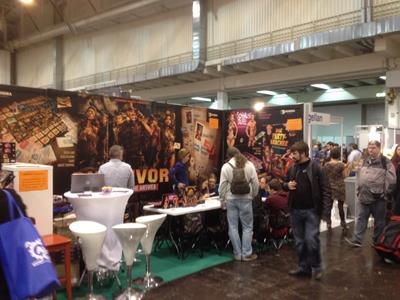
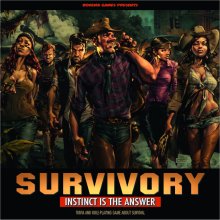
Indeed, the game Survivory partly IS a Zombie-game, but only in so far as a Zombie-outbreak actually is one of three possible scenarios which can be played in the game. The other two scenarios, a plane crash in the jungle and a blackout in winter, share the same general setting that the players partly cooperate and partly compete to survive under these circumstances, and in the end there can only be one winner of each scenario since only one character will be rescued.
Well, this may still sound like a classic adventure game, but while Hedvig explained to me the basic rules of the game I had to discover that Survivory is not what I would have expected on first sight. The game actually has two phases, outfitting and the adventure, and the first of these phases actually is resolved by the player characters moving around on the outer part of the gameboard in order to collect different parts of equipment. This moving around is a bit like Talisman, but things get strange when a character lands on a trivia space. Now the player will have to answer a question relating to a dangerous situation, and if the question is answered correctly a piece of equipment or another benefit may be gained. Gaining equipment in a trivia game? That certainly is a new approach to me, but as strange as it sounds this actually is a fresh idea. And, if the players chose the Zombie scenario, there will even be trivia cards relating to the Zombie genre…
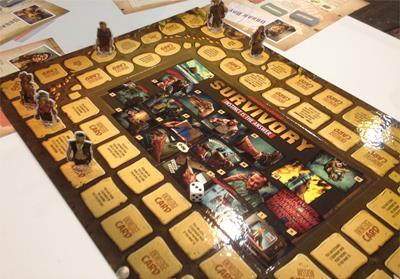
However, things get even more strange when the game moves into the second phase. Now the players go through the adventure of the chosen scenario, and this is represented by a modular board with comic graphics which has been placed in the middle of the gameboard. Moving from scene to scene, instructions will be read from a scenario book, and the players will have to solve the arising situations as good as they can. They have to use equipment, but actually the players are invited to do all this in role-play style, trying to live through the adventure by acting in accordance with their chosen character. However, despite the combined efforts, one by one the player's will drop out, and if some actually should reach the last scene only one player will be rescued…
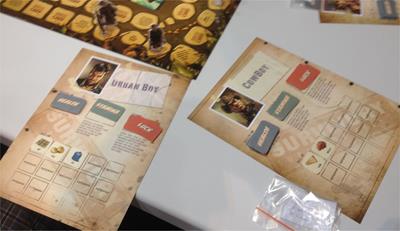
One thing is certain, Survivory easily is one of my the strangest SPIEL finds in years. Trivia meets role playing - what an unusual combination! Talking to Hedvig, she told me that she wanted to create a game where the player can enjoy themselves, and she has chosen these specific scenarios because they are actually quite topical at the moment. Hedvig admitted that the game certainly is no strategy game in the normal sense, and I guess that it true because the players hardly can follow a tactical approach under these circumstances. However, I think the value of the game depends on the eye of the beholder, since it must be questioned whether this game really is a normal boardgame, or whether it actually fits much better into the category of event/party games or riddle games which do not follow classic gaming rules either. Hedvig emphasized the point that the players are encouraged to enjoy the game in an atmosphere enriched by role-playing, and from my perspective this unusual concept certainly may be worth a try…
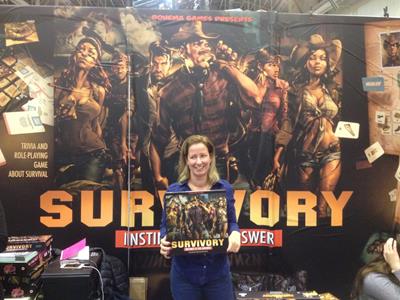
After this trip into the world of survivalists the time for my meeting with Ignacy had come, and so I hastened over to Hall 3 in order to meet him at the booth of PORTAL GAMES.
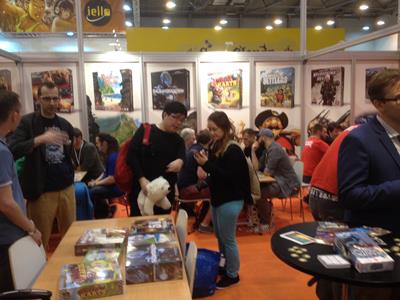
Ignacy and I know each other ever since his first appearance here at the SPIEL back at 2009 when he presented his new game Stronghold. I had introduced myself to him at that time, but it's actually quite interesting to see how my reviewing activities are seen by him. So, it's definitely time for another
![[SPIEL]](../essen09/ess09115.jpg)
Apart from designing and marketing games, Ignacy also is writing all kinds of articles in his blog about the world of boardgames. Back in 2014 he has published a book which gives a digest of the most interesting articles he has written: "Boardgames that tell Stories". I have been loosely following his blog over the years, and when Ignacy published his book I contributed a short article about reviewing games. In return I received a copy of the book when it was finished.
![[SPIEL]](ess16134.jpg)
One day during my holidays on Crete I was reading about Ignacy's presentation of Robinson Crusoe - Adventure on the Cursed Island at the SPIEL convention, and it was quite surprising for me to come across my own name. Ignacy updated his blog on a daily basis during that show, and he had written a paragraph about my visit to his booth. It was actually quite funny for me to see how Ignacy has perceived our meeting, giving me a chance to go through a meeting with me through other people's eyes. In fact, these few lines may give you a rather nice impression why I usually need a rather long preparation phase ahead of the SPIEL, and - with Ignacy's permission - I am going to reproduce them here:
![[SPIEL]](../essen14/ess14003.jpg)
Day 1 - Thursday, 11:00 AM. Frank.
I have a demo game of Robinson scheduled with Frank Kulkmann. For those of you who may not know it - Frank is one of the most famous and respected German reviewers. He runs an amazing website at boardgame.de and year after year he reviews dozens of games that are released in Essen. His Essen reports are extremely popular in Germany. During the four days of the Essen Trade Show he plays tons of games and reviews them right during fair.
How is it possible?
Frank reads rulebooks before the fair. He doesn't waste time by letting publishers explain the game to him. He just sits and plays. He's prepared. He's a professional.
So, Frank comes to our stand. He sits to Robinson with two other gamers who were also interested in trying Robinson and... starts to explain the rules to them. Just like that, he sits down and he teaches them how to play. I try to help, but Frank says that he can handle it. I can go to the second table to present Robinson.
Yes, Frank is a pro.
Sitting on the beach of Kato Zakros, a small hamlet at the end of the world on the eastern shore of Crete, this meeting with myself had been extremely delightful. For me it showed that all the work I put into my hobby of reviewing games is really appreciated, and apart from occasional meetings and discussions with you - my readers - it is this kind of stories which urges me to go on with my Essen-reporting after all these years…
But now, let's return once again to the SPIEL '16, and today Ignacy actually told me some news concerning PORTAL GAMES. Just a few weeks ago PORTAL has set up its own German branch, and under this label PORTAL now actually will produce German versions of games which have not yet been released in German. One of these games is 51st State, and the new 51st State Master Set now actually is available as a German version here at the SPIEL. Other games like Cry Havoc will follow soon, and so German gamers actually can be hopeful that those titles from PORTAL's portfolio which have not found a German distributor now will be available in German versions.
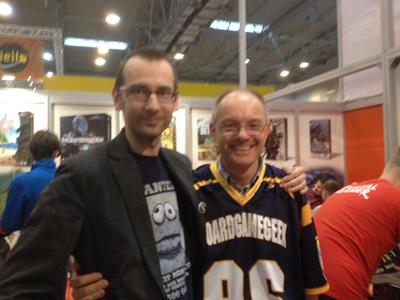
Incredibly enough, Ignacy and I even had a bit of free time to play a game, and so we embarked on a duel for the Tides of Madness, a two player game which is fashioned after the successful Tides of Time. And indeed, both games share the same basic structure: they are played over 3 rounds, some cards are kept, some cards are removed, and the players draft new cards in order to get combinations allowing them to score at the end of a round.
However, the Cthulhu'ish setting actually brings along one new factor - Madness Tokens. For each Madness location a player has kept at the end of a round, the player receives a Madness Token, and if he ever should end a round with 9 or more Madness tokens that player falls instantly insane and has lost. There is a way to get rid of these tokens, but it is most important that the players keep an eye on the Madness cards during drafting. In this way the Madness tokens add a new layer to the game which was not included in Tides of Time, and the fact that the players know about the madness cards in the other player's outlay bring along some interesting possibilities to try to push the other over the brink of sanity.
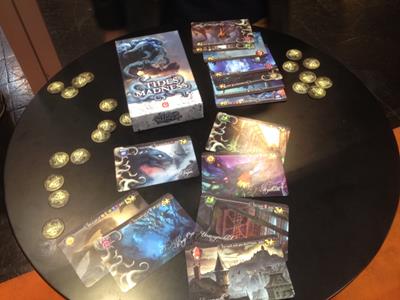
The afternoon had passed incredibly quick, and so I was marching to ArRTIPIA GAMES in order to meet with Vangelis Bagiartakis from Athens who I had already met yesterday at the novelty show. I wanted to check out his new game Fields of Green, and once again I was lucky that Vangelis had reserved me a space at a table where the game was about to start.
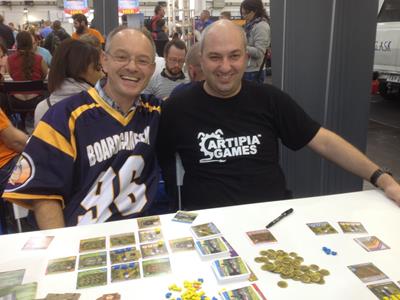
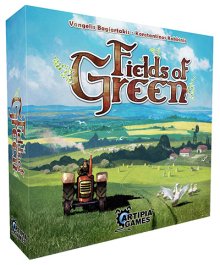
Back in 2012 ARTIPIA GAMES released Among the Stars, a science fiction boardgame which was also designed by Vangelis. In this game the players strive to build the biggest space stations, and the game could score with a very nice combination of drafting and tile placement rules. So, the players used a drafting mechanism for getting new parts for their space stations, but instead of simply placing these tiles in front of themselves the tiles had to be added to the space stations, following layout requirements like layout, energy production etc..
With this combination the game was one of the first games to combine these two major playing mechanisms, and indeed it found so many fans that a good handful of expansions was released in the years to follow. However, as it seems the success of the game has kept Vangelis thinking of how these playing mechanisms could be improved even further, and in 2016 he now presents Fields of Green, a game which employs the basic mechanisms from Among the Stars and enriches them by a new level of playing depth.
As the title implies, Fields of Green is a game about farming, and so each of the players tries to build the most successful farm over a duration of four years (rounds). During each round of play, the players will draft a number of Farm cards showing buildings, fields etc, and these cards either can be added to the players' farms (if the player can afford the costs of the card), they can be exchanged for a generic card showing a Water Tower or a Silo (needed to store Water and Grain), or a drafted card even can be discarded in order to gain some money.
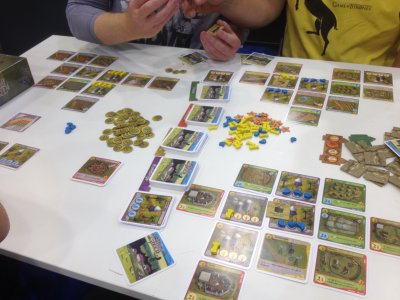
As indicated, the cards which have been added to a player's farm are not just placed in front of the players, but instead one of the players' main challenges is that they must plan the layout of their farms as careful as possible. So, some cards may require water in order to provide a harvest, and a Water Tower only may be up to two spaces away if it is supposed to provide water for the tile. Food on the other hand can be brought over an unlimited distance, but of course the players will have to make sure that they have enough water and/or food at hand in order to activate their Farm cards.
Talking about the activation of Farm cards, this depends on the type of the card. Three different types of activations exist, and so some cards will provide an instant benefit, whereas other cards may bring benefits during the game's end scoring. However, the most common type of activity is a harvest ability, and this ability triggers by the end of each round. At that time the players are allowed to use cards with the harvest ability in an order of their liking, and so the players can try to build large production chains in order to maximize their profits.
The most efficient way to gain victory points is to build Farm cards which provide an end game benefit (buildings), but these cost a lot of money and so a player has to make sure to gain enough money by selling crops and livestock. However, crops and livestock do not grow by themselves, but they need water and food, and so the players also will have to make sure that they have access to these basic resources in order to keep their farms going. In the end, the player who is most successful in juggling between these different factors will win the game, and it will certainly take a few games before a newcomer has a chance to win against a seasoned player because not all combinations and abilities will be apparent for a beginner.
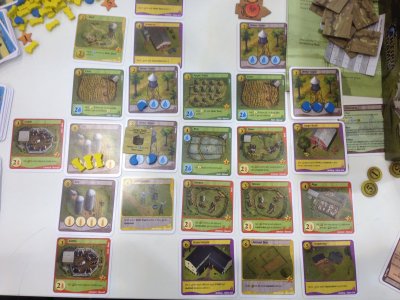
As seasoned Among the Stars players will notice, all this will sound vaguely familiar, and so the question may be asked where Vangelis actually has added new content to the older game. For one, he has enriched the drafting mechanism by a new level of difficulty, since the players now can decide how they would like to compose their starting hand at the beginning of each round's drafting process. So, there are four different piles of Farm cards available, and each player is free to take his hand in any combination, as long as there are cards from at least 3 of the 4 piles. In addition, the players will take they starting hands one at a time, and so the later players in player order actually will know what types of cards the earlier players have taken, and this gives them a possibility to estimate which cards they may get during the drafting. All in all, this new layer slows the traditional drafting mechanism down a bit due to an increased period of thinking, but on the other hand it opens up some interesting room for planning and speculation which the players can explore.
The second real innovation which can be found in Fields of Green is the availability of Equipment tiles. The players actually may chose to discard a drafted Farm card in order to purchase an Equipment tile, and these tiles can be used to improve the functions/abilities of one of their already placed Farm cards. This may open up nice windfall effects, and so the design of a player's farm can greatly profit from the clever use of Equipment tiles.
As can be seen, Fields of Green really is not just a re-theming of Among the Stars, but it takes the basic mechanisms onto a new strategic level. The game is a rather good example for the fact that a clever playing mechanism easily can be turned into something new by making some well-placed additions, and indeed even true fans of Among the Stars should be tempted to try this hardcore variant of their favourite game!
And with this great gaming session I would like to end today's report. I once again teamed up with my friends Melanie, Michael and Johannes from Cologne, and together we left the Halls of Gaming for today!!!
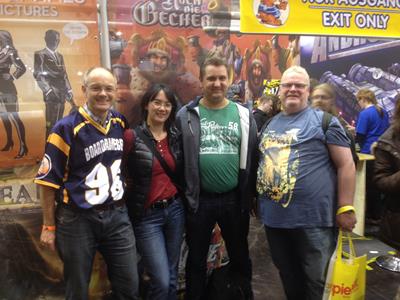
Game on!!!
SPIEL '16 Press day - we are nearly there!!!
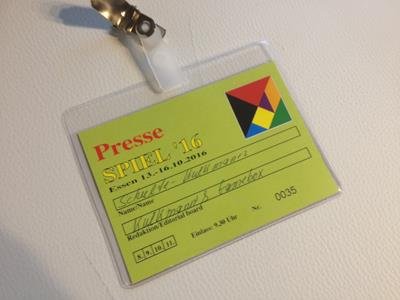
Wow, so far this week has passed incredibly fast, and today the official part of the convention had already begun. In a way I am looking forwards to the public days starting tomorrow, but on the other hand the buildup phase always is something special, since many of my friends from all over the world actually have more time for a chat, and furthermore I have more time to talk about events and stories in the run-up to the convention.
Anyhow, be that as it may, here we are: It's Wednesday, and I had to be at the press conference at 11.00 AM. However, last night I finished early at around 1.30 AM, and so I was actually up and around early enough to take another stroll through the halls, checking how everything was going.
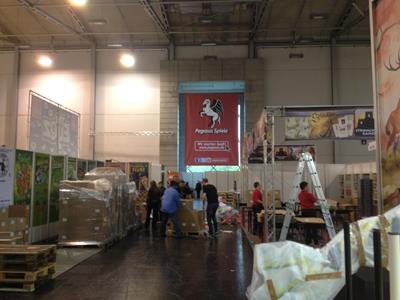

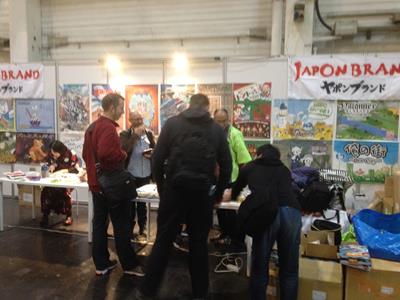
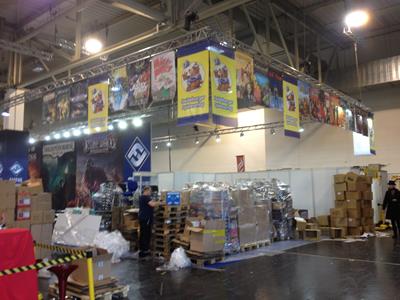
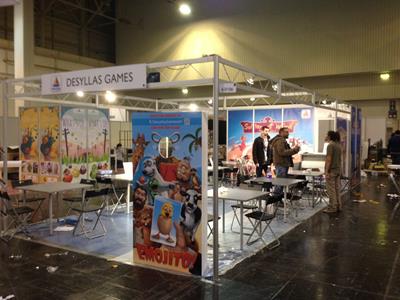
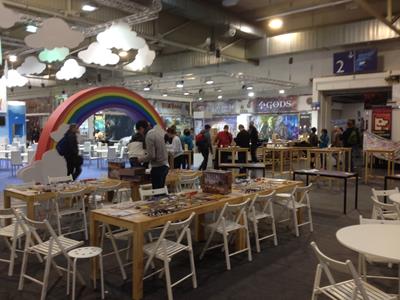
My nicest chance meeting for the morning certainly was Ignacy Trzewiczek and his wife Merry from Poland. I have known Ignacy ever since his first appearance with PORTAL GAMES here at the SPIEL, and just like my friend Cedrick with REPOS PRODUCTION Ignacy's publishing house also has grown quite a lot. Today I met them busy setting up the booth of PORTAL GAMES, and this year their booth actually had been incorporated into the larger booth concept of PEGASUS SPIELE, their german distributor. It's interesting to soo how the big distributors PEGASUS, ASMODEE and HEIDELBERGER have started to "collect" many of the small publishers for their portfolios. Here ath the SPIEL it is clearly visible, since the distribution partners are occupying large connected areas, and I guess that such a big market needs these kinds of distribution giants in order to guarantee small publishers a sensible distribution concept.
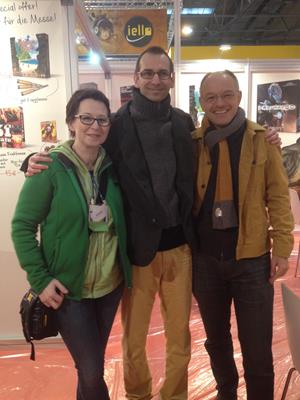
After this I made my way up into the press center where the press conference, the first event of the SPIEL '16, was about to start. Here I also met Ralf, and as announced he will now be joining the coverage for the rest of the event. However, before Mrs. Metzler from MERZ VERLAG opened the conference, we first had a few minutes for refreshments. Boy, running around in the halls always makes me hungry, and so a quick bite really came quite handy…
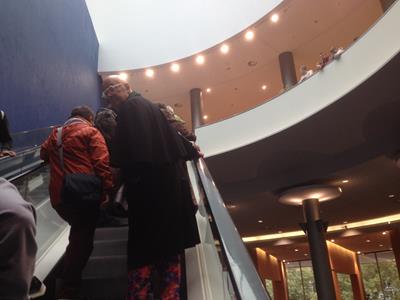

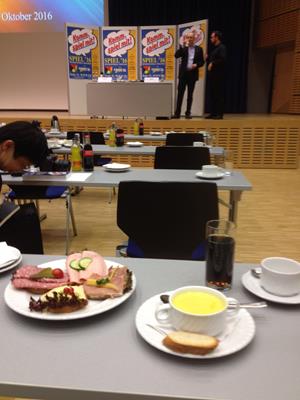
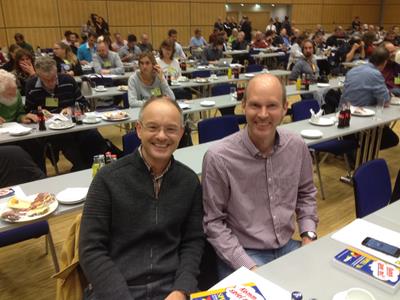
As every year Mrs. Metzler presented to us the sheer facts of the show, and I have to confess that the numbers impressed me quite a bit. After 911 exhibitors last year, this year will see 1021 exhibitors coming to the show, and these come from 50 nations all over the globe. The quote of foreign exhibitors now is as 60 percent, clearly demonstrating that the SPIEL really has become an international event since its humble beginnings back at 1984. In fact, the games market seems to be growing ever faster, since the exhibition areas used by the exhibitors had grown by 58 percent just in the four years since 2012. So, with a view to the director of the MESSE ESSEN and the ongoing refurbishments Mrs. Metzler announced: "Make faster guys, we need the refurbished halls!" Even the hotels here at Essen seem to be caught in the growth of this convention, because somewhen last week all Essen hotels have announced to be fully booked.
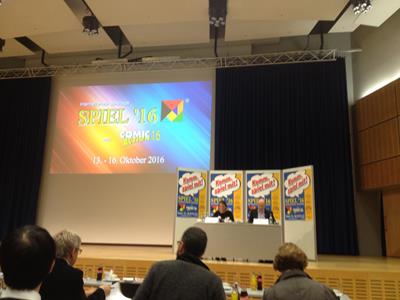

As a born "Essener" I am somewhat proud that I experience this development for all these years, ever since my first visit to the SPIEL in 1985 when I was 11 years old. Before I started this webpage I actually have written articles for a school newspaper about the show and my first visit to the SPIEL back in '84 also needs to be covered in a
Back in 1985 my parents allowed me for the first time to visit the SPIEL on my own, and during that great day I had played Jean's de Poel's game The American Goldrush 1849 at the booth of HISTORIEN SPIELE. I still remember that the booth had been located in Hall 12 which is now being refurbished, and the fair was still much smaller since it only covered Halls 10 to 12. However, I was rather taken by the game, and after going home to ask for an increase of my allowance I happily returned to the SPIEL to buy the first boardgame on my own. In the year 2011 I once again found this old game here at the SPIEL. My own game was packed in a tube and not in a box, but it still sits in a cupboard back at home.
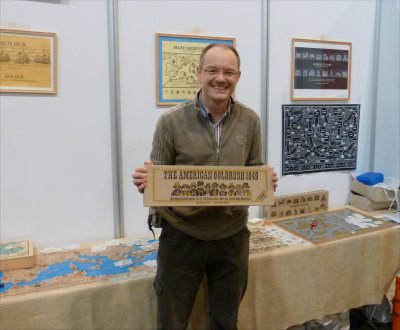
A characteristic of all games from HISTORIEN SPIELEGALERIE is that they are handmade, with lots of wooden components and with gameboards made from a leather-like material. The American Goldrush 1849 is no exception, and as a child I was fascinated to have a Wild-West themed game in which I could go and dig for Gold, buy stuff at the General Store and challenge other players to a shootout. While moving through the claims, you have to keep an eye on your provisions, because a player who runs out of provisions will starve and has to start anew while leaving all of his former possessions on the gameboard to be picked up by any other player. In fact, most of the action on the gameboard is determined through random events which may turned up while mining a claim, and this fairly easy mechanism even made me program a computerized version of the game. Back at that time I have a Commodore 64 (block graphics, 16 colours, 64 K of Ram - some of you still may know these old "breadboxes"), and after spending two or three months of encoding I had it running…
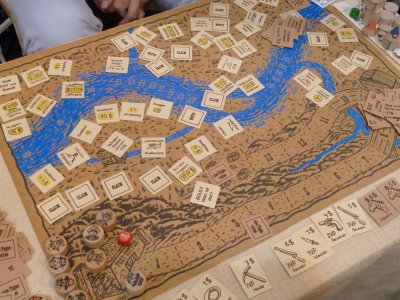
After this flashback let's return to today's press conference where a few other facts are still waiting to be revealed. 1200 (!!!) new games will be released at this year's SPIEL, and as Mr. Hutter from the Association of German games Manufacturers could confirm, not only the number of games realeased is increasing, but also the sales. Once again the sales volume of the industry has risen by 10 percent in comparison to last year, and in the children's games sector alone the growth amounts actually to 18 percent.
However, the press conference ended with a bang when two rather big innovations where revealed. One of these stands in direct relation to the SPIEL, since for the first time there will be a Parcel Service located in Hall 7. So, visitors of the SPIEL now can actually go there with the games they have bought, get them boxed and pay for shipping back to their home countries. That's something I am always doing for friends visiting the SPIEL, but for visitors not familiar at Essen it's really a great service that they now can send their loot home directly form the SPIEL
The second innovation is a mobile app named Twiddle - Let's Play. Developed on behalf of the Games Manufacturing Association, this app actually serves as a database and contact market for gamers all over Germany who are looking for a gaming round which they could join. Well, there is always a certain inhibition when it comes to releasing too much personal information in the internet, but nonetheless this sounds like a useful tool for gamers who are really looking for new friends or a gaming event in a foreign city.
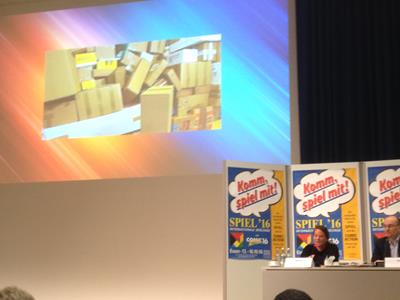
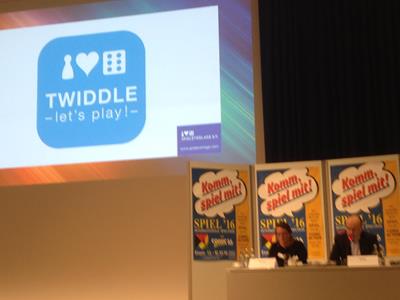
Keeping tradition, Ralf and I made our way to the novelty show after the press conference. So, we went down into Hall 1 A where the novelty show had been relocated to in order to have more space, and even though the following photos may look like the the whole convention might have started, everybody you see on this photos was there either as an exhibitor or as a press representative. Television, Radio, local and nationwide newspapers, video reviewers, bloggers - everybody was there….
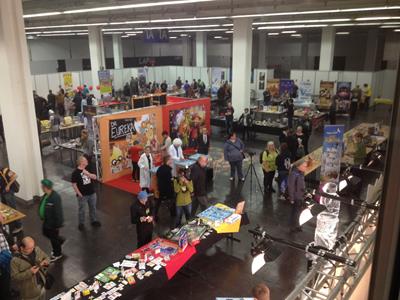
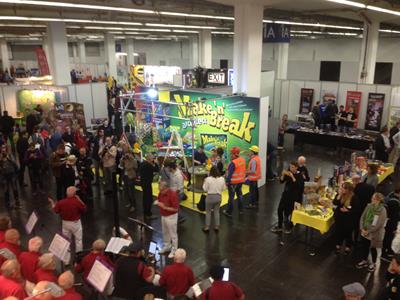
Depending on the budget of the individual publishers, the novelty show always is a bit like a funfair, with some games being presented by peoples in costumes at elaborately decorated stalls. Today's most unusual presentation actually was for MATTEL's Pirate game Sail Away, since MATTEL actually has brought in a whole chorus which was presenting a wide range of shanty songs. What an echo down there in the catacombs of Hall 1A…
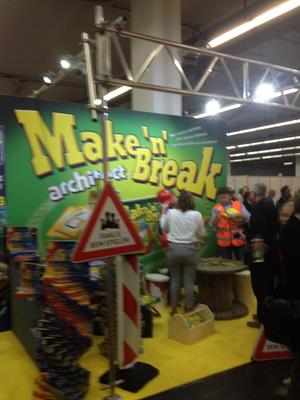
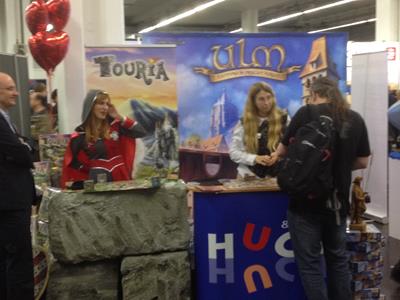
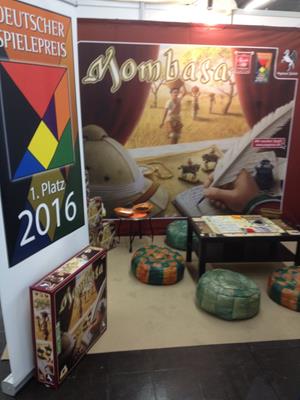
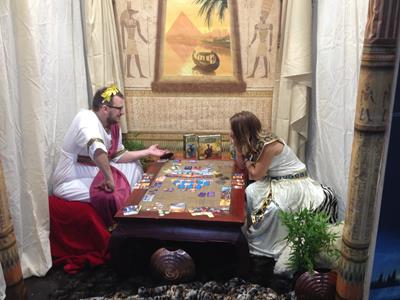

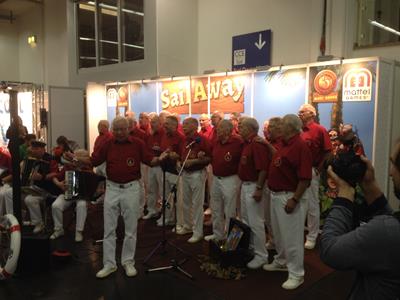
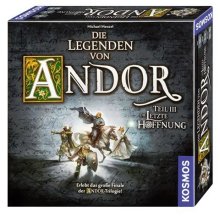
In the novelty show I actually met Michael Menzel, designer of KOSMOS very successful Legends of Andor series of adventure boardgames. This year the series will be finished with the release of Die Legenden von Andor - Die letzte Hoffnung, and as Michael told me he really intends this box to be the last chapter in his epic work. The box contains a total of 7 legends which can be played through, and everything will end in one great final legend which contains a number of cards similar to Der Sternenschild. This legend will tell the epiloge of the whole story, but until the players have reached the epiloge they will be able to experience a bunch of new adventures and mechanisms.
So, instead of a castle printed on the board the players "homebase" now will be a wagon. This wagon is mobile, and when enemy figures are closing in the players actually can try to escort the wagon out of danger. A new kind of threats will be the skeletons, since these actually move after the player characters, and whenever a skeleton reaches the figure of a character that character will be frozen in place until the skeleton has been defeated. Seasoned Andor players now may fear that the slaying of skeletons greatly may speed up the game, but there is actually a possibility to stun a skeleton without removing it from the board. The innovations are manifold, and so now character possesses a horse which he can use to transport other characters, and furthermore the use of money has been abandoned (after all the story plays in desolate lands) and was replaced by items the characters find and manufacture.
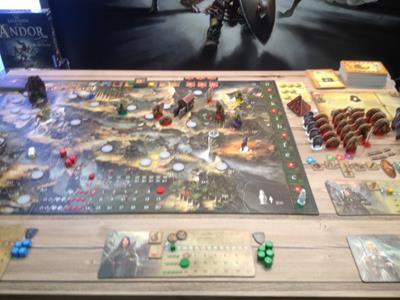
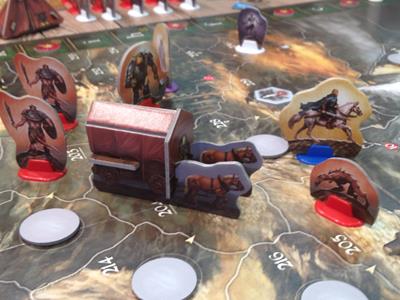
Without spoiling anything storywise, Michael really seems to have succeeded in creating a fitting ending for his wonderful boardgame series. As he is not only the game's designer but also responsible for all the artwork, the game once again comes with rich illustrations which are very nice to look at. The gameboard is once again double sided, the characters look much wiser and battle hardened, and to round things up this new game does not even need a transfer of playing materials from other boxes. In this respect Die Legenden von Andor - Die letzte Hoffnung once again can be played like the first part oft he series, and so it even contains a quick start guide to let players begin quickly.
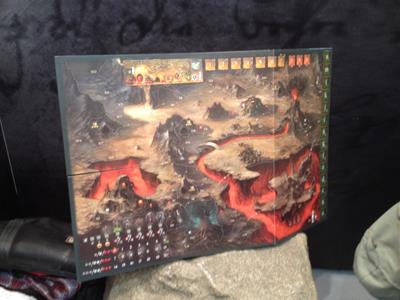
Kudos to Michael Menzel - Legends of Andor for me has become a real milestone in the area of adventure games. Despite dice rolling it requires cooperation and a lot of thinking, and this all is packed together in a very harmonious way!!!
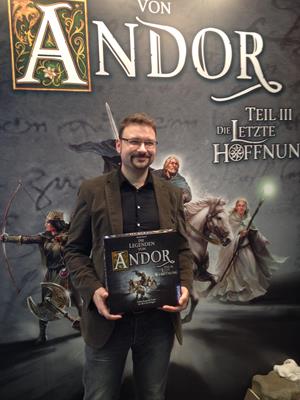
Another designer I met in the novelty show was Roberto die Megglio from ARES GAMES in Italy. Being an absolute fan of their epic game War of the Ring, I took the opportunity to ask Roberto a few things about the future of the game. Here at the SPIEL ARES is presenting the second expansion warriors of Middle Earth. On the one hand Roberto could confirm that there indeed will be a possibility to obtain a painted version of this expansion, but this will come in a few month when the new deluxe games have been shipped. On the other hand, a third and final expansion for the game still is planned as well, and it's the current situation that this expansion may contain a slightly enhanced combat system which may be similar to Battle of the Five Armies or Battles of the Third Age. I have asked Roberto whether there could be a chance that some other great characters from The Lord of the Rings could be included, but he said that it would be difficult to do more unique characters since this would overburden the game. However, I I also suggested that at least some figures could be designed to replace standard leaders included in the game, and Roberto said that this idea about giving the game an optical enhancement hand not yet come up.
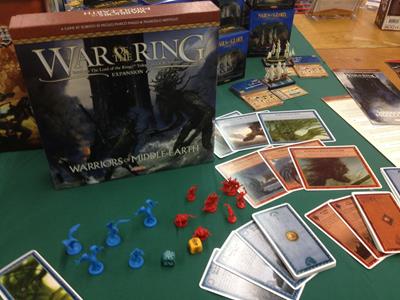
There were really many things to see in discover in the novelty show, but I also met a few friends down there, and a few of their games you will certainly see in the next couple of days in my reports…
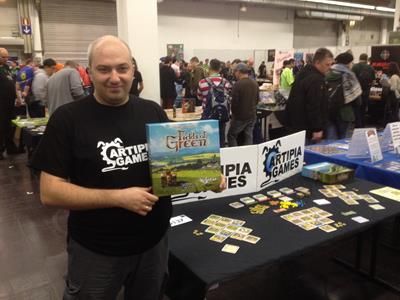
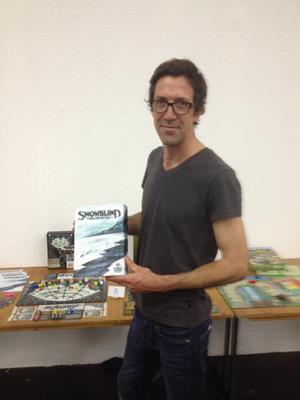
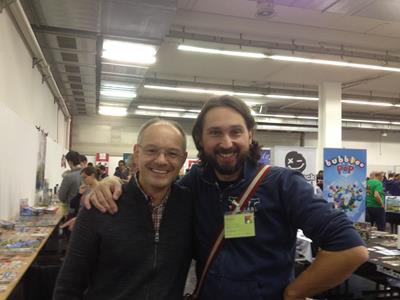
Phew, it's getting late while I am typing these line, and there is still a bit to cover… In the meanwhile let's switch over to Ralf for the first time during this SPIEL! Welcome aboard Ralf!
|
Over the years I have played many, many games and so I hope I have a good noose to identify outstanding games. While Frank is already celebrating the 20th anniversary, I myself came to Kulkmann's G@mebox as a reviewer in 2001. And I am joining him for the daily reports from SPIEL for 8 years. But, born in Essen, living very close to the fair during my school years, I also remember very well the beginning of the SPIEL in the 80s. My father took my sister and me along to the very first convention in the old fair halls (I think the real beginning of SPIEL was at our local community college even some years earlier). Year after year I went there with my family and bought the new winner of the German Game of the Year. The games were called Hase und Igel, Scotland Yard and Barbarossa in those days. Later we also bought a lot of wooden games like Carambole and introduced a family gaming day once a week. I think it was in 1988 when I visited the fair alone for the first time. Well I was not exactly alone, my school friend Frank (bet who it is was already with me). And he convinced me to buy the scenario-based Imperium Romanum II by west end games in that year. A complex strategical game with many details (I think I have read the rules five or six times) and that we actually never played... Later I was attending the SPIEL for finding and talking to my friends of the play-by-mail game The Ashes Of Empire. Then, in 1993, I was moving to Aachen, then to Dublin and back to Aachen again to study and work. As a result my visits at SPIEL became rare. But all the time Frank hold contact and each time we came to see us, we played several games in a row. I still remember never ending matches of Dune (we played day and night at that time). So it is hardly surprising that Frank one day asked me to join him in the reviewing business. And that is how everything has begun. Now, as one gets older, time is getting shorter, the children and the main job demand their time (beyond playing games), but still we try to find time to play and review international boardgames. So, congratulations, Frank, let's go for 20 more years! Speaking of running low in time, let us move on from those old days: This spring we were approached by Zachary Silverzweig, author and (self) publisher of Empires at Sea, his debut game. Zach asked us to test the game and write a review. Both Frank and me had seen the game on Kickstarter and were interested in this matter. So we agreed and it was to me to take the game. Unfortunately, due to some personal issues, I could not find enough time to finish the review over the summer. So I would like to take the chance to present the game today, although the game will not be shown at SPIEL. In fact, the first edition has been sold out and Zach is working on a second edition already. Introduction: Empires at Sea (Self Published)
Empires at Sea is a resource and hand management game with a strategical map where we send our naval fleets to conquer the world. The game is set between 1600 and 1850 and covers the period of colonisation and the great naval battles. Each player takes control of one of the leading nations at this time. With our ships we move over the ocean to trade, establish new ports and of course attack other players and the annoying pirate ships. What makes the game interesting, are the 80 individual captain cards. Each player begins his turn by playing a captain card out of his hand. With these cards you can acquire new and mightier ships (you start with a single transport), build industry to produce more and other resources at the beginning of each round, advance your ships and improve other capabilities as well as play events to carry out a (hopefully good) one time effect. Most of these cards require to pay a resource, so you must find a way to produce these resources or trade them with your ships. For the latter you must navigate to a port that produces that type of resource and pay with a different resource. For the first you have to build industries with the help of your cards.
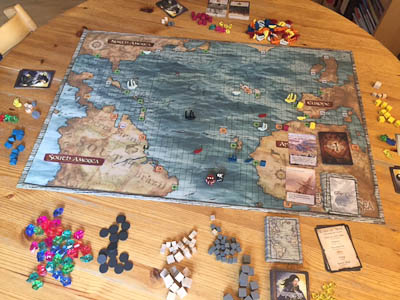 However all our actions and especially the movement of the ships are influenced by the weather and various historical events, both influences drawn at the beginning of each new round. So in some rounds you "fly" over the ocean and in other you even have to hold your ships in the ports, because the miserable weather prevents navigation. 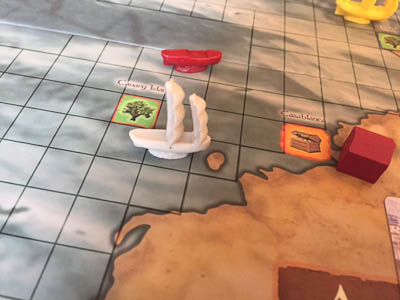 In a turn a player can take up to 5 actions. At the end of the round, all players bribe the pirate with the player who has bribed the most taking control of the pirate ship. Hereby the winne is even able to send the pirate ship to attack other players. Empires at sea offers some interesting choices. Luck plays a major role, but it is up to the players to react. Depending on your hand cards you could try to go more for the industrial or for the military line. But if the weather or the historical events are bad for your strategy, you should be able to adjust it to the current conditions. There are a lot of different cards, all with nice artwork of American history. So every game differs from the one before and a lot of cards have to be discovered. 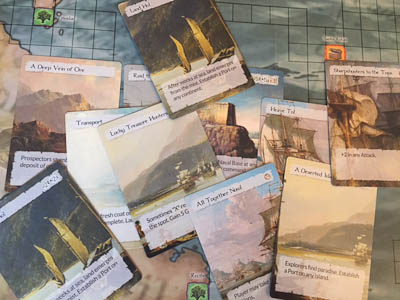 Although the rules are quite easy, Empires at Sea is a gamer's game. With a duration of at least 1,5 hours you should play it with friends who do not calculate every single step up to its end and take too much time thinking about victory conditions. I think it is best, when it is played fast. As I am writing this first introduction during our daily reports from SPIEL, I also have to mention that Empires at Sea is no Euro game, but follows much more the American-style. Here in Essen we will normally be confronted with the Euro style. But if you like this type of games, too , I would say the game should definetly be worth a try-out. Taken all together I think that Empires at sea is a well done debut for Zach and I am already anxious to the changes in the second edition. So that's it for me for today. I will now go and enjoy the dinner at the cerem |
Okay, it's back to me now to cover the final things of the day. After a quick lunch back at home I was back in the halls because I had scheduled a meeting at the booth of LAUTAPELIT.FI for this afternoon. I was waiting for designer Asger Sans Granerud to give me an introduction to his cycle race game Flamme Rouge, but while I was waiting for him to arrive some of the other people at the booth invited me to join in for a quick round of the cardgame Dungeon Rush. I will tell you more about this tomorrow when I will meet its' designer Rustan Hakansson, but already after the first game I have to confess that I was rather smitten by the game (and that's not just because I won…) It's an easy collection game with a bit of a speed element, but this also is coupled with ambidextrous hand coordination which poses a rather unique challenge. Sounds strange? Well, then you better wait until tomorrow…

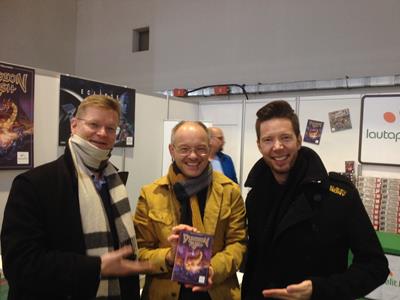
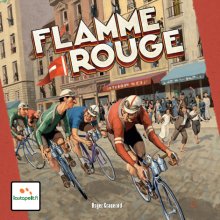
When I re-appearded from the rush into the dungeon, Asger had arrived, and so we directly sat down and mounted up a racing track for Flamme Rouge. While there are not too many games about cycle races on the market, a very successful one has been Um Reifenreite which had won the prestigious Spiel des Jahres awards back at 1992. I liked thatgame, but I had always wished for a more variable track in the game, and this is the first thing Asger's game has done better - it includes a modular track. However, as I had discover during our game, this is not the only point where Flamme Rouge is better, but actually the game comes with a deeper strategic approach.
Each player has two cyclists in his team, one Sprinter and one Rouleur. For each of these cyclists the player possesses a separate deck of Race cards, and these decks are not identical, but instead the Sprinter has many has a few cards in his deck which provide a great lot of movement points, whereas the Rouleur's deck is more balanced in total but without the Sprinter's high amount of movement points.
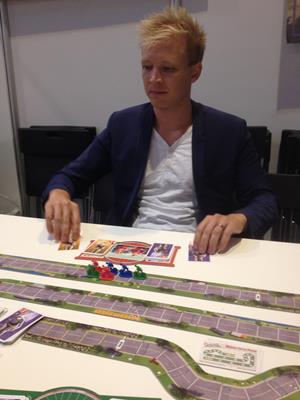
During a turn, each player draws four cards from each deck and assigns one of these four cards to the corresponding cyclists. Then, all the chosen cards will be revealed simultaneously, and beginning with the cyclist in front of the peloton all cyclists will be moved forwards according to the amount of movement points on their card. The rules here are very, keeping the game very dynamic without requiring the players to keep too many aspects in mind. Only one thing is important. If there is only one free space between a cyclist and the cyclist behind him, the trailing cyclist can windshadow and is allowed to move up to the one in front of him. This rule is very important, since several gaps of one space all can be bridged in this way, effectively keeping the peloton together.
All cards used by the players then will be removed from the game, they are out of the race for good. This means that a player who has used his fast cards early in the game will never get them back, and this may prove fatal of the finishing line comes closer. Even more, cyclists who are have no other cyclists in front of themselves are exposed to the wind, and this requires the player to add a generic Exhaustion card with only two movement point to the deck of that cyclist.
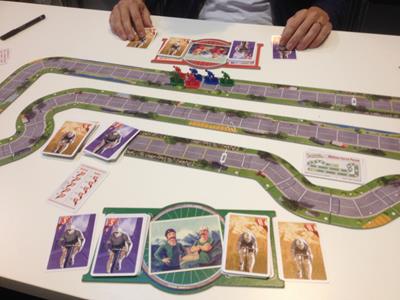
The fact that the decks of both of a player's cyclists are slowly consumed during the game is the decisive factor from which the game draws a high degree of its attractiveness. Of course there is a temptation to the players to use some rather fast cards to get away from the peloton, but this will be to no avail if the maverick than runs out of suitable movement cards. Just like in a real cycling race, the players will have to conserve the strengths of their cyclists, using windshadowing whenever possible in order to keep up with the peloton. And then, when the moment seems right, a series of good Race cards can help to win the day.
Already the first game has drawn me to play again, and indeed Flamme Rouge offers some more elements which can be explored in further games. On the one hand players who are familiar with the game will start to observe the cards played by their opponents, trying to remember how many strong cards especially the other Sprinters still might possess. On the other hand, the track parts can be turned around to show climbs and downhill passages, and each of these has a special impact on the race cards played by a cyclist on such a track.
To sum it up, I think that Asger has created a rather convincing, elegant race game which somehow manages to combine all important elements of a cycle race in a nutshell. Players certainly will be tempted to set up their own racing leagues, and here the modular tracks will help a lot in order to keep the track design and the challenge variable.
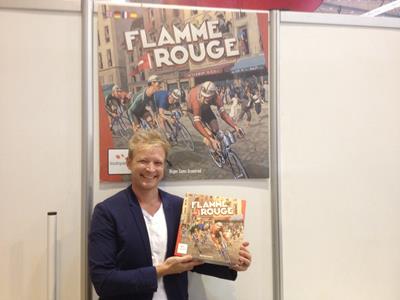
I actually had a bit of time left this afternoon, and so I could do something which I had not been able to do for several years. A bit earlier I have met my friend Nicolas who works at REPOS, and he had asked me whether I had actually read the rules for the new 7 Wonders Duel Pantheon expansion. Indeed I had, and so he had asked me whether we could actually play a game together. We had last done this back at 2012 when Nicolas and Cedrick had been for dinner at my home, and so we took the opportunity of a free hour to meet for a game…
![[SPIEL]](../essen12/ess1230.jpg)
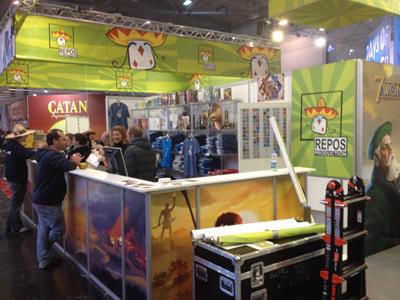
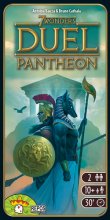
After last year's successful debut of 7 Wonders Duel, the 2-payer spin-off of 7 Wonders, many fans of 7 Wonders had been speculating that this year now might bring another expansion for their favourite game. For several years now there have been rumors about a Seafarer-Expansion, but once again these rumors will not come true this year. Instead, the team of REPOS PRODUCTION has returned to the SPIEL with an expansion for 7 Wonders Duel, and this expansion now will give the players the opportunity to call upon the gods of the Pantheon.
In gaming terms, the Pantheon is a small extra gameboard which is placed directly above the main gameboard, and during the course of the game the players will place different kinds of God cards next to the Pantheon. The placement of the gods happens during Age I of the game, and during the following Ages II and III the players then actually can call upon the gods, activating their powers to gain benefits. But let's look at this step by step.
The setup of the game is basically the same, with the cards being placed in the same fashion as normally during Age I. However, 5 random Mythology tokens will be placed on some of the face down cards, and whenever a player takes one of these cards he must reveal the token in order to see from which Mythology a god will be awoken. The expansion comes with 5 different Mythology decks, and each of these Mythologies does not only have its own thematic background (Greek, Egyptian, Roman, Phonician, Mesopotamian), but the cards of each deck also stand for a certain type of power. So, the Roman gods will focus on military benefits, whereas Egyptian gods may help with wonders etc. One god (card) from the Mythology deck corresponding to the revealed Mythology marker then will be placed at a free slot next to the Pantheon board, and the god card will remain face down until the beginning of Age II.
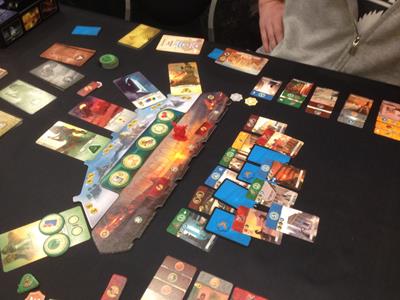
At that point all the gods will be revealed, and from now on the players actually have a fourth option for an action during their turn. Instead of the three classic actions, a player now can make a sacrifice to the god he wants to activate, and the amount of money he needs to pay to make the sacrifice actually is determined by the position of the god in the Pantheon. Both players can make a sacrifice to each god, but the closer the God card is positioned to the capital of a player, the cheaper it will be for that player to activate the god. Thus, a player who draws a God card upon revealing a Mythology marker in Age I will have to think carefully about the slot in the Pantheon where he wants to place the god, since this placement will determine for the rest of the game the price which both players will have to pay for activating this god.
The activation of a god leads to the god card being removed and the gods will bring a player various benefits. As indicated above, the types of benefits stand in line with the mythological background of the deity. Most straightforward is the activation of Mars, because he stands for military prowess and so the activating player will gain 2 Strength in military. The powers of the other gods may be more subtle, but each of the 15 God cards included in this expansion actually has its own unique special power.
The interlinking of the gods of the Pantheon with the mechanisms of the basic game has been done quite well, but the additional playing depth caused by this expansion shouldn't be underestimated. The players now have a full new layer of special powers at their disposal, challenging them to think whether they really should spend money to activate a god, or whether it might be more useful just to stick with a card from the general outlay. Furthermore, only a few games will reveal the different strategic approaches which now become possible, and the value of each God card in the outlay now has to be readjusted because the gods are offering some really nice alternatives.
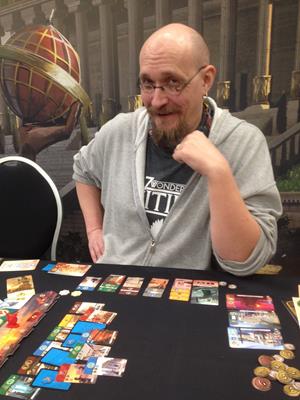
The game I played with Nicolas was incredibly intense. During Age I I acquired several military cards so that I threatened to defeat Nicolas in Age II by building wonders which include military aspects. Here Nicolas reacted very cleverly, calling upon the powers of one Gods in order to steal one of my military wonders and staying barely in the game. He also secured a military card for himself by using a double action wonder, and this considerably weakened my own military position. I shifted over to green scientific cards and the battle for predominance continued in this field, and once again we drew on the powers of the gods to gain some benefits. In the end the game ended by a 48 to 44 points victory for Nicolas, and it really has been a thrilling experience.
I must confess that I have underestimated the potential of the gods when reading the rules, but as this playtesting session showed the gods really increase the strategic angle of the game!
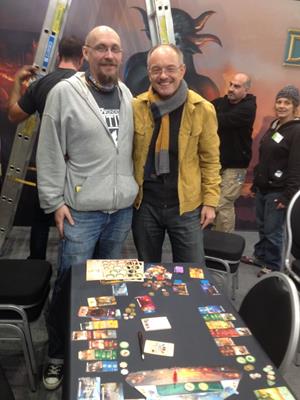
Phew, with this playtesting session recorded, I am finally approaching the final event of the day, the awards ceremony for the Deutscher Spiele Preis 2016. Ralf and I once again had been invited by the MERZ VERLAG to join the event, and together with my friends Dagmar and Ferdinand De Cassan from the Austrian Games Museum we met for the awards. We were lucky to get one of the front tables, and we were actually joined once again by Petr Murmak from CGE and designer Vlaada Chvatil who had been sitting with us on the same occasion a few years before.
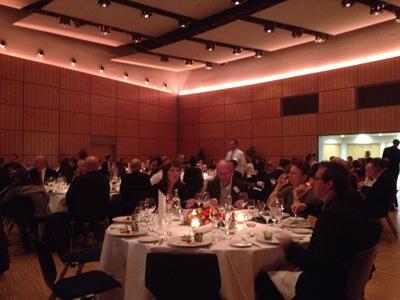
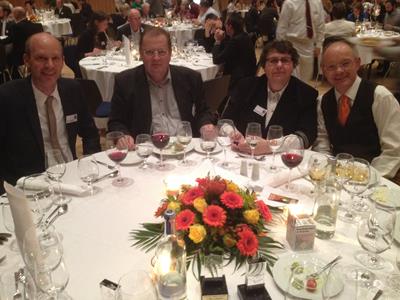
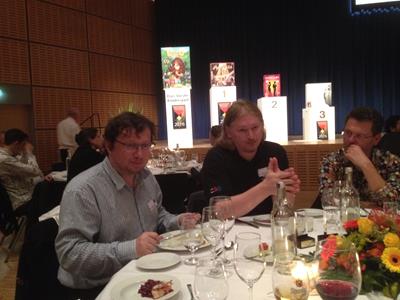
Like in previous years thousands of gaming enthusiasts had voted for their favourite games, and so the first place in this year's awards went to Alexander Pfister's Mombasa, and the third place was awarded to the cooperative time-travelling game T.I.M.E. Stories which challenges the players to solve difficult puzzles in different epochs of history. The second rank in this year's awards actually had been won by Vlaada for his highly successful party game Codenames, and so we gave the the winners a big cheers when they were called upon the platform.
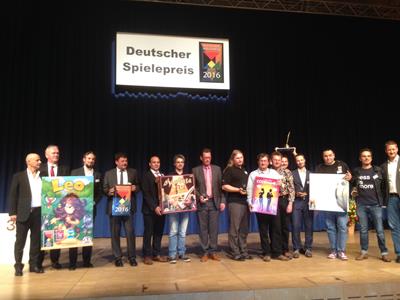
The evening actually ended on a quite emotional not when Dominique Metzler actually called another old friend of mine onto the platform. Knut M. Wolf, long standing editor of Germany's first boardgaming magazine "Pöppelrevue" was receiving a special awards for his lifetime achievement, and indeed Knut really can be named as one of the pioneers of modern boardgaming here in Germany. He began writing about games over 40 years ago, and later he was the first to found and online platform and use the internet to spread the hobby. Last year a serious illness had prevented him from visiting the SPIEL, but this year he could finally come and collect his awards.
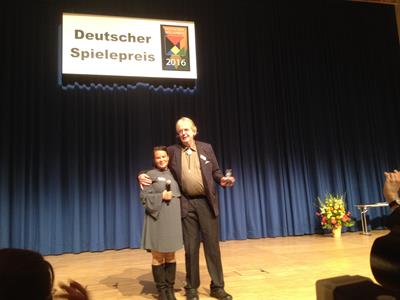
Well, and this really brings me to the end of today's report! It's nearly 2 AM, and tomorrow I need to be fresh again, because the SPIEL will finally open its gates!!!

Game on!!!
SPIEL '16 warmup - Day 3!!!

In my first report on Sunday I have told you a bit about the current refurbishment of the MESSE ESSEN, and indeed the work has begun. The refurbishment is planned to be finished in Fall 2019, so it will still be a few years before the MESSE ESSEN finally shines with its new look. However, at this place it must also be mentioned that the MESSE as a place of events actually dates back over 100 years, and so the first buildings of the Messe were built back in 1913.
My family has been living here at Essen for many generations, and for a long time we have lived in the vicinity of the Messe. For this year's anniversary, I have decided to do something really special, and so I would like to invite you to read about yet another…
Well, at first I planned these Anniversary Specials only to go back for the last 20 years, but yesterday evening I had the idea that one of the specials actually could go back much further, and so I dug up some pictures from very old postcards which are showing the beginning of the MESSE ESSEN. As you might have suspected, at its beginning the fair area looked very different, with much less space for exhibitions. Today all the old halls are long gone, but over all the years there always have been different trade shows of all kinds, ranging from specialized industry products to today's fairs on boardgames, horses or travelling.

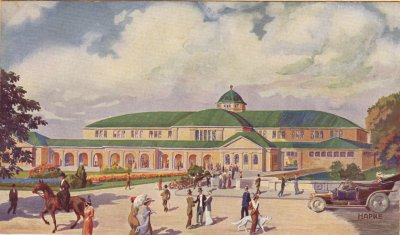
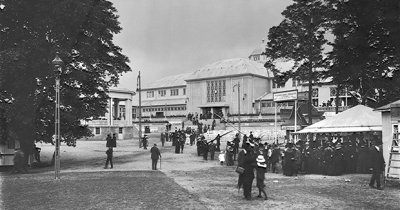

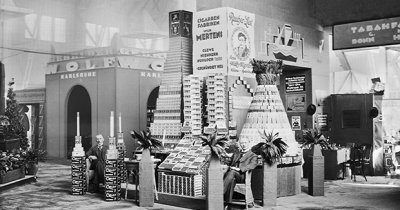
However, some older buildings from these times still can be seen in today's cityscape, and so I was also able to find also an old postcard of my own street, and if you compare it to today's photo you can still recognize the similarities. The street has been renamed, but some of the buildings are still the same.


As indicated, my family had been living here for quite a while, and so I would like to close this trip into history with an old picture of my grandfather. He used to be a dairyman at these old times, and for some decades he even supplied the MESSE ESSEN and the restaurants in the adjacent GRUGAPARK with his products. Behind our house there is still the workshop building where he used to store and clean the old milk cans - I guess the hygiene requirements had been more lenient in those good old days. However, my grandfarther had given up this business long ago, and so today it's all garages…

Talking about my roots and ancestry, this actually is a good opportunity to enrich this year's
Some of you might remember that my Convention Hit of 2013 had been Michiel Hendriks game Legacy - The Testimony of Duke de Crecy. In this game the players have to build their own family tree, adding many different personalities which can offer nice scoring options and interesting special abilities if good matches are made. To celebrate this year's G@mebox Anniversary, my friend Ignacy Trzewikzek from PORTAL GAMES in Poland has offered to create a somewhat odd new character card for the game, and so you will now have a chance to win one of these cards which have been specifically printed for this occasion. So, I proudly present: "Frank the Reviewer"!
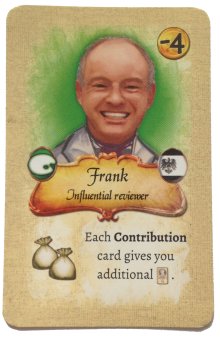
"Thank you Ignacy!" for making this special printrun. I think it's a great and funny contribution to celebrate the occasion!
And how can you win this card? Well, you either Click here to sign the SPIEL Guestbook !
or you try to find me on one of the convention days!!! I will always have a stockpile of these cards with me, and if you like to get one you just need to find me between the other 50.000 visitors each day. However, to make it easier for you, I will actually wear a blue Boardgamegeek-Jersey, Number 96 with "Kulkmann" on the back. So, don't hesitate to ask!
Talking about the team from Boardgamegeek, it's really time to enter the halls, and so, without any further ado, let's have a look how the buildup activities are progressing.
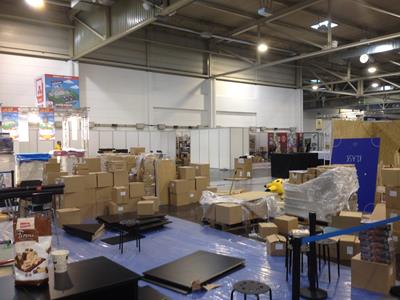
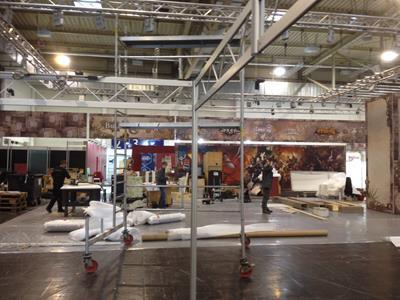

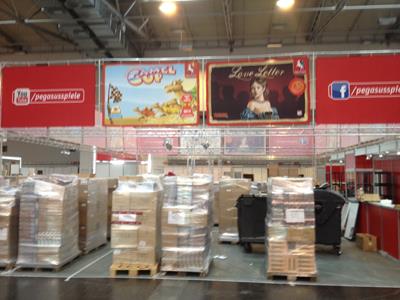
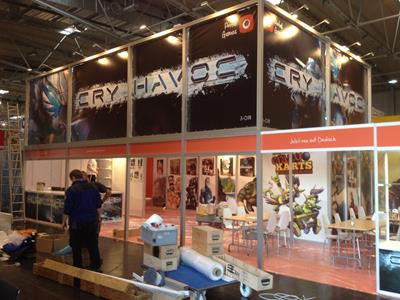
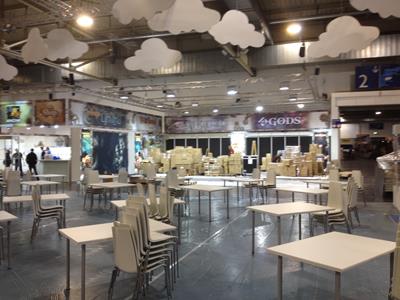
As you can see, buildup is progressing nicely, and tables and pallets with games have started to appear everywhere in the convention halls. As the booths grow nicer, one of the most interesting features are the banners and posters announcing new games, and every year these early visits to the halls have given me some ideas which games I could possibly check out during the next few days. No different today, and here are some of the posters which have caught my interest.
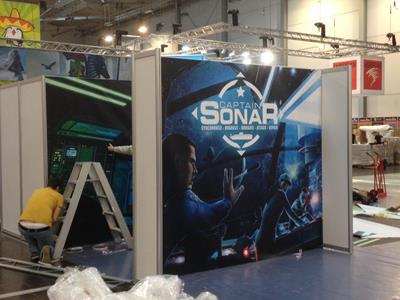

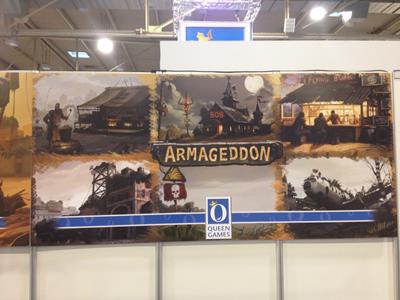
Tonight at home I gathered a few infos on these games, and indeed all three of them will need some investigation during the convention days. MATAGOT's Captain Sonar is a semi cooperative game in which two player teams engage in a submarine battle similar to Hunt for Red October, and Hit Z Road from SPACE COWBOYS indeed is yet another Zombie game, but quite unbelievably is has been designed by grandmaster Martin Wallace. Martin and Zombies - I must see this!
Finally, another trend which seems to get more and more in fashion is post-apocalyptic games. Next year LA BOITE DE JEU will publish Outlive (it's available for demo here at the SPIEL), and this year I received Richard Launius latest feat - Defenders of the Last Stand. As it seems, QUEEN GAMES has recognized a target group of potential gamers for this thematic background, and so they will also join the parade with their newest game Armageddon. The graphics look somewhat cute for such a martial theme, and I am somewhat put off by the fact that the game needs 3 of 4 players, but nonetheless I will try to give it a closer look during the SPIEL.
However, having mentioned that I have received Defenders of the Last Stand some time ago, why not go for a review right away?
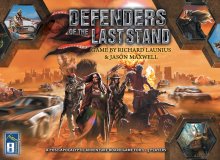
As indicated, the apocalypse once again has been chosen as a background topic for a boardgame, and this time Richard Launius (designer of the modern classic adventure game Arkham Horror) has teamed up with Jason Maxwell from 8TH SUMMIT. As Jason has proved in previous projects, 8TH SUMMIT is dedicated to produce ambitious, richly equipped boardgames with a special focus on a well-implemented story, and so Defenders of the Last Stand presents itself not just with a few tokens, cards and a gameboard, but with a great lot of specially designed miniatures and lots of playing components, requiring an oversized box which would have fit well in the grand old days of the MB Gamemaster Series.
When talking about Defenders of the Last Stand, one of the first questions asked is how it compares to Arkham Horror, and here the most important similarity is the fact that both games are cooperative games in which the players try to defeat some growing evil. In Defenders of the Last Stand the players take the roles of Rangers who defend the city of Last Stand (former Stanfield) against different villains gathering in the surrounding wastelands. So, the scenario actually compares to the setting of the movie Mad Max II, since a colony of survivors finds itself besieged by vicious clans of nomads and creatures who are keen on gaining access to the resources which can be found in Last Stand.
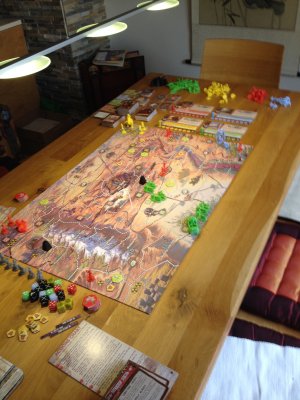
The game engine on which the four different villains and their henchmen (raiders) act is pretty straightforward, since each player ends his turn with the drawing of one or more Raider cards which will instruct for the placement of new raiders and the movement of the four villains towards Last Stand. There are several ways in which the players can lose the game, most of them connected with the raiders/villains getting the upper hand in the siege of Last Stand. So, the game will be lost if a villain manages to move into Last Stand, if there are too many raider' miniatures on the gameboard or at Last Stand, or if too many locations have been overrun by the raiders. It is the task of the players to prevent all these things from happening before they reach their ultimate goal, the defeat of all four villains or an additional scenario specific victory condition.
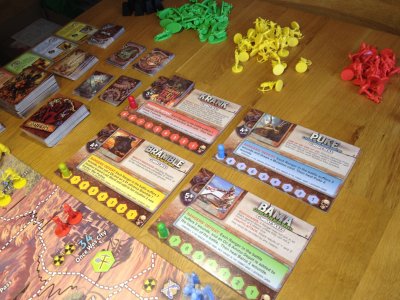
Each of the player's Rangers is represented by its own character board and miniature, and like in many other adventure type boardgames the players may use the actions available to their characters to move on the gameboard, to solve missions, to scavenge for ancient artifacts and - of course - to battle both the raiders and the villains. Each of the characters has a set of four basic attributes (Radiation Resistance, Adventure, Scavenging, Ancient Tech), and throughout the game these attributes will be used quite often in skill checks which determine whether any action has been performed successfully. In effect, these skill checks are triggered in a very traditional way through Adventure cards or other encounters, with the small exception that the value of each attribute is not the threshold value for success, but instead the attribute value will determine the number of dice which the player is allowed to roll in a check for the particular skill. Each "5" or "6" will be considered as a success.
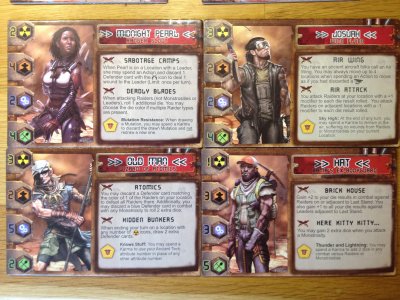
Combat against the raiders is pretty similar, with a player who spends an attack action being allowed to roll a number of dice corresponding in number and colour to the raiders present at the Ranger's current location. For each success rolled, a raider of the associated colour will be removed. Through this action the players try to keep the raiders at bay, because a big group of raider miniatures actually may result in an overrun, causing a Pandemic-like spreading of raiders into adjacent locations.
Of course the players can also gain various types of benefits through acquiring artifacts and other special cards, and during the course of the game the characters may even mutate due to the radiation which can be found at certain locations. Like in every good adventure boardgame, the different characters do not only differ in attribute values, but in addition each character has his own special skills which may allow that character to perform specific actions with more efficiency.
Many of the elements which can be found in Defenders of the Last Stand are no new inventions, but nonetheless Richard Launius has assembled these elements in a way which provides for a very solid cooperative experience. In comparison to Arkham Horror the game first seems to be more complex (not last because of the higher number of different actions available to the players), but this feeling of higher complexity subsides once all players have gained a grip on the rules. At that point Defenders of the Last Stand finally outshines many of its competitors and especially Arkham Horror, since the gameplay does not feature so many fiddly mechanisms which need to be taught to the players if you want to prevent the game owner from becoming "Alpha Player".
The element I really liked in Defenders of the Last Stand is the mechanism of hand management which stands at the center of the player's strategies. The game features a set of Defender cards which the players can obtain through different kinds of actions, and each of these cards belongs to a suit matching the four colours of the villains. If a player wants to challenge a villain to combat, he must discard matching Defender cards in order to gain dice for the attack, and so the players need to collect matching cards in order to prepare for the elimination of the villains. However, the Defender cards also feature action icons, allowing the players special actions like quicker movement, sabotaging (injuring) a villain or even a safe entry to an irradiated location, and so the players face the constant dilemma whether they want to safe the cards for a later attack or whether they want to get the immediate benefits. This brings a nice element of strategy into the game, especially since the players can team up in order to challenge a villain together. In turn, this results in a high need for coordinated actions, keeping the players under constant pressure to succeed in their actions in order not to endanger the whole defense of Last Stand.
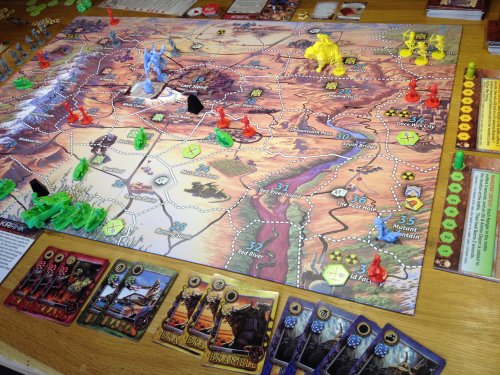
For my mind Defenders of the Last Stand easily is the best post-apocalyptic boardgame on the market. This setting either will attract or push off certain groups of players, but if you give in and try the game you will quickly discover that Richard Launius has done a good job, giving the game an epic scale but keeping the volume of rules manageable and the game flow smooth. The element of rolling dice for skill checks certainly seems a bit outmoded, but since the players have numerous possibilities to optimize the effectiveness of their actions the skill checks blend in quite well with the rest of the game. In the long run Defenders of the Last Stand for me seems to have a higher replayability than Arkham Horror, both because of the more straightforward rules and the additional possibility to play different types of missions, but in the end this is a matter of personal taste.
Returning once again to the halls, my next stop was the booth of BOARDGAMEGEEK, and here I met Scott Alden and his crew who were setting up their video broadcasting system in order to broadcast the annual Geekbuzz directly from the convention. Being a writer through and through, it's interesting for me to see how many video reviewers and podcasters have appeared over the years, but looking at all the feedback I am getting it seems that there is still enough room for normal written reviews and this convention blog. So, don't worry, there will always be a next SPIEL here at the G@mebox!
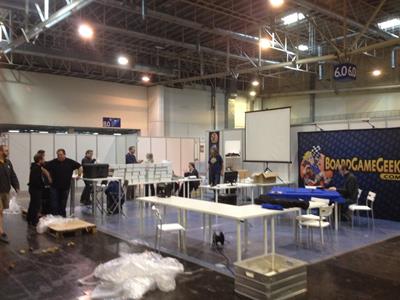
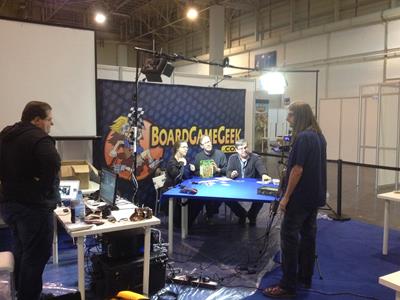
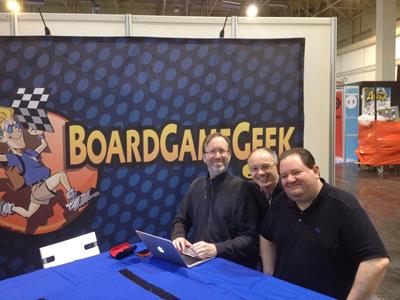
The visit to the BGG booth actually brought up some memories from buildup for the SPIEL '13, and so it's time for another
Back in 2013 the BGG team was facing a big problem during buildup. Arriving late, they had to discover that all the electrical sockets at their booth were dead. This was a great mishap because the electronic gear needed to be configured and tested, and Aldie told me that they had filed all necessary application forms to get energy that day, but as it seemed this had been to no avail. Electricity was available from sockets on the halls outer walls, but unfortunately this was about 30 meters away and no other exhibitor could spare such a long extension cable. With the shops closed, I hastened home to get one of my farther's old cable reels, and after a bit of searching in the garage I found one with a cable which was long enough. Back in the halls the cable was instantly mounted, and so Aldie and the others could continue setting. However, being the "Light Bearer" meant that Aldie promoted me to the rank of "Honorary Geek", and so I finally got one of those cool BGG-jerseys…
![[SPIEL]](../essen13/ess13026.jpg)
![[SPIEL]](../essen13/ess13027.jpg)
However, returning to present day, once again there was something amiss, and Aldie was looking for help in order to get several needed pieces of equipment. Having my car just round the corner in front of my house, I went on a goose-chase with Doug in order to hunt for some stationery, cable ties and other items which had gone amiss somehow, and an hour later we returned after having found all the required stuff. As you can see, titles come with high responsibilities!
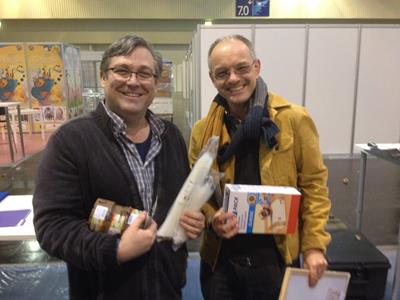
One thing I really like about convention tuesdays is the fact that friends from all over the world start to arrive, and after setting up their booths there is actually so time to chat, something which is often missing during the hustle and bustle of the normal convention days. So, I went in search of some familiar faces, and at Hall 7 I actually met my friends Percy Chan (designer of Magecraft) and Jerry Wong (Manager of SMOOTHIE GAMES) from Hong Kong. Last year they had arrived quite late and had to set up their booth on the first public day, but this year they had done better and we could actually have a chat about gaming and living in Hong Kong. As I have to acknowledge, life and circumstaces can be very different on the other side of the globe, and even though Jerry's company still designs normal boardgames it is not only difficult to market them in Hong Kong, but actually playing them comes with difficulties of its own. The housing market at Hong Kong is rather overheated, resulting in a family having to pay approx. 2000 Euros a month of a 40 square meters flat. Such a restricted space for a whole family comes with a lot of problems of its own, and one of them is the simple fact that there usually is not enough space to set up normal sized games with a big gameboard. And on the other hand, the need to create a high income is very demanding in terms of working time, so people over there have to do lots of overtime in order to gain a high income, but this in turn means there is even less room for leasure activities. Under such circumstances both of my friends really must be gaming enthusiasts, since otherwise their affiliation for boardgames would be difficult to keep alive.

The next group I was coming to was the team of TAIWANESE BOARDGAME DESIGN (TBD), and here I met David LIU, manager of MOAIDEAS GAME DESIGN. Last year David's company has successfully released Guns & Steel, a quite aggressive cardgame on civilizatory and military developments, and this year he is actually brining along a few boxes of Guns & Steel: Renaissance, a new standalone game which can also be combined with the former game. Guns & Steel actually is going to be published in Germany by PEGASUS (so much about the SPIEL being a market to negotiate licenses), and David even has brought yet another Civilization-type game to the SPIEL: The Flow of History.
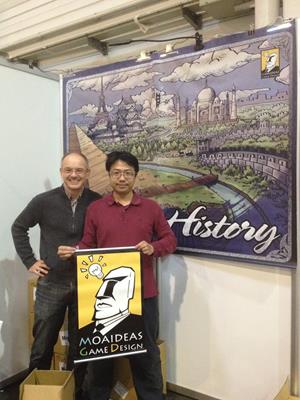
To celebrate both the successful licensing of Guns & Steel and the 20th Anniversary of the G@mebox, David has donated one copy of The Flow of History for the Prize Draw. So, you better go and Sign the SPIEL Guestbook !
After this nice afternoon I headed home to start typing, but in Hall 1 I actually bumped into another group of friends who was setting up their booth. Having arrived from Athens just a few hours ago, Konstantinos Kokkinis and the rest of his team from ARTIPIA GAMES will present Fields of Green here at the SPIEL, a drafting game which is themed on running a farm. I have scheduled a meeting with designer Vangelis Bagiartakis on Thursday, so you will have to wait a bit longer until I can tell you something on this game.
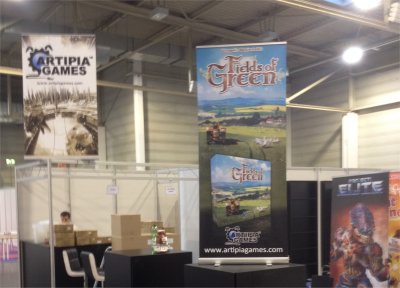
However, taking time for a chat with Konstantinos I was very happy to hear that ARTIPIA GAMES is getting along despite the difficult economic situation at Greece, and even though the hobby of boardgaming isn't as far-spread in Greece as in some other countries, the games released by Konstantinos seem to develop a slowly growing audience of devoted fans.
![[SPIEL]](../essen11/ess1135.jpg)
So, I guess that this is a good point to end today's report. Tomorrow the waiting will be over, it's the first official day with the Press Conference in the Morning and the Deutscher Spiele Preis Awards Ceremony in the evening. So, dinner is waiting! (I know - Germans and food…)
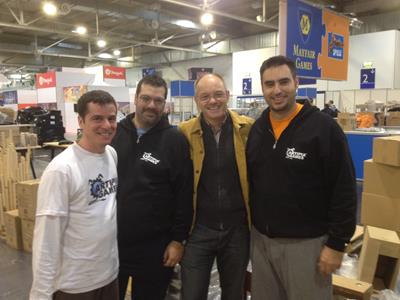
Game on!!!


Today I actually had to visit the tax office one more time, but now I am finally off to the convention week! And of course, this afternoon I was able to sneak into the convention area, getting a first glimpse of the buildup activities like in past years.

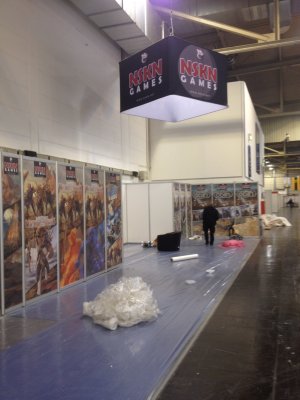
One observation was really striking when I entered the halls - in some halls there were much more activities than in previous years, and even some of the small publishers are arriving quite early this year in order to avoid the frantic booth buildup on tuesday or even wednesday. During my stroll through the halls I met Iraklis Grous, manager of LUDICREATIONS from Finland, and he told me that he had already visited the halls during the weekend. At that time the big publishers in Hall 3 had already begun to build their booths, and so it was no wonder that once again things in Hall 3 had progressed very far.
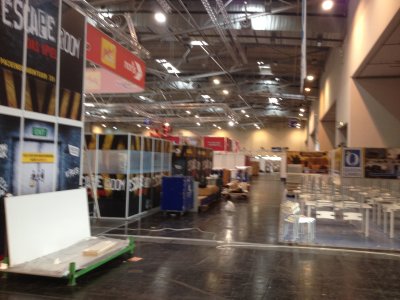
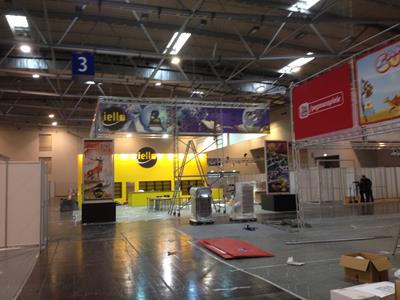

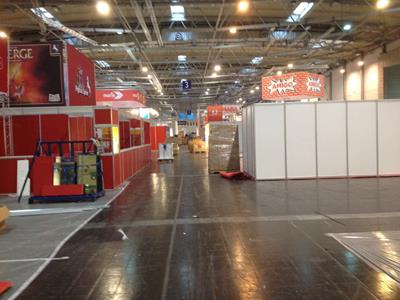
However, before we delve deeper into the halls, why not get into gaming mood with the first review of the convention week? So, here we go!
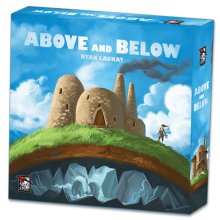
Games with a paragraph booklet? Well, at least some of my readers may remember the time when STEVE JACKSON GAMES successfully published the Fighting Fantasy single player roleplay books in which the reader had to successfully navigate a hero or even a spaceship crew through an adventure. Of course there was some fighting and skill checks involved, using dice like in any traditional RPG, but most remarkable was the fact that the player/reader constantly had to make decisions, asking him to turn to different paragraphs of the book based on the decision he has made. On a sidenote, these books could be very frustrating since sometimes a deadly trap was triggered just by turning into the wrong corridor, but in the end it was part of the fun to try and try again to solve the adventure, since the players were not supposed to get through the book in their first runs.
Today this system of gaming books has been fully replaced by all kinds of electronic games, but from a gamer's perspective there remains a use for such adventure books which has not been explored very often: what about combining a traditional boardgame with a paragraph booklet, thus giving the players the possibility to go through different types of adventures in every new round? Back in 1985 (!!!) this approach has been chosen by designers Brad Freeman, Eric Goldberg, Doug Kaufman,Kevin Maroney and Ken Rolston for their all-time classic Tales of the Arabian Knights, an adventure game which leads the players into the enchanted world of 1001 Nights, including a paragraph booklet with hundreds of paragraphs containing different stories. The game had been a behemoth, both in terms of playing duration and rules, since the players could not only go for character development ("simple game"), but they could actually engage in trading activities as well, and so the management of all developments and player abilities turned out to be quite demanding.
To my knowledge, this approach has not been followed much further, apart perhaps from a few specialist games like the VICTORY GAMES series of Ambush! wargames which used paragraph booklets in order to create challenging single-player scenarios. However, in 2015 not one but two independent game publishers decided to try the combination of a boardgame with a paragraph booklet. One of these games is the espionage game Agents of Smersh from 8TH SUMMIT, but the game of which I would like to talk today is Ryan Laukat's Above and Below which he has published under his own label RED RAVEN GAMES.
Above and Below takes place in a fantasy world, and each of the players manages a small village with a few villagers. Below the villages a vast underworld network of caves has been discovered, and during the course of the game the players can send their villagers into these caves and to experience many kinds of adventures. These adventures can be found in the game's Encounter book, and a mechanism of cards and a diceroll is used to determine which paragraph will be read to a player who has sent his villagers into the cave.
Unlike the Fighting Fantasy adventure books, these adventures are pretty straightforward, often consisting of only a single paragraph which gives the players some options to make a decision. This decision is often connected with a test (diceroll) on the Explore ability of the villagers visiting the cave, and the paragraph then will list the benefits which can be gained if the test is completed successfully. At first hand this very streamlined resolution of the adventures might be a bit surprising for players who have hoped for a deeper story element, but on the other hand it must be kept in mind that the adventures in Above and Below are only part of a playing mechanism which combines several other elements.
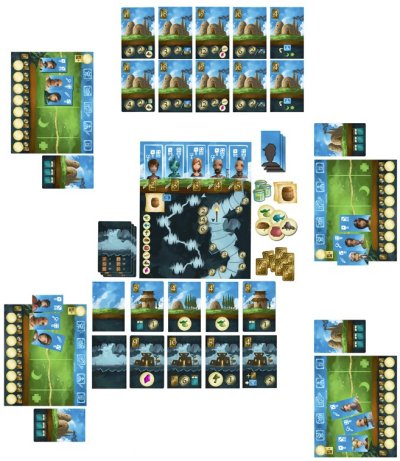
So, it is the player's task to expand their villages by new, useful buildings - both above and below the surface. New buildings cost money, and in addition a player also needs to spend an action of a properly qualified villager who will consequently not be available for any other action during this round. As indicated, all buildings which can be built above and below ground offer special abilities like space for additional villagers or capacities for producing resources, but especially the buildings which can be constructed in the caves, the Outposts, will give access to some rare kinds of resources. However, whereas space on the surface is unlimited, each Outpost needs its own building space in the caves, and these spaces only can be gained by sending some villagers for a cave adventure: no effort, no gain!
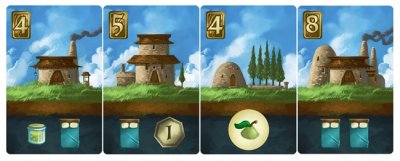
The game features a total of 8 different types of resources which the players can gain both through buildings and successful cave adventures, and these resources are connected with a quite interesting in-game economy. With each different type of resources the player adds to his stocks his per-round income will increase, but in addition each resource token in stock also will be converted into victory points at the end of the game. Here the resources which have been stocked early offer a lower value than resources which are stocked later in the game, and due to different rarities of all resources the players have to balance the early stocking of a common good (income increase) against a late stocking, because a late stocking may give the player a high amount of victory points if he manages to stock several tokens of this good. Here once again the buildings in a player's possession also allow for all kinds of nice combinations, since some buildings may increase the income even further for specific goods, whereas other buildings may provide additional victory points for each goods token of a specific type.
Returning once more to the villagers, the use of the players' villagers is the central part of the player's actions, since all types of actions like cave exploration, building, harvesting or the training of new villagers need the activation of one or more villagers. When activated, the villagers will be exhausted for the rest of the round, and only at the end of the round the players can reactivate as many villagers as they have beds in their buildings. If a test during a cave exploration is a tight call, the active player even may choose to exert one or more of the villagers he has sent during the cave, gaining more successes for the test but injuring all exerted villagers. Such a villager actually needs two rounds to recover, but this can be sped up by a player possessing Healing Potions which can be acquired during the game.

Due to the interwoven scoring options and mechanisms Above and Below challenges the players to try out different strategies. So, a player may certainly try to become the world's most successful adventurer, sending his villagers deeper than any villager has gone before. The successful completion of adventures may yield nice benefits (money and resources), and in addition victory points also are collected for gaining reputation as a successful explorer. On the other hand, a player also may try to be successful as a petty mayor, focusing first on resources which can be gained above ground and daring the caves only under absolutely unavoidable circumstances. Due to the different possibilities to score victory points many interesting combinations can be tried, and the availability of nicely varied scoring options has become something like a trademark for Ryan Laukat, since many of his games like City of Iron or Islebound contain diversified scoring options. This gives Ryan's games a very high replayability, and in case of Above and Below the replayability goes even further due to the many different adventures which can be found in the Encounter book. As indicated earlier, in the light of many straightforward adventures some players may have wished for deeper storytelling elements, but from my perspective Above and Below really shines due to the successful combination of storytelling with an interesting in-game economy!
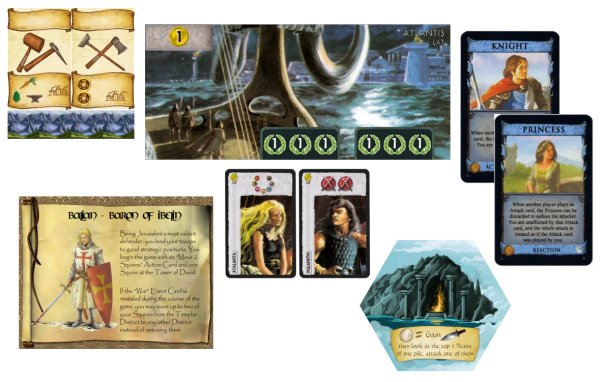
Talking about Above and Below, we are actually closing in on a special convention highlight. One of the nice things visiting the SPIEL is the fact that a visitor has the possibility to gather many promos and other goodies for his favourite games, and this year will be no different since a number of publishers has already revealed the extras they will bring along. So, if you are interested in this year's choice of promos, check out the Goodies and Promos List at Boardgamegeek.com. A special "Thanks" at this place to G@mebox reader Louise McCully from New Zealand for putting up this helpful list!
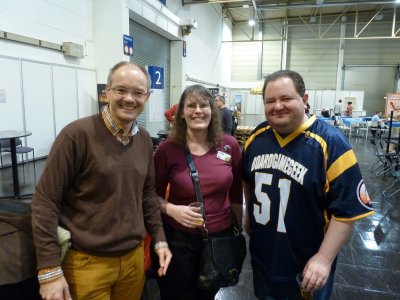
Hi Louise - enjoy your "Armchair Essen" here at the G@mebox!
In previous years I have tried to provide downloadable promos for those of you who have not been able to attend the show. I have done a few of those myself, but over the last few years Ryan Laukat, designer of Above and Below and many other games published under his label RED RAVEN GAMES, has provided some great contributions to my efforts to provide downloadable expansions. Our cooperation started back in 2011, and some of you might still remember the story…
Back in 2011 I discovered Ryan's Kickstarter project for his first game Empires of the Void. I was instantly taken by Ryan's skills as an artist, and the game itself promised to be a nice space conquest game a la Twilight Empires. However, I also discovered that Ryan had sponsored one copy of the game for the 2011 charity auction of the Jack Vasel Memorial Fund, and the specialty of the copy of Empires of the Void offered for auction there was the fact that the winning bidder would not only receive a copy of the game, but also be allowed to design a new race for the game. Ryan had promised that he would draw a fitting picture for this race and create a player tableau which would then be available for download for all players, and for me this offer meant an irresistible temptation, since I always loved to create mini-expansions for boardgames. So, being located in Germany I ended up booting my computer at 5:30 AM on a monday morning, since the bidding phase for all auctions was ending at 12:00 PM Eastern time. Fighting a bid-sniper-duel with another bidder in the last minute of the auction, the game secured a great contribution to the Jack Vasel Fund, and I ended up designing a new race for the game together with Ryan. This race, The Sirens of Belshar, was Ryan's first contribution to my SPIEL reports back in 2012.
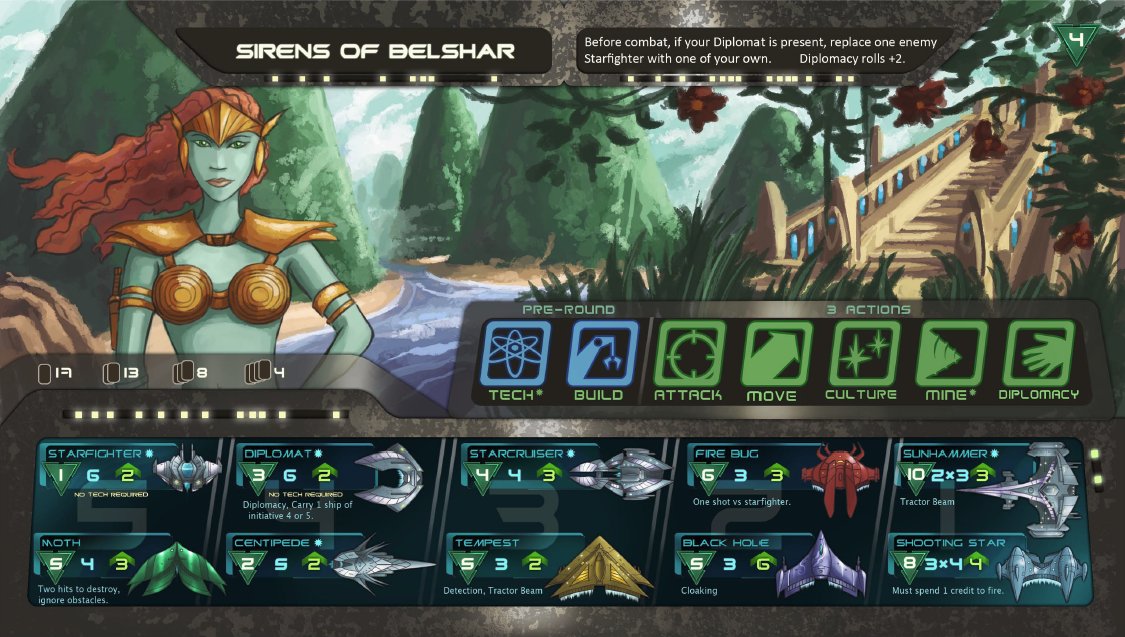
However, due to the 20th Anniversary of the G@mebox, Ryan has promised something really special this year, and so I am very proud to present the first item in this year's
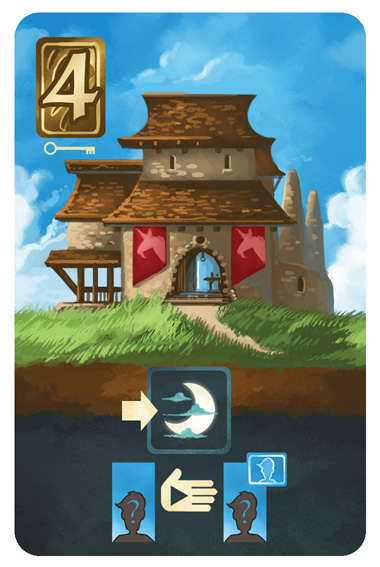
It's a new building to be used in Above and Below, and Ryan has actually sponsored a bunch of these cards to be printed and raffled off in this prize draw. However, it's not just any card. Let's give it a closer examination…
You all know that Doris Matthäus' drawing of an unicorn is the banner-head of the G@mebox main page, don't you?
![[Unicorn]](../../../technik/headpage/unihead.gif)
Well, now check out the banners on the building, and you will discover the specialty of this card!
"Thank you Ryan!" for this great gift! It's a wonderful contribution to celebrate the 20th Anniversary!
And returning to today's visit to the halls, LUDICREATIONS actually sponsored two of their newest games for the Prize Draw as well, so you will also have a chance to win Mythe and They who were 8!
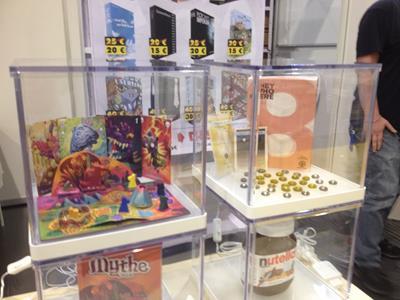
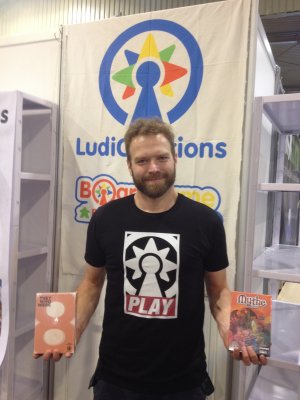
To win something, just do it the same way as every year: Click here to sign the SPIEL Guestbook !
Iraklis Grous also has told me that the Merz-Verlag who is organizing the convention actually is introducing something new this year. In the last few years the novelty show which is reserved for the press has vastly outgrown the available rooms, and for that reason they now will actually make a much bigger novelty show in Hall 1A. Wait a moment, Hall 1A? I have never heard of this one, and indeed I had to find my way down into the catacombs of MESSE ESSEN in order to find this fabled subterranean Hall 1 A. I didn't even know that a whole hall below the ground existed - so much about above and below…


After this excursion into the Messe-dungeon, I returned not only to the surface level, but I visited the more remote Halls in order to see whether the SPIEL once again had grown. Upon climbing the stairs in Hall 7 it first looked like the SPIEL had shrunken because the hall was not fully used like last year, but this has been a false conclusion as I had to discover in the next halls. Not only Hall 4 had been fully added to this year's convention area, but also part of Hall 6, and so I couldn't help to observe that the SPIEL once again will see a surge of more booths and exhibitors.


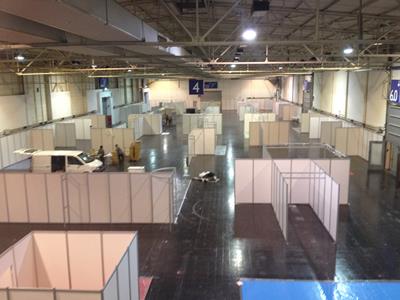
On the one hand this certainly is a nice fact, showing that the games sector is healthy and growing. However, looking at Eric Martin's SPIEL Preview at Boardgamegeek, 766 new games have been announced to be released at this year's SPIEL, and I cannot help but feel a bit scared by the sheer masses of games which are published each year. 20 years ago I actually succeeded in covering all major new releases from the SPIEL, but these times are long past and today Ralf and I only can present a handful of chosen games to you.
So, what is actually the half-value period of a new game? If you visit the booth of one of the major publishing houses like HEIDELBERGER during the convention, you will discover that the games from the last two or three years now will be sold at incredibly low prices, and the question comes up whether many nicely designed boardgames actually get lost on an overcrowded market. Well, the surge of publishing houses here at the SPIEL may suggest that the publishers do fine despite the flood of new games, but nonetheless it makes me a bit pensive to think that you could get enough games for a lifetime by just one visit to the SPIEL. Just like I said yesterday, I like playing some older games as well, but it is getting more and more difficult to choose which games to keep if you want to keep your collection small. After all, playing time and space is limited…
I finally returned to Hall 3, and here I found my friend Cedrick Caumont and his team busy setting up the booth of REPOS PRODUCTION. Every year I cannot help but wonder how much REPOS has grown since their first visit to the SPIEL 05…
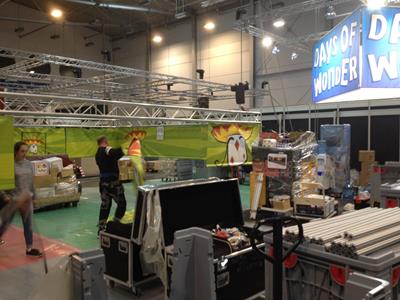
Well, the title of this Anniversary Special may be a bit overemphasized, but nonetheless the story of REPOS PRODUCTION is an amazing example how a small company run by a few friends actually can develop into a huge publishing house. Back in 2005 REPOS PRODUCTION had a normal sized small booth in remote Hall 4, and they presented their highly interactive robbers shootout game Cash'n Gun$. They had only one table which allowed space for up to six players, and in 2005 Cash'n Gun$ had been my Convention Hit because of the rather funny moments which the whole group of players could experience during the game.
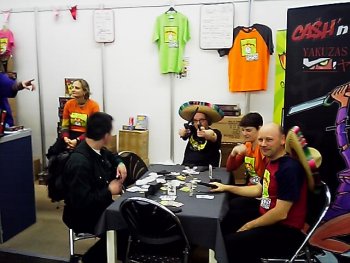
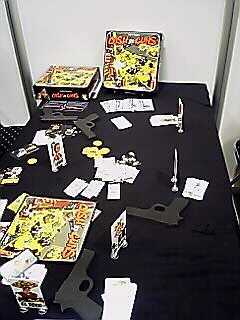
At that point I had hoped that my Belgian friends Cedrick and Thomas would show a lucky hand with their following games, and indeed the year 2010 turned out to be their big jackpot. Teaming up with designer Antoine Bauza to produce a civilizatory-themed game, REPOS PRODUCTION released 7 Wonders, a fast-paced innovative cardgame which has put hundreds of thousands gaming enthusiasts under its spell. The value and uniqueness of this game became manifest in 2011 when 7 Wonders won a great number of awards, including all the major awards like the Deutscher Spiele Preis, the International Gamers Awards and the Kennerspiel des Jahres.
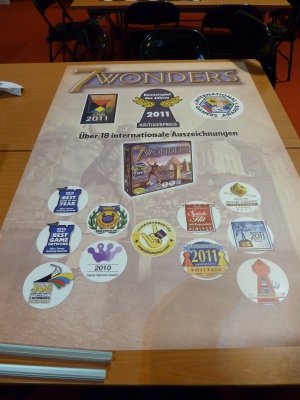
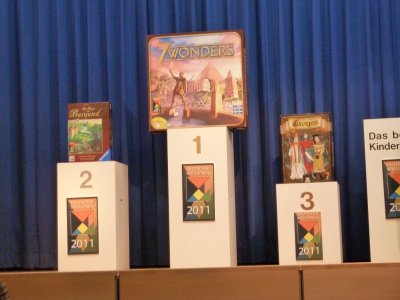
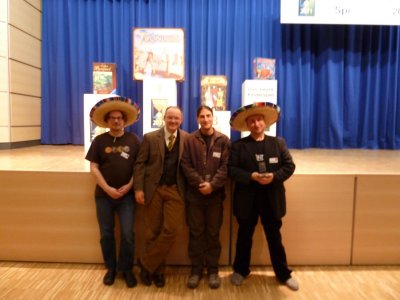
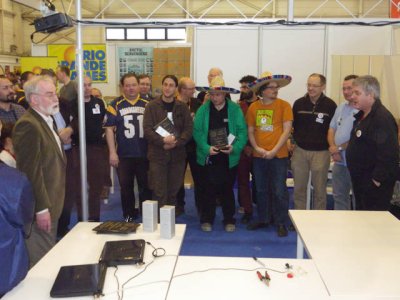
The tailwind for REPOS PRODUCTION from these awards has been just amazing, and today they still supplement their line of 7 Wonders with very successful expansions and spin-off games. Cedrick and Thomas now have to use the convention for promoting their business and making agreements about licenses etc., but I will always remember the day back in 2005 when we all sat at their booth's one table for a round of Cash'n Gun$.

Well done guys!!!
Game on!
3...
2...
1...
Lights on, Camera ready, Micro open...
"Full SPIEL ahead!"
Folks, here is Essen, the boardgaming capital of Germany !

Welcome back for another year of boardgame reporting from the SPIEL convention, but this year something special is going on! Have you ever checked the dates at the headline? Yes, this website started 20 years ago, and so I am very proud to welcome you to
For me it is amazing to see that 20 years have passed since I started reviewing games, and I wonder a bit where all this time has gone. Together with my co-reviewers Ralf, Doug and Marco I have published nearly 1000 reviews, and over the 20 years I have covered nearly every SPIEL convention here at my hometown Essen. Only 1999 was an exception, but at that time I have studied at Newcastle for a year and couldn't make the trip. Scanning through my guestbook, I have seen that some of you have followed my reports here from the show for the last two decades, and I am happy to see that you find your way back here each year to follow my steps through the convention.
However, much has changed, and when I started the G@mebox 20 years ago I was running on a very tight server restriction with AOL. My website has grown and my reporting style has changed considerably (although I still do only use two fingers for typing). If you want to remember all the previous shows, do not miss the links at the end of this page which bring you backwards to all the previous reports! Thanks for staying with me for so long, and if you want to see how my page looked at the beginning, take your personal timewarp with Kulkmann's G@mebox in the WAYBACK-MACHINE !
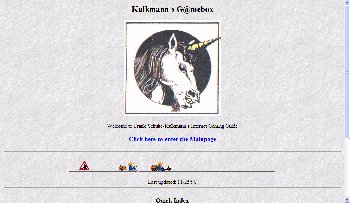
In the last few years my reports always started with a tour into the surroundings of Essen, telling you a bit more about the city and the country. However, with this year's anniversary things are a bit different, and so I took the time to go through all my previous reports to look for stories and oddities which have been lost in the depths of time. I have chosen a handful of these to bring them up again, giving you a revival to of 20 years of SPIEL reporting! So, look out for the G@mebox Anniversary Specials!!!
However, a few photos of the current surroundings of the convention actually are needed this year. Returning visitors will be aware that the SPIEL now is located in a different area of the convention halls than when it started, and a few years ago I have told you that the move actually was due because the MESSE ESSEN was planning a major refurbishment with several new buildings. After some years of disputes between the MESSE and the City of Essen this operation now finally has begun, and the old entrance buildings and several halls now have been partly demolished to allow for new buildings - much more modern with lots of light etc. However, as you can see on the photos below, it will still take a bit before the new buildings actually can be used…





After this look at the present situation at the MESSE ESSN, let's now turn towards the first
For today I actually thought it might be a good start to dig up all previous winners of my Convention Hit awards. I have not started giving this awards back in 1996 but a bit later, so the collection shown below does not show games from all convention years. However, looking at this collection of games from today's point of view, I must confess that I am still happy with most of the choices I have made. Even though I tend to keep my games collection relatively small, nearly all of these games are still in my collection, with the exception of The Circle which I had passed on to a friend.
Judging these games from a modern standard, a game like King of Chicago with lots of dice rolling may feel a bit outmoded today, but on the other hand my list of convention hits also contains a real all-time classic with War of the Ring. All in all, these games still can keep up with many of the new games which are released each year, and I love to get them onto the table now and then. This always feels a bit like an old friend is returning…
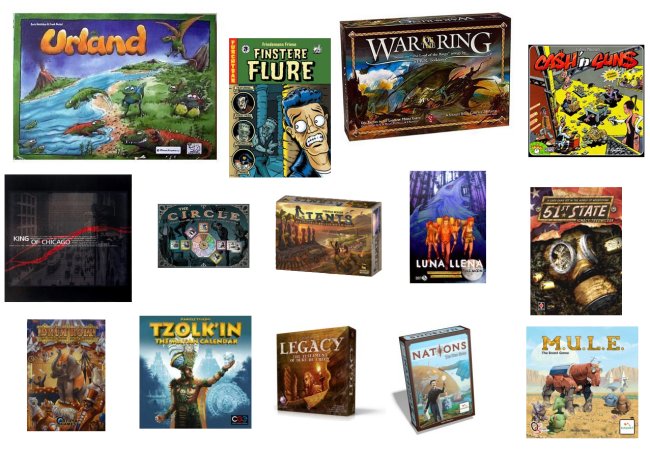
Looking at story and atmosphere, a game which still fascinates a lot of players in my gaming groups is Full Moon - Luna Llena by Servando Carballar. Indeed, the rules can be called sub-standard because they are difficult to read (but complete!), and some of the playing material is a bit fiddly, but on the other hand the game never fails to impress players with an astonishing playing atmosphere a la "Blair Witch Project". The story of the youths getting lost in the forest and falling prey to a bunch of Werewolves leaves no player cold, and so this game remains a real evergreen in my collection.
Finstere Flure by Friedemann Friese is another game which remains in high demand. The game is one of the oldest in this group of Convention Hit winners, but nonetheless it still doesn't fail to entertain the players. It plays much quicker than many of the other games shown here, but the frantic flight from the castle's dungeon and the escape from the duke's monstrosity still is good for a lot of laughter!
However, while we are at it, let's just continue with two more events which have been quite important milestones for me and the website. So, back in 2008 I had to discover that the SPIEL convention had outgrown all my efforts still to master my daily reports alone, and so - after discussing this for some years - I was joined by my old school friend Ralf Togler for the first time in this year. Ralf had been a reviewer for the gamebox much longer, but in 2008 he had moved back to Essen, and now he could actually join the fray, doing his own meetings and writing parts of the daily reports. Ever since that time Ralf's contributions had grown and grown, and a few years back he even had to take over for several days when I have been on a job assignment and could return only for the weekend. Together we still march on, despite the growing craziness on the games market with hundreds of games released each year, and of course Ralf also will be back this year to do his part of the reports!

Apart from Ralf another big contributor of reviews for the G@mebox is my friend Doug Adams from Australia. Looking at some very old emails, I discovered that we had first met at a newsgroup back in 1996 (yes, I found that I still have emails from that time), and at this newsgroup I had actually offered German games in trade for miniatures for GAMES WORKSHOP's Talisman boardgame. From an the initial trade a lasting friendship developed, and in 2005 I actually met Doug for the first and only time when he came all the way to Essen to make a visit to the SPIEL.
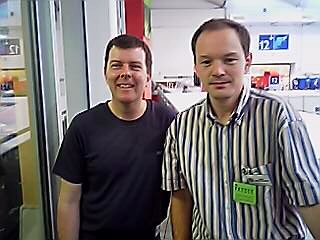
And of course such a rare opportunity to meet needed to be recorded for all eternity, and so you will see here the only photo of the active G@mebox team: Doug, Ralf and me!!!
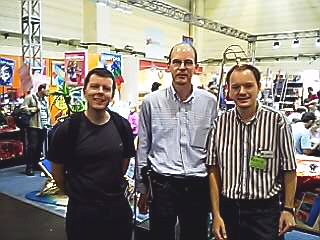
You can also go by train to Essen Central Station. If arriving there, go to the basement and take the Subway U11 directly to the Messe Essen.
If you want to arrange lodging at Essen, you best contact the Essen-tourism-center by phone 0049/(0)201/19433 or 0049/(0)201/88720-46 or -48. Perhaps they know where some Hotel-rooms are left...
If you travel to Essen by car, please notice that Germany restricts access to many cities (including Essen) for older cars. While the convention area does not fall under these environmental restrictions if you follow a specific route, you might want to check out the route details at the official Messe Essen website. An even better alternative (especially for those of you having a hotel in Essen) would be the acquiring of an Envirnomental Badge which can be ordered at the offical website of the German Technical Inspection Authority.
If you want to have a look at my coverage of previous conventions, follow these links. But you should bring along some time, especially of you want to read the younger reports...
|
| ||

|
|

|
|
| ||
|
Kulkmann@aol.com
Copyright © 2015 Frank Schulte-Kulkmann, Essen, Germany | ||